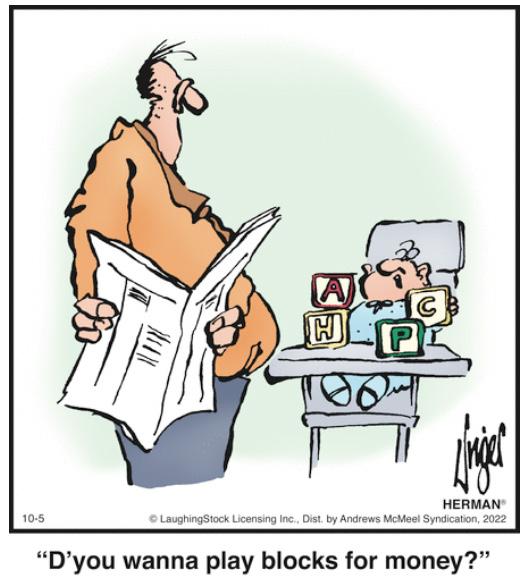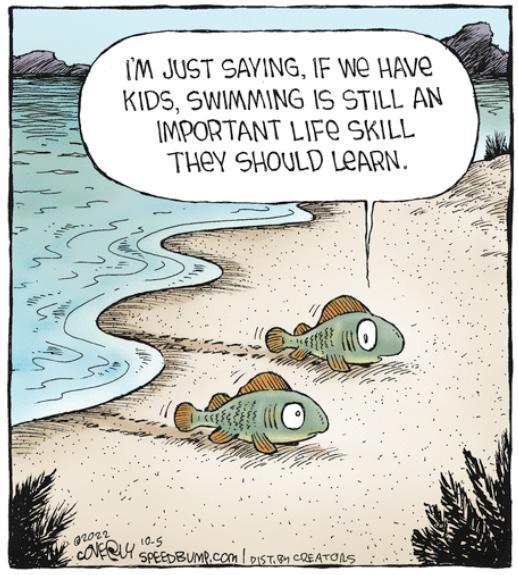from













TheFinancial Oversight and Management Board has rejected Senate Bill 728, which would require all public agencies, corporations, municipalities and entities to submit payments owed to the Puerto Rico Electric Power Au thority (PREPA) within 30 days of the legislation’s enactment.

The oversight board said the bill, which would also permit PREPA and public entities to institute payment plans for debts in excess of $5 million, goes against the fiscal plan.
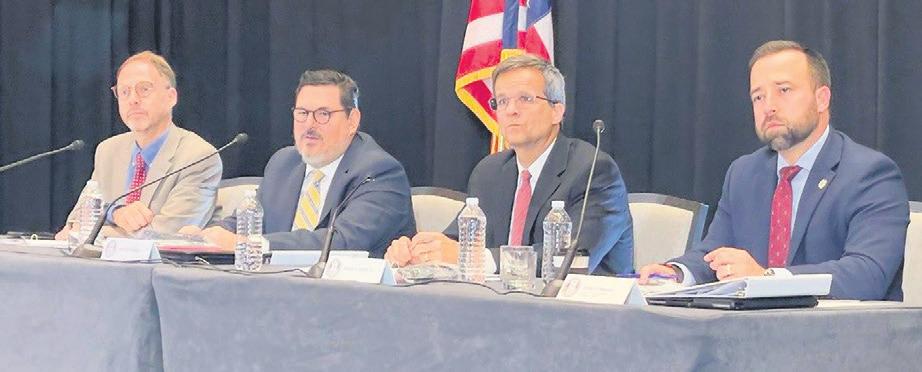
PREPA has been in bankruptcy since 2017 to restructure some $9 billion in debt. U.S. District Court Judge Laura Taylor Swain, who is presiding over PREPA’s Title III bankruptcy case, recently ordered mediation and litigation of some issues to resolve the bankruptcy and ordered the oversight board to submit a plan of adjustment in December.
The PREPA Fiscal Plan notes that “[c]ommonwealth agencies and public corporations hold accounts payable to PREPA in excess of $200 million for past due energy services” and requires PREPA to “work with LUMA [Energy, the private operator of PREPA’s transmission and distribution system] dur ing the new FY 2023 in a process of reconciling aged accounts with debtors in the upcoming years.”
The oversight board also noted inconsistencies in the legislation. In a letter dated Oct. 7, the board said Section 1 of the bill provides that past-due debt payments from public enti ties must be remitted to PREPA, while another section provides that such past-due payments on accounts that are more than two years old be directed to the Treasury Department.
The legislation would also provide for funding to the PREPA Stabilization Fund from collections of past-due debt from public entities, appropriations, and federal funds; delegate to the Puerto Rico Energy Bureau (PREB) authority over the PREPA Stabilization Fund and empower the regulatory entity to collect debt and manage debt collection; and transfer debt
obligations still in dispute as of May 30, 2021 to the PREPA Stabilization Fund’s balance sheet.
It would also prevent rate increases, including as needed to cover operating expenses and, implicitly, any debt restructur ing for PREPA, except as a last available option.



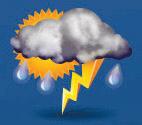
“While the Oversight Board acknowledges the Legisla ture’s intent to prioritize the collection of outstanding accounts payable owed to PREPA by public entities, the bill as currently constructed is inconsistent with the Fiscal Plans and would impair and/or defeat PROMESA’s [the Puerto Rico Oversight, Management and Economic Stability Act’s] purposes,” the oversight board said.

The legislation, which has passed the Legislature and is on Gov. Pedro Pierluisi Urrutia’s desk, “purports to control the disposition of PREPA’s property — funds collected from cer tain outstanding accounts receivable — by requiring payment within a specified timeline notwithstanding alternative payment terms previously agreed to by PREPA, designating a specific fund for deposit of collections from delinquent accounts (the PREPA Stabilization Fund), and interfering with PREPA’s use of its property by designating a specific use of the proceeds,” the oversight board pointed out.
“As such, the Bill conflicts with the Bankruptcy Code, as incorporated into Title III of PROMESA, and the Fiscal Plans,” the board continued. “Specifically, requiring such payments is an impermissible attempt by the Legislature to exert control over the debtor’s property in violation of the automatic stay in PREPA’s Title III case.”
Primarily, the bill would put some of PREPA’s assets under the control of PREB because the bill grants PREB control over the PREPA Stabilization Fund.
The oversight board reminded the Legislature that it shouldn’t be intervening with PREPA’s assets during the bank ruptcy stay, noting that Judge Swain directed the president of the island Senate to withdraw his complaint filed on behalf of the upper chamber contesting the validity of the Puerto Rico Transmission and Distribution System Operation and Maintenance Agreement because the complaint sought to nullify and enjoin the O&M Agreement, which is the property of a Title III debtor, in violation of the automatic stay.
The bill is also inconsistent with the fiscal plans and certified budgets of affected entities covered by PROMESA because it would require the com monwealth and other public entities to make payments not included in the Commonwealth Fiscal Plan or their respective certified budgets.
servants by vetoing this measure, we in the Legislature are doing them justice by passing it into law to equalize the government’s minimum wage with that of the private sector that we legislated last year,” the House speaker said in a written statement.
“Senate Bill 563 was originally approved unanimously in both bodies, but the first executive [Pierluisi] vetoed it,” Hernández Montañez added. “The Senate already overrode the veto with 18 votes from the five delegations. Now, it is up to the New Progressive Party (NPP) delegation in the House to show if it is on the side of the workers by voting to override the veto since 34 votes are needed.”
Along those lines, House Labor Affairs Committee Chairman Domingo Torres García said “the only reason that public employees have not received an increase in the minimum wage is because of the inconsistency of the NPP representatives, who first favored the bill but now follow the instructions of La Fortaleza and oppose doing wage justice to government employees who have not received a single raise in their salaries for years.”
urged island unions to join the House of Representatives in defending the validity of the Labor Reform in the face of the lawsuit filed by the Financial Oversight and Management Board to annul the statute that restores the rights of private sector employees.
“We call on the unions that group workers in Puerto Rico to join as friends of the court in this lawsuit, just as private employers are doing, and to defend, together with us, the restitution of the rights outlined in Law 412022,” Hernández Montañez said.
Torres García said meanwhile that “now that the federal court has recognized our authority to intervene as part of this case, we will contradict the fiscal control board and will have the opportunity to present evidence and demonstrate that this initiative should not be seen as an isolated one, but as part of a series of economic reforms that have become law and that will benefit workers and citizens in general, thus strengthening our economy.”
By THE STAR STAFFSpeaker of the House of Representatives Rafael “Tatito” Hernández Montañez announced Monday that the lower chamber will seek to override Gov. Pedro Pierluisi Urrutia’s veto of Senate Bill 563, which increases the minimum wage of public employees.
“After the governor turned his back on our public
Likewise, the vice chairman of the House committee that dealt with the measure, José Rivera Madera, said that “in preliminary information sent by the agencies, around five percent of government employees earn a salary of less than $8.50 an hour, which is why we call on the NPP representatives to vote in favor of giving salary justice to thousands of public servants.”
The trio of Popular Democratic Party legislators also
Rivera Madera added that “the [lower] chamber will fight the attempt of the Board and private sector groups to take away rights and impoverish our working class, but we invite all unions to join this cause and present their arguments so that the Court rules in favor of the workers.”
Law 41-2022 restored rights to private sector employees in Puerto Rico that the past administration took away, such as increasing vacation and sick leave, shortening the probationary period, and reducing the hours required to be eligible for Christmas bonus provisions.
Morethan 8,000 families have benefited from aid in the amount of $1,023,859 provided by the Office of Socioeconomic and Community Development (ODSEC by its Spanish acronym) to residents of island towns most affected by Hurricane Fiona.
Through the investment, the distribution of more than 150 pallets of drinking water, non-perishable food, cleaning products and personal hygiene items, among other important aid, was achieved in the aftermath of the Category 1 storm’s passage through Puerto Rico on Sept. 18.
“The aid reached the most affected communities in record time. From the day after the hurricane, our staff took to the streets to distribute aid in several municipalities, simultaneously,” said ODSEC Director Thais Reyes Serrano, who highlighted the help provided by the members of the Puerto Rico Firefighters Bureau, who generously assisted the elderly, women and other residents, mobilizing purchases from their vehicles and homes. “Our purpose, in each visit, in each community, has been to improve
the quality of life of the residents with food, support and empathy.”
As of Monday, ODSEC had toured communities in the
towns of Comerio, Naranjito, Salinas, Ponce, Mayagüez, Cabo Rojo, San Germán, Yauco, Lajas, Guánica, Guayanilla, Hormigueros, Añasco, Coamo, Carolina, Trujillo Alto, Arroyo, Orocovis, Barranquitas, Guayama, Santa Isabel, Peñuelas, Sabana Grande, Maunabo, Yabucoa, Camuy, Toa Alta, Aguas Buenas, Arecibo, Ciales, Río Grande, Loíza, Humacao and Naguabo.
During each tour, Reyes Serrano also identified particular needs of the inhabitants and the community in order to request additional aid and make the necessary referrals to other government agencies.

“We have accompanied Gov. Pierluisi on tours to the affected areas, around the entire island, particularly the southwest, and we have witnessed the needs they face after the passage of Hurricane Fiona,” she said. “We will continue to be active, without stopping, until all communities can move forward. That is our commitment. Puerto Rico is a blessed island and we are going to stand up once again.”
The tours continue this week in several communities in Cataño and Ponce.
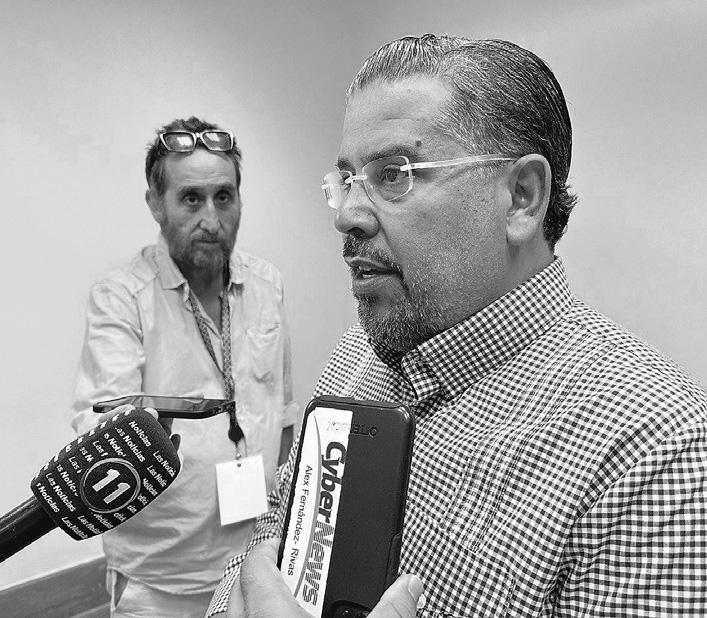
Dr. Demetre Daskalakis, from the White House Monkeypox Response Team, said “monkeypox is not a disease that lives in isolation.”
formerly known as the National Minorities AIDS Council, held a press conference via Zoom on Monday where the efforts made by the Biden administration and local organizations to curb the spread of monkeypox were discussed.
The viral illness appears predominantly among gay and bisexual men who have sex with other men. However, no one with an active sex life is immune.
The conference was part of the U.S. Conference on HIVAids held in San Juan.
Dr. Maya Rockeymoore Cummings, the moderator of the virtual encounter, noted that the strategy to stop monkeypox derives from the lessons learned during the AIDS epidemic in the 1980s and now the COVID-19 pandemic.
“The HIV community knows how to mobilize,” she said, naming early detection and community outreach as the pillars for stopping the spread of the disease.
“Black and Latinx gay men are disproportionately at higher risk but are receiving a disproportionately smaller share of monkeypox vaccines,” Rockeymoore Cummings said. “This is unacceptable, and it would be remiss if I didn’t point out that because of the HIV epidemic, we now have a roadmap to equitably address viral diseases impacting vulnerable communities.”
“The studies show that culturally competent outreach engagement and services make a positive and lasting difference,” she said. “As a result, the equitable approach to addressing monkeypox is to turn to the same organizations to lead the effort, as the evidence suggests.”
The parallels between monkeypox and HIV are inescapable, Rockeymoore Cummings said. The community remembers the stigma tied to the lesions that Kaposi sarcoma had on HIV patients and, now, the lesions that monkeypox manifest on those infected.
It is precisely that stigma that keeps infected patients at bay, isolated and worsening, so the Biden administration and community-based organizations are aggressively educating people about the disease and inviting them to come into the light and get treated and vaccinated.
“Our strategy has, at its core, equity and increasing the availability of testing and vaccines,” he said. “We have been able to fund organizations to improve what they have been able to do, and from very early on, this complex outbreak has required a big pivot. … The approach has been to target the population, and when you look at the vaccines that have been administered, we’ve had a lot of second doses but not many first doses, so we have to reach more people.”
That is why efforts to reach the black and brown communities disproportionately affected by the illness have been centered on organizations already working with HIV patients, who know where to go, who to talk to, and how to approach them.
In fact, one of the lessons learned, Daskalakis said, was that “people didn’t like the vaccine in the forearm [because of the stigma associated with HIV and the mark the vaccine could leave], so we’ve administered it in the back or upper shoulder.”
Damián Cabrera of NMAC added that “we have learned a lot over the years.”

“We understood well that representation is important and to be able to trust the community,” he said. “People trust us, and we want to make sure that we put the information in an understandable way. We, in collaboration with the Health Department, were able to do a vaccination clinic over the weekend; we provided information about monkeypox to the community. To combat doubts, information has to be present in communities of color.”
Dr. Maribel Acevedo-Quiñones, from Centro Ararat (a community-based center that works with HIV patients,) said “it has been a difficult time in Puerto Rico with the hurricane, the pandemic and the intersectionality with monkeypox.”
“With COVID, we have learned that we have to start working hard, hit hard, and hit early,” she said. “We have the sexual health clinic because we [encourage] participants to get vaccinated, and we make plans to have vaccines available in our phlebotomy area every day. We vaccinate people every day. … The opportunity is to come together and do assessments and reassessments to close those gaps that we are having at the root of this situation.”
Energy announced Monday that it had restored electrical service to 1,447,464 clients, or 99% of the total clients on the island, after the passage of Hurricane Fiona.
“In less than two weeks after the passage of a Category 1 hurricane, LUMA has restored the electrical service of more than 90 percent of the clients at a historic rate for the island when it comes to hurricanes of great magnitude” said LUMA Energy spokesman Daniel Hernández in written statement. “Additionally, to date, LUMA has successfully restored service to 99 percent of customers. Although the more than 3,000 men and women of
LUMA have worked hard to restore service in the face of difficult conditions, we will continue with our restoration efforts focused on the most affected areas to ensure that all customers have service.”
The private grid operator added that it has restored the service of 100% of clients in San Juan and Bayamón, 99% of clients in Caguas and Arecibo, 97% of customers in the Ponce service region, and 94% of customers in the Mayagüez service region. LUMA also reported that it has restored service to 100% of hospitals and 99% of all Puerto Rico Aqueduct and Sewer Authority facilities.
The company also urged all customers who received power after Hurricane Fiona, and who are currently experiencing service interruptions, to call 1-844-888-5862 (LUMA).
Dr. Melissa Marzán, the senior epidemiologist at the island Department of Health, said meanwhile that “since the beginning of May, when we started to see the information, we started to develop a monkeypox response at the local level.”
“In addition, we started a process to train healthcare providers,” she said. “This was news to providers, but we also started conversations with communities. Most of the epidemiology was related to gay and bisexual men who had sex with men, and we held weekly calls to ensure all the strategies were the right ones. We started the vaccination process in the health centers but were unsuccessful, so we started doing local activities in the communities and increased vaccination.”
“Approximately how many people have been affected by monkeypox in Puerto Rico, and are we seeing a prevalence in certain municipalities?” the STAR asked.
“We have 189 cases, mostly in the [San Juan] metropolitan area. In Centro Ararat, we also have the same experience,” Acevedo-Quiñones said. “We have evaluated 55 suspected cases; most of them are from the metropolitan area, and another thing we have seen is the prevalence among people diagnosed with HIV and those who are in PReP (pre-exposure prophylaxis), and then those who walk into the clinic because they have a lesion. That is the same trend; we are also paying attention to other areas in Puerto Rico, and we are willing to serve any community.”
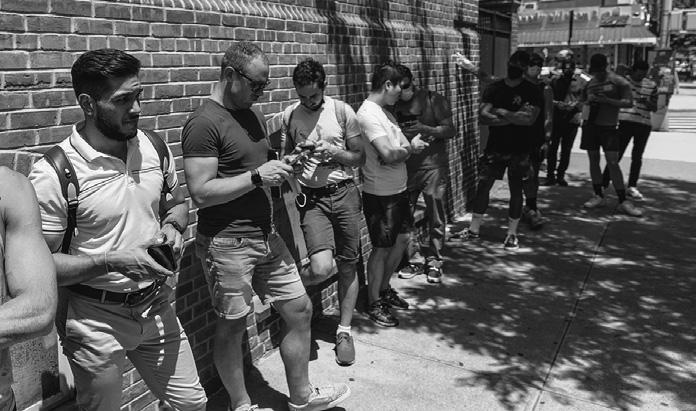

“Black and Latinx gay men are disproportionately at higher risk but are receiving a disproportionately smaller share of monkeypox vaccines,” said Dr. Maya Rockeymoore Cummings, the moderator of a press conference held by NMAC via Zoom on Monday. (Photo by Victor J. Blue/The New York Times)
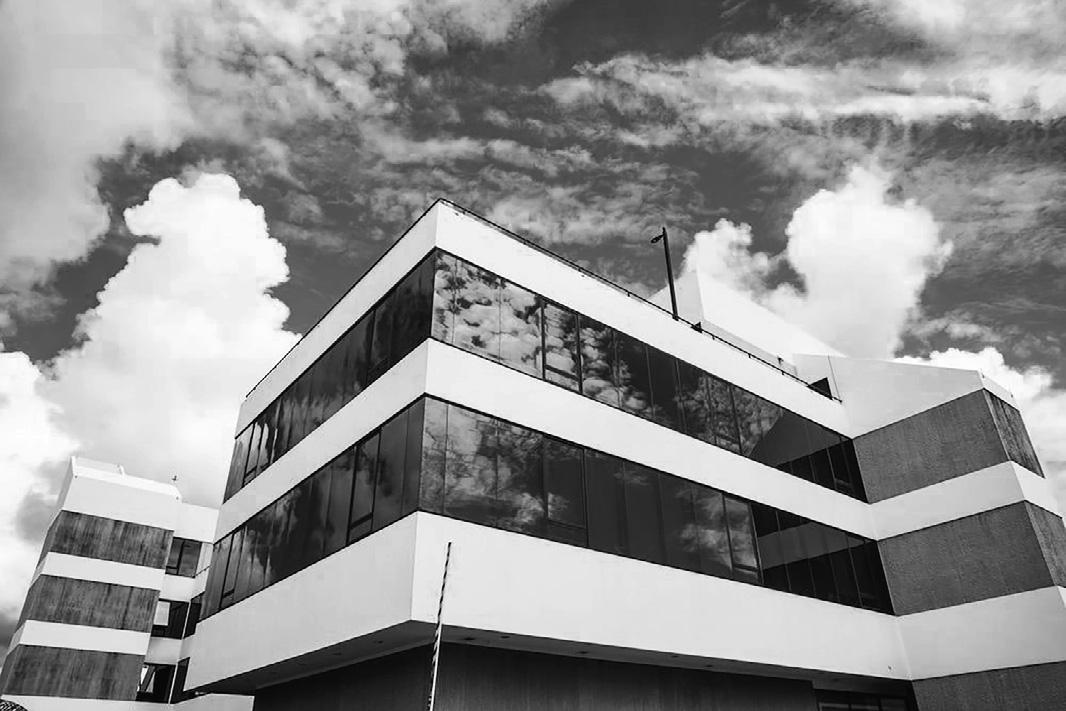 By THE STAR STAFF
By THE STAR STAFF
Health System signed a purchase agreement Monday for the acquisition of San Cristóbal Hospital in Ponce, hospital authorities said.
With the agreement, the institution is on track to obtain the necessary permits for Hospital Mennonite Ponce Inc. to begin operations on Dec. 1 as part of the fastest growing and most extensive health system in Puerto Rico: the Mennonite Health System.
“We are extremely pleased to have signed this agreement, as it allows us to continue expanding our operations throughout the island, with the purpose of bringing innovation, cutting edge technology, development and above all the quality service and Christian love that distinguishes the Mennonite Health System,” said Ricardo Hernández, executive director of Mennonite Health System, in a written statement. “We come with the goal of fostering excellent relationships with our team and medical faculty, building on what we have achieved here through the years.”
“Another important aspect that this
agreement brings is the favorable economic impact on the community through the business relationships and natural integration
in the communities in which we operate,” he added. “Mennonite distinguishes itself because we reinvest everything produced
TheFederal Communications Commission (FCC) at its October Open Commission meeting will consider a further notice of proposed rulemaking (FNPRM) to support mobile carriers and extend the support phase-down for incumbent fixed broadband providers in Puerto Rico and the U.S. Virgin Islands to enhance their networks’ reliability and resiliency in the face of natural disasters.
The announcement was made by FCC Chairwoman Jessica Rosenworcel as she listed five items that are tentatively on the agenda for the October Open Commission Meeting. The FNPRM is part of the Uniendo a Puerto Rico Fund and the Connect USVI Fund, created in the aftermath of the 2017 hurricanes to ensure the restoration, hardening and expansion of advanced telecommunications networks in the territories.
According to the FCC, the recent devastation caused by Hurricane Fiona in Puerto Rico demonstrates that critical com-
munications infrastructure in areas prone to hurricanes must be built to withstand storm damage and have redundant capabilities.
The FNPRM proposes another step for mobile and fixed broadband funding in Puerto Rico and the USVI to restore, harden and expand the vital networks, according to a statement.
“The current three-year mobile support term for carriers in Puerto Rico and the USVI ends starting in June 2023,” the FCC said.
“This FNPRM proposes a period of up to 24 months of transitional support for mobile carriers so they can continue to provide service and ensure that their networks are sufficiently resilient to withstand the impact of natural disasters.”
The FNPRM also proposes extending the phase-down of frozen support for incumbent fixed providers in Puerto Rico and the USVI for the areas in which they were not awarded long-term support for broadband services.
“Because the frozen support for those providers is scheduled to end in June of
in more and better services for the community, and this transaction is a clear example of that.”
The transaction, in addition to the purchase of the facility, will include improvement projects, purchase of new equipment and operational capital. It also represents more than 100 additional jobs and is part of the Mennonite system’s long-term strategic plan, which aims to bring to southern Puerto Rico its model of medical-hospital services focused on the highest quality medical faculty, human resources and cutting-edge technology.
Mennonite has medical specialists and surgical procedures that are unique and difficult to access in Puerto Rico to support and complement the services offered at the hospital. Its medical faculty has been recognized for its expertise in areas such as neuroscience, cardiology, orthopedics and robotic surgery, among many other disciplines.
Currently, the hospital employs about 410 professionals, including a faculty of 100 doctors in different specialties who join more than 1,000 doctors in all its facilities.
2023, this item proposes extending the existing support amount until December 2025,” the FCC said.
What the FNPRM would do is propose
transitional support for mobile carriers, as a lapse in funding may leave progress already made in increasing the robustness of existing 4G telecom services and expanding 5G at risk.
It would also seek comment on a variety of aspects of mobile transitional support, including eligible areas where support may be used, appropriate technological uses of transition support, the proper support term, the appropriate amount of transitional support, and any reporting and minimum service requirements. In addition, it would also seek comment on whether, and to what extent, the new maps generated as part of the Broadband Data Collection should be used to determine mobile support in Puerto Rico and the USVI.
According to the Federal Communications Commission, the recent devastation caused by Hurricane Fiona in Puerto Rico demonstrates that critical communications infrastructure in areas prone to hurricanes must be built to withstand storm damage and have redundant capabilities.
Another thing it would do is propose extending phase-down frozen support for fixed providers in Puerto Rico and the USVI who were not awarded long-term, competitive support in a given area, and require all phase-down frozen support to be used on network resiliency and redundancy.

One year after President Joe Biden became the first U.S. president to formally commemorate Indigenous Peoples’ Day, more than a dozen states re cognize some version of the holiday in lieu of Columbus Day.
More than 130 cities have adopted the holiday, choosing to heed calls from Indige nous groups and other activists not to celebrate Christopher Columbus, the Italian navigator after whom the holiday is named. They say he brought genocide and colonization to communities that had been in the Americas for thousands of years. Many around the cou ntry, however, still celebrate Columbus Day or Italian Heritage Day as a point of pride.
Some members of Indigenous commu nities say recognizing the day, which this year was on Monday, does not go far enough. It is not yet a federal holiday, though there are two bills in Congress — one each in the House and Senate — that propose to make it one. Here is more background.
What is Indigenous Peoples’ Day?
Typically on the second Monday of October, Indigenous Peoples’ Day recogni zes the Indigenous communities that have lived in the Americas for thousands of years. It became increasingly popular as a replace ment for Columbus Day, which was meant to celebrate the explorer who sailed with a crew from Spain in three ships, the Nina, Pinta and Santa Maria, in 1492.
In a proclamation for this year’s holiday issued Friday, Biden said Indigenous Peoples’ Day is intended to “honor the sovereignty, resilience and immense contributions that Native Americans have made to the world.”
But he added that “we have more to do to help lift Tribal communities from the shadow of our broken promises, to protect their right to vote and to help them access other oppor tunities that their ancestors were long denied.”
Before the president’s initial proclama tion last year, many U.S. cities and states were observing Indigenous Peoples’ Day. Colleges and companies have also increasingly recog nized it. South Dakota is believed to be the first state to have officially recognized the day (as Native American Day) in 1990. Native Americans make up about 9% of the state’s population, according to recent census figures. Alaska, Oregon and Vermont are among the states that also officially established the day
as a holiday; many other states recognize it through proclamations. Cities like Berkeley, California, Seattle and Minneapolis also were early adopters.
Similar commemorative days exist un der other names around the world. Canada has been recognizing a National Indigenous Peoples Day on June 21 since 1996, and the country honored the first National Day for Truth and Reconciliation on Sept. 30 last year. The government there has apologized at various instances for the suppression and for ced assimilation of Indigenous communities.
In recent years, statues of Columbus have been taken down in cities around the world, including in Mexico City.
The United States Postal Service and post offices were closed in observation of Columbus Day, as were most banks. Most government offices and libraries were closed. Stores such as Walmart and Target and most grocery stores were open.
In some cities, trash and recycling co llection were suspended.
How do Indigenous groups feel about the day?
Activists in cities such as Denver and Seattle have protested Columbus Day for years and in many cases have fought to gain recognition for Indigenous Peoples’ Day. Unofficial celebrations of Indigenous cultures have also taken place, including on NewYork’s Randalls Island.

The Navajo Nation, the country’s largest tribe with about 400,000 people, has long voiced its support for renaming the day.
“Transforming Columbus Day to Indi genous Peoples’ Day will encourage young Navajos to have pride in the place and people they come from and the beauty they hold within,” Jonathan Nez, the president of Navajo Nation, said last year in a statement before Biden’s first proclamation.
However, some say mere observance of the day doesn’t do enough, and point out that no American president has explicitly apologi zed for the country’s treatment of Indigenous peoples. Others call it an important first step.
“I think it really recognizes that Indi genous people are still here,” said Alannah Hurley, executive director of United Tribes of Bristol Bay, a consortium of Indigenous communities in southwest Alaska, and aYup’ik fisherwoman. “We just have been struggling for so long for the vast majority of mainstream
America and culture to recognize that — that we are not just in history books.”
She added, “We’re still fighting for our lands and our waters and our way of life. That visibility is huge because we have struggled for so long with being made invisible by mainstream society.”
What are some of the major issues Indigenous peoples face?
Supporters of the day say it may help bring attention to some of the ways Indigenous peoples are discriminated against and are disproportionately affected by climate change, gender violence and health issues, as well as to the Indigenous lands affected by mining, drilling and both public and private projects.
Audra Simpson, professor of anthro pology at Columbia University, points to “the pipelines and fracking projects running through our territories” and “the ongoing and disproportionate violence directed at Indigenous people, especially women, girls and trans.”
The interior secretary Deb Haaland, the first Native American to hold that post, had made that violence a priority with the establis hment of a Missing and Murdered Unit within the Bureau of Indian Affairs, Simpson noted.
Hurley’s organization of 15 tribes has been fighting the construction of the Pebble Mine, a copper and gold mine in a major sal mon fishery that Indigenous communities say
will pollute the Bristol Bay in southwest Alaska.
“There is much greater attention — media attention, public attention — paid to Indigenous peoples’ struggles and value than was the case 50 years ago,” said Jonathan Mazower, communications director for Sur vival International, an organization that works with and champions the rights of Indigenous communities around the world.
What about Italian Heritage Day?
Some Italian communities have called for a day separate from Columbus Day to celebrate their heritage, as Columbus Day originated partly as a response to anti-Italian sentiment. It was designated a national ho liday in 1934, and in 1971 the government declared it a federal holiday to be celebrated the second Monday of each October.
New York City schools have tried to compromise by labeling the day as both In digenous Peoples’ Day and Italian Heritage Day, nixing the Columbus Day title. There are still large Columbus Day and Italian heritage celebrations around the country, including the long-running parades in New York and the San Francisco area.
Biden issued a separate proclamation on Friday for Columbus Day, saying that “the hard work, dedication to community and lea dership of Italian Americans in every industry make our country stronger, more prosperous and more vibrant.”
At her confirmation hearings in March, Ketanji Brown Jackson declared her self to be an originalist, meaning, she explained, that she would interpret the Con stitution based on how it was understood at the time it was adopted.
“I look at the text to determine what it meant to those who drafted it,” she said.
Conservatives were pleased she had said this, but some wondered whether she had meant it. Last Tuesday, during her second day of hearing arguments as a member of the Supreme Court, Jackson demonstrated that she was serious — and that she believes original ism can require liberal outcomes.
She spoke during an argument over the meaning of the Voting Rights Act of 1965, a civil rights landmark. The immediate question in the case was whether a congressional map drawn by Alabama lawmakers had violated the act by diminishing Black voters’ power.
But a larger question loomed in the background: Was the act itself in ten sion with the 14th Amendment’s equal protection clause, which was adopted after the Civil War?
Many conservatives say the clause forbids the government from drawing distinctions based on race — that the Constitution is colorblind. That was a misreading of the historical evidence, Jackson said, which demonstrated that “the entire point of the amendment was to secure rights of the freed former slaves.”
“I don’t think,” she said, “that the his torical record establishes that the founders believed that race neutrality or race blindness was required.”
by “a pioneering originalist,” Justice Antonin Scalia, who died in 2016.
“To him and many other origi nalists, the decision in Obergefell was the precise opposite of originalism,” Alito said. “In 1868, when the 14th Amendment was adopted, nobody — nobody — understood it to protect a right to same-sex marriage.”
He seemed to take Kagan to task for her vote in that case. “Justice Kagan, who must regard herself as an originalist — she has said ‘we are all originalists now’ — joined the major ity in Obergefell,” he said.
Kagan discussed originalism at her own confirmation hearings, in 2010, saying that the framers of the Con stitution had different goals in different parts of the document.
There is a proposed Settlement in a class action lawsuit against Toyota Motor Corporation and Toyota Motor North America, Inc. (collectively, “Toyota”) and Denso International America, Inc. (“Denso”) (collectively, “Defendants”) concerning certain Toyota and Lexus vehicles. Those included in the Settlement have legal rights and options that must be exercised by certain deadlines.
What is the lawsuit about?
The lawsuit alleges that the fuel pumps that are manufactured by Denso and its affiliates and installed in certain Toyota and Lexus vehicles contain a defective component. Toyota and Denso deny any and all allegations of wrongdoing and the Court has not decided who is right. Instead, the parties decided to settle.
Am I Included in the Proposed Settlement?
Subject to certain limited exclusions, you are included if as of September 19, 2022,
• You own or owned, purchase(d), or lease(d) a Toyota or Lexus vehicle covered under this Settlement (“Covered Vehicles”); and
• Your Covered Vehicle was distributed for sale or lease in any of the fifty States, the District of Columbia, Puerto Rico, and all other United States territories and/or possessions.
A full list of the Covered Vehicles and the VINs can be found at www.ToyotaFuelPumpsSettlement.com. This Settlement does not involve claims of wrongful death, personal injury, or physical property damage caused by an accident.
The Settlement offers several benefits, depending on the vehicle, including a Customer Support Program which will provide prospective coverage of 15 years, measured from the date of original sale, for any repairs to correct defects in the fuel pumps or an Extended New Parts Warranty of 15 years, measured from July 15, 2021 or 150,000 miles, whichever comes first. The Settlement
also offers a complimentary Loaner/Towing Program for vehicles undergoing repairs; reimbursement of certain out-of-pocket expenses; a reconsideration procedure; and settlement oversight by a Settlement Special Master. Some of these benefits require action by Class Members by certain deadlines.
If you do nothing, you will remain in the Class, receive certain benefits and will not be able to sue Toyota, Denso, or the Released Parties. You can exclude yourself by December 2, 2022, if you don’t want to be part of the Settlement. You won’t get any settlement benefits, but you keep the right to sue Defendants. You can submit a Claim Form by a date to be set, which will not be earlier than 90 days after the Court’s issuance of the Final Order and Final Judgment, if you have out-of-pocket expenses covered by the Settlement and don’t exclude yourself. You can object to all or part of the Settlement by November 25, 2022, if you don’t exclude yourself. The full notice describes how to exclude yourself, submit a Claim Form, and/or object.
The Court will hold a fairness hearing on December 14, 2022 at 10 a.m. ET to: (a) consider whether the proposed settlement is fair, reasonable, and adequate; and (b) decide the plaintiffs’ lawyers’ request for fees up to $28.5 million and costs and expenses of up to $500,000 and Class Representative service awards of either $2,500 or $3,500 each, depending upon whether they had an inspection. The motion for attorneys’ fees, costs, and expenses, and Class Representative service awards will be posted on the website after they are filed. You may but are not required to appear at the hearing, and you may hire an attorney to appear for you, at your own expense.
more information or a Claim Form call 1-833-5122318 or visit www.ToyotaFuelPumpsSettlement.com
A week before Jackson’s remarks, Justice Samuel Alito gave a speech at Catholic Uni versity’s Columbus School of Law. His topic was “originalism and the Catholic intellectual tradition,” and he noted that “originalism has often been thought, correctly or incorrectly, to be associated with conservatism.”
Alito, who wrote the majority opinion in the decision in June overturning Roe v. Wade, raised a series of questions about the meaning and limits of originalism now that liberal justices have said they embraced it.
“Are we really all originalists?” he asked, mentioning one of the liberal members of the court. “Many people, including my colleague Elena Kagan, have said that ‘we are all origi nalists now.’ Is that true?”
Only to a point, he said. While many judges agree that the Constitution “should be interpreted in accordance with its original public meaning,” he said, “there is a lot of disagree ment about how that meaning should be found.”
“To illustrate this, my Exhibit A is Obergefell v. Hodges,” he said, referring to the 2015 Supreme Court decision that said the due process clause of the 14th Amendment guaranteed the right to same-sex marriage.
Alito dissented in that case, and in 2020 he joined a statement from Justice Clarence Thomas saying the Obergefell decision was at odds with the Constitution. In June, in his majority opinion in the abortion case, he said that ruling did not threaten other rights.
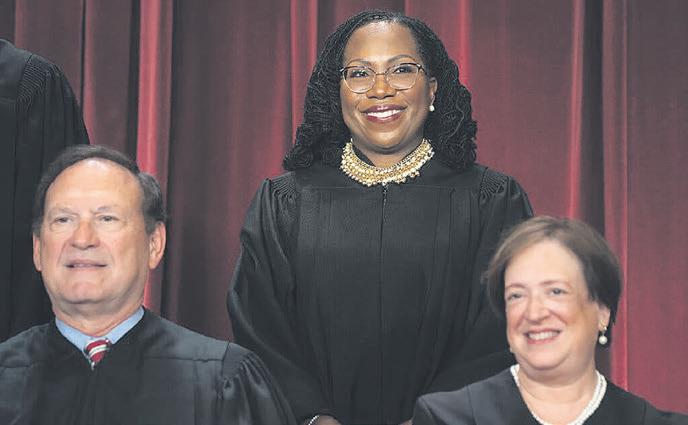
In his speech last month, Alito focused on the “blistering dissent” in Obergefell written
“Sometimes they laid down very specific rules,” she said. “Sometimes they laid down broad principles. Either way, we apply what they say, what they meant to do. So in that sense, we are all originalists.”
She elaborated on that statement last month in a public interview at Northwestern University that seemed to anticipate Alito’s criticism.
A specific provision of the Constitution, like the one that says presidents must be at least 35 years old, needs no interpretation, she said.
In other provisions, she said, the framers “knew that they were writing for the ages” and so “wrote in broad terms and in what you might call vague terms.” Interpreting those provisions, she said, requires judgment and attention to contemporary reality.
“They had some understanding,” Kagan said of the framers, “that life would change and that you were supposed to apply these principles — and you had to apply these principles — but to circumstances that they couldn’t imagine.”
In his speech, Alito acknowledged that originalism has limits, particularly in cases that “could not have arisen at the time when the relevant constitutional provision was adopted,” mentioning a case concerning re strictions on the sale of violent video games.
When the case was argued in 2010, Scalia asked what those who ratified the First Amendment thought about depictions of violence.
Alito responded with a quip: “What Justice Scalia wants to know is what James Madison thought about video games. Did he enjoy them?”
Justice Ketanji Brown Jackson, center, demonstrated in her second day of hearing arguments on the Supreme Court that she believes originalism can require liberal outcomes.pain that the families had been subjected to during the trials.
than 20 miles from the place where a gunman massacred 20 first graders and six educators at Sandy Hook Elementary School, the trial of Alex Jones, who has spent much of the decade since the attack spreading lies about what happened that day, neared its conclusion last week.
The closely watched courtroom spectacle playing out just up Interstate 84 was part of a long-running defamation case that has featured wrenching testimony and explosive outbursts. But in Newtown, Connecticut, people are done talking about Jones.
“I think that most of the people in this town would like to forget about him, to forget his name,” said Richard Fattibene, 81, as he sat in the town’s general store having a coffee last Tuesday morning.
As the founder of the conspiracy website Infowars, Jones was found liable last year in four defamation lawsuits, and a jury in nearby Waterbury, Connecticut, was expected to decide within days how much he should pay in compensatory and punitive damages in one of the cases.
But for the very real town where his twisted fantasies were focused, the trial has been less a courtroom reckoning than an unwelcome reminder of the tragedy that has become synonymous with its name.
Fattibene is semiretired from his business selling parts to auto body shops. He recalled the brutal aftermath of the attack, the police cars on his street guarding the houses of children who had perished, the universal anguish.

“The town was upside down,” he said.
A friend who had joined him that morning, Dominic Calandruccio, 80, an insurance salesperson who is also semiretired, sounded a similar note. He hadn’t been following the Jones trial, but he had strong feelings about the man at its center.
“We hate him,” he said, adding, “I hope he goes to jail.”
Calandruccio, who moved to Newtown in 1978, thinking it would be a great place to raise his family, said he still loved the town, with its rolling hills, its well-preserved architecture and its access to nature. He often walks his dog near a site that is to become an animal sanctuary named for Catherine Violet Hubbard, a little girl killed in the tragedy who had loved animals.
It left him dumbfounded that conspiracy theorists could harass and stalk victims’ families after what happened.
“How can anybody be so cruel to those people?” he asked.
The Rev. Andrea Castner Wyatt, rector of Trinity Episcopal Church in Newtown, Conn. on Oct. 4, 2022.
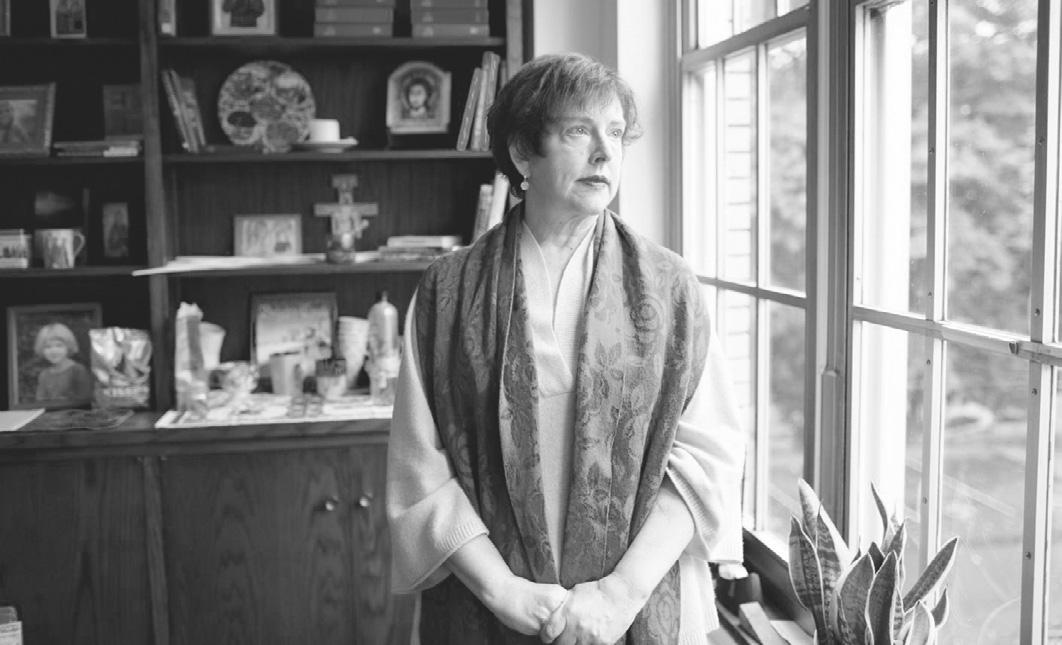
Almost immediately after the attack, conspiracy theorists seized upon the toxic notion that the tragedy had been staged by the government as a pretext to advance gun control. It was trauma layered on trauma, and one of the key figures behind the lies was Jones, stoking the frenzy on his popular Infowars show and website.
Jones was found liable in four defamation lawsuits filed by the families of some of the victims, and damages are being determined by juries in three separate trials. The judgments were made by default because he had refused to turn over documents, including financial records, through years of litigation.
Jones and anguished families have both testified, and though he had been expected to take the stand again Wednesday, he did not.
In his first case, in Austin, Texas, over the summer, a jury awarded nearly $50 million to Scarlett Lewis and Neil Heslin, parents of Jesse Lewis. That total may be revised because in Texas, where Jones’ media company is based, verdicts are capped. During that trial, Jones conceded that the attack was “100% real.”
The case being heard in Connecticut this week is the second and was brought by eight families of victims and an FBI agent who responded to the attack.
In Connecticut, there are no limits on the damages, so the decision could ruin Jones financially. He has made millions selling survivalist gear, diet supplements and gun accessories on his broadcasts — and was found to have violated a state law prohibiting the use of lies to sell products.
The third trial is tentatively scheduled for
later this year in Austin.
At a cafe near the Sandy Hook Elementary School — where a new building now stood after the previous one was torn down — Sue Bucur and Barb Baldino, both 59 and local residents, were catching up over lunch. They were not watching the trial, but they remained incensed about the role that Jones had played in circulating falsehoods.
“For someone to deny what happened — he didn’t sit here and watch a line of hearses go by on the way to the cemetery,” said Bucur, who owns a crystal shop near the cafe.
Baldino, who works in media sales, added that the money could not reverse the damage that had been done by the lies or reverse the
“I don’t know how you can punish him enough,” she said. “The money’s not going to do anything for anybody.”
The Rev. Andrea Castner Wyatt, rector at Trinity Episcopal Church, has been painfully aware since she arrived in Newtown two years ago that the work of healing the trauma the town endured would take many years. The church has helped organize annual interfaith services of remembrance, although the community hasn’t yet settled on a location for the service next month, which will mark 10 years since the attack.
Part of her deepest distress comes from seeing that mass shootings continue to take place around the country, she said. The church also hosted a well-attended vigil for the victims of the Uvalde, Texas, school shooting in May, which she said was painfully similar to the Sandy Hook attack.
“They’ve had 10 years of learning what it’s like to live with this,” she said of the town. “That’s why their hearts really went out to Uvalde.”
For John Bergquist, 47, the trial was a reminder of the political divisions roiling the country. He grew up in Newtown, works in a winery nearby and was sipping a rosé at a favorite haunt, My Place, after work Monday.
“People have reached their saturation point with talking about the tragedy,” he said. “Not that they don’t care, but it’s been relitigated so many times, it’s difficult.”
But he added that the shadow of the killings always loomed.
“Even if you do stop talking about it, I think everybody feels a connection to what happened,” he said.
TheBiden administration late last week an nounced sweeping new limits on the sale of semiconductor technology to China, a step aimed at crippling Beijing’s access to criti cal technologies that are needed for everything from supercomputing to guiding weapons.
The moves are the clearest sign yet that a dangerous standoff between the world’s two major superpowers is increasingly playing out in the technological sphere, with the U.S. trying to establish a stranglehold on advanced com puting and semiconductor technology essential to China’s military and economic ambitions.
The package of restrictions, which was released by the Commerce Department, is designed in large part to slow the progress of Chinese military programs, which use super computing to model nuclear blasts, guide hy personic weapons and establish advanced net works for surveilling dissidents and minorities, among other activities.
Alan Estevez, undersecretary of commer ce for industry and security, said his bureau was working to prevent China’s military, intelligence and security services from acquiring sensitive technologies with military applications.
“The threat environment is always chan ging, and we are updating our policies today to make sure we’re addressing the challenges po sed by the PRC while we continue our outreach and coordination with allies and partners,” he said, referring to the People’s Republic of Chi na.
Companies will no longer be allowed to supply advanced computing chips, chipmaking equipment and other products to China unless they receive a special license. Most of those licenses will be denied, though certain ship ments to facilities operated by U.S. companies or allied countries will be evaluated case by case, a senior administration official said in a briefing Thursday.
It remains to be seen whether the Chi nese government will take action in response. Samm Sacks, a senior fellow at Yale Law School who studies technology policy in China, said the new rules could push Beijing to impose res trictions on American companies or firms from other countries that comply with U.S. rules but still want to maintain operations in China.
“The question is: Would this new packa ge cross a red line to trigger a response that we haven’t seen before?” she said. “A lot of people are anticipating it will. I think we’ll have to wait
A semiconductor factory in Nantong, China. New limits on sales of semiconductor technology aim to slow the progress of Chinese military programs.
and see.”

The measures come at a particularly sensitive moment for Beijing. Chinese leaders will hold a major political meeting beginning Oct. 16, where leader Xi Jinping is expected to secure a third leadership term, becoming the country’s longest-ruling leader since Mao Ze dong.
Liu Pengyu, a spokesperson for the Chi nese Embassy in Washington, said the Uni ted States was trying “to use its technological prowess as an advantage to hobble and sup press the development of emerging markets and developing countries.”
“The U.S. probably hopes that China and the rest of the developing world will forever stay at the lower end of the industrial chain,” he added.
The Chinese government has invested heavily in building up its semiconductor in dustry, but it still lags behind the United States, Taiwan and South Korea in its ability to pro duce the most advanced chips. In other fields, such as artificial intelligence, China is no longer significantly behind the United States, but tho se technologies mostly rely on advanced chips that are designed or fabricated by non-Chinese firms.
New limits on sales of chipmaking equi pment are also expected to clamp down on the operations of China’s homegrown chipmakers, including Semiconductor Manufacturing Inter

national Corp., Yangtze Memory Technologies Co. and ChangXin Memory Technologies.
The effect of the restrictions will hinge on how the policy is implemented. For most of the measures, the Commerce Department has the discretion to grant companies special licenses to continue selling the restricted products to China, though it said most would be denied.
Some Republican lawmakers and China hawks have criticized the department for being too willing to issue such licenses, allowing U.S. companies to continue selling sensitive techno logy to China even when national security may be at stake.
With its vast ecosystem of factories, Chi na continues to be a massive and lucrative mar ket for U.S. chip exports. The tiny technologies are crucial to the smartphones, laptops, coffee makers, cars and other goods that Chinese fac tories pump out for domestic consumption and export to the world.
Many U.S. companies have long argued that their sales to China are an important sou rce of revenue that allows them to reinvest in research and development and retain a com petitive edge.
But doing business with China has beco me much more fraught in the last few years, as the tensions between the United States and China have morphed into a cold war compe tition. The Chinese government has sought to blur the line between its defense sector and private industry, drawing on Chinese firms that specialize in fields including artificial intelligen ce, big data, aerospace technologies and quan tum computing to fuel the country’s military modernization.
Chinese military drills aimed at intimida ting Taiwan and China’s alignment with Mos cow following the Russian invasion of Ukraine have strengthened the case for technology re gulation.
Still, industry executives and some analysts argue that cutting China off from fo reign chips will accelerate Beijing’s push to develop them itself and cause U.S. companies to lose out to foreign competitors, unless other countries also impose similar restrictions.
The Semiconductor Industry Association said Friday that it was assessing the effect of the export controls on the industry and working with companies to ensure compliance.
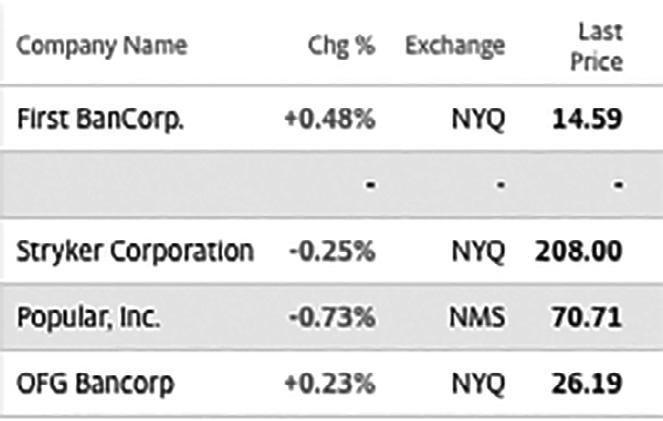
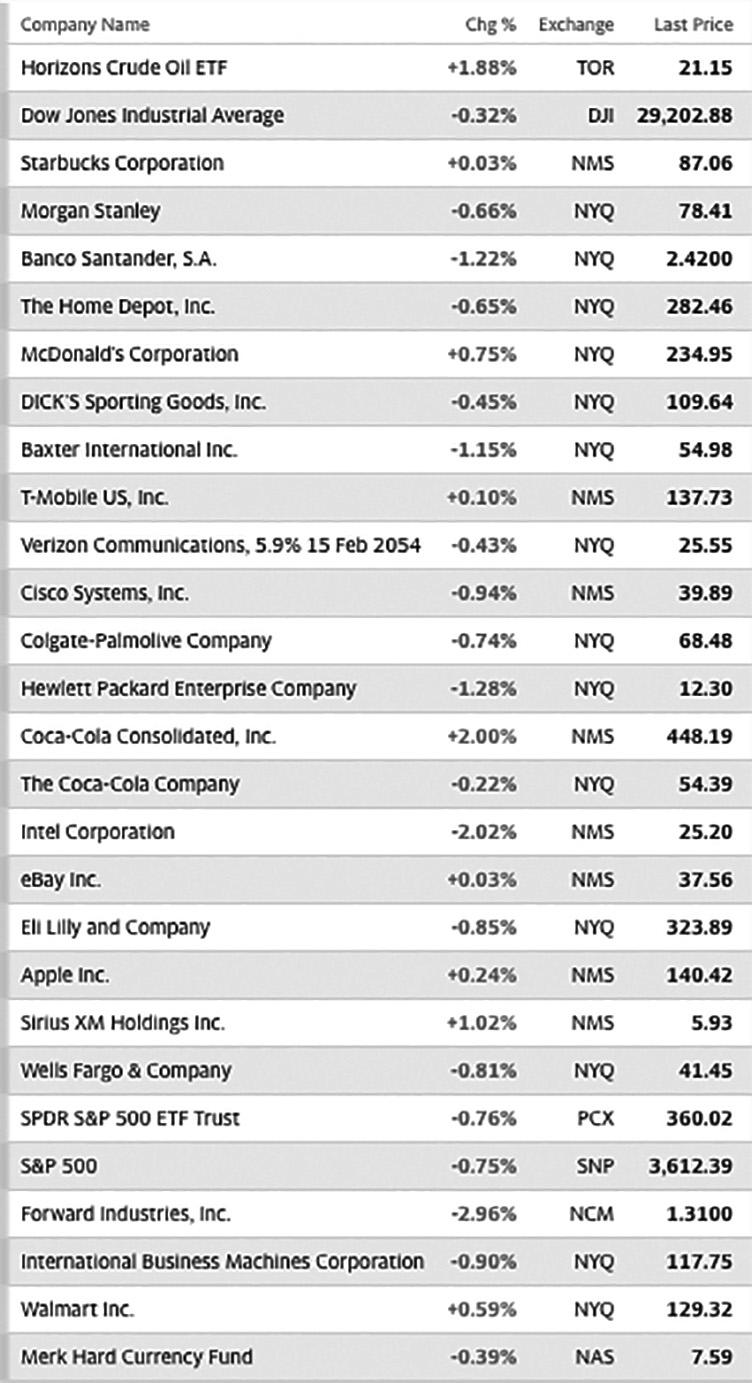
U.S. Federal Reserve is clear on the need for restrictive monetary policy to lower inflation, Fed Vice Chair Lael Brainard said on Monday, but the path and pace of rate increases will remain “data-dependent” as the central bank monitors the economy and the evolution of domestic and global risks.
In prepared remarks and responses to questions, Brainard said Fed rate hikes to date were beginning to slow the economy - perhaps even more than expected - and that the full brunt of tighter policy would not even be felt for months to come.
Additionally, the “concurrent” rate hikes by central banks abroad as they all fight local outbreaks of inflation was creating an impact “larger than the sum of its parts” that posed potential risks U.S. officials need to monitor, Brainard said.
“There is clarity that monetary policy will be restrictive for some time, until there is confidence inflation comes down.
... The (Federal Open Market) Committee has said policy rates will increase further,” Brainard said. But “we also will be learning as we go and that assessment will reflect incoming data and also risks domestically and globally ... The actual policy path will be data-dependent.”
She referred to projections of policymakers about the path of interest rates, which as of September showed the median officials anticipating the federal funds rate rising to around 4.6% next year, as “very helpful at a point in time,” but also based on expectations about how the economy will evolve.
“Things can change,” she said.
Brainard gave no sense the Fed was weakening in its resolve to quell inflation that is currently triple the central bank’s 2% target, or that the Fed will not proceed with planned rate increases including a possible three-quarter point hike at its Nov. 1-2 session.
In an appearance at a National Association for Business Economics conference, she restated that it would be risky for the Fed to back off “prematurely” in its rate tightening, and that it would “take some time” for inflation to fall.
However she spoke at a time of mounting external concern that the speed of Fed rate increases was stressing the global economy and had outrun the central bank’s ability to monitor the impact it was having.
In a poll of 45 professional forecasters conducted by the NABE, a little over half said that “the greatest downside risk to the U.S. economic outlook is too much monetary tightness.”
Fed officials have for the most part discounted those concerns, acknowledging the risks of over-tightening but also saying they need to get the target federal funds rate to a level they feel will bring inflation under control by restraining the economy.
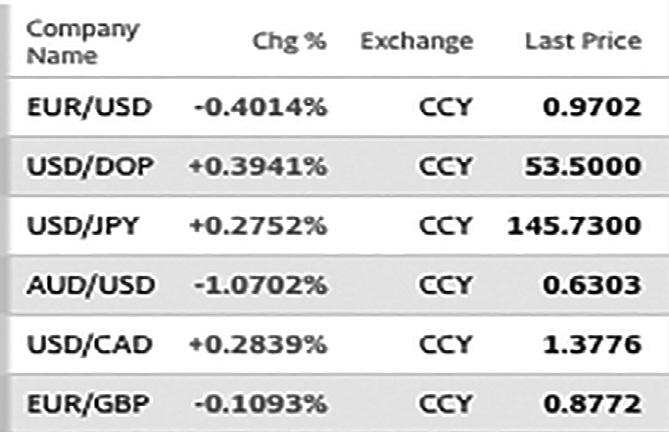

The Fed has raised rates rapidly this year, using threequarter point increments of late to bring the target federal funds rate to a range between 3% and 3.25%.
In separate remarks at the NABE event, Chicago Fed President Charles Evans said incoming data would have to “rock” policymakers’ economic projections to throw officials off the 4.6% rate they have penciled in for next year.
“We’re headed for this four and a half percent-ish federal funds rate by March,” Evans said, with little time left for data to shift officials’ views.
Like Evans, Brainard laid out some of the dynamics she thought might help bring inflation down while leaving the U.S. job market and economy intact.
Brainard said for example that in retail and other industries there was “ample room for margin recompression” - in
effect lower business profits - to bring down the price of goods, along with further improvements in supply chains and hiring.
But she also emphasized some of the evolving risks, including possible stress in financial markets and what could be a faster than expected slowdown in the United States.
“Output has decelerated so far this year by more than anticipated,” in sectors like housing that are directly influenced by borrowing costs, Brainard said.
There are indications as well that U.S. consumers have spent down household balances faster than previously estimated, a possible signal of slowed consumer spending to come, she said.
that drew furious international condemnation.
for immediate de-escalation.
President Vladimir Putin unleashed the broadest aerial assault against Ukraine’s civilians and critical in frastructure since the early days of Moscow’s invasion, hitting cities across the country Monday in far-reaching strikes
After
have any doubt”
Russia’s attacks killed at least 14 people nationwide and wounded 97 others, Ukrainian authorities said, and knocked out power and other key services in multiple cities. U.S. Pre sident Joe Biden condemned “the utter brutality of Mr. Putin’s illegal war,” and India and China, key trading partners of Mos cow that have avoided direct criticism of Putin, renewed calls
Dozens of missile strikes — from Lviv in the west to Mykolaiv in the south and Kharkiv in the northeast — slam med into civilian areas during the morning commute and apparently also sought to cripple energy facilities as winter approaches. Putin said in a televised address that the strikes were in response to a blast that hit a key Russian bridge over the weekend, which he called a “terrorist attack.” He threate ned further strikes if Ukraine continued to hit Russian targets.
Experts said it was too soon to say whether the attacks aga inst mainly civilian targets would have a significant impact on Ukraine’s military, but they appeared designed to placate Russian hard-liners who have been calling for Putin to intensify the war. As Ukrainian troops have reclaimed more than 1,200 miles of territory in the east and south, Putin has faced mounting criticism of his army’s performance and growing opposition to his call-up of hundreds of thousands of civilians into military service.
Here are the latest developments:
— As at least 11 Ukrainian cities came under attack, electrical stations and waterworks were among the main tar gets, leaving several cities with power and water outages. The explosions blew out the windows of buildings in central Kyiv, set vehicles ablaze and sent residents scrambling for shelter at a time when many were heading to school or work.
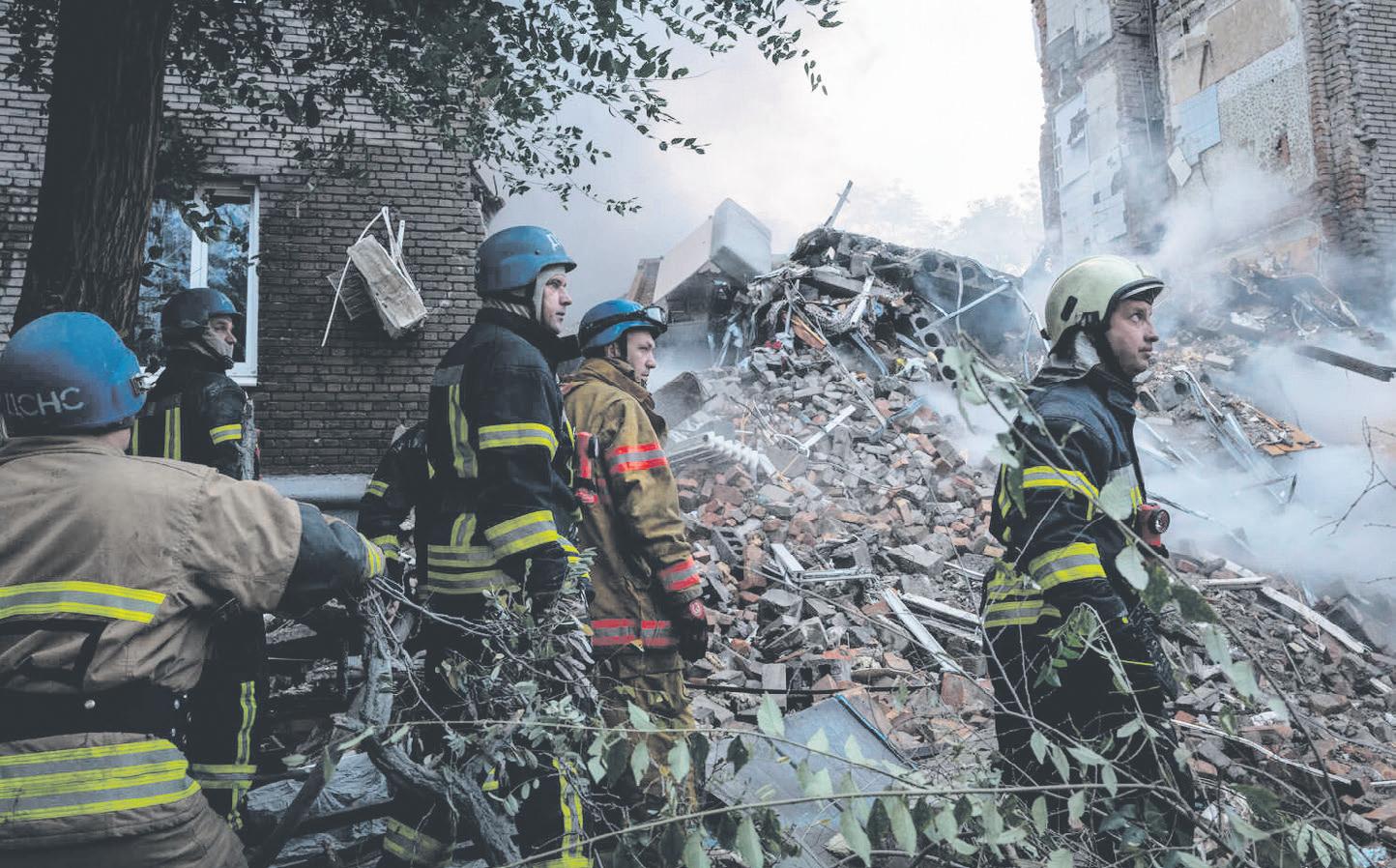
— The leaders of the Group of 7 nations will hold a vir tual summit today to discuss the latest developments in Ukrai ne, a European Union official said.
— The leader of Belarus, an ally of Putin’s, said thou sands of Russian troops would return to the country, a pos sible replay of the military buildup that preceded Moscow’s invasion. The Ukrainian military said Russia had launched dro nes from Belarusian territory as part of Monday’s attacks, and Moldova protested after it said Russian missiles fired from the Black Sea flew over its airspace.
External power had been restored to the Zaporizhzhia Nuclear Power Plant by Sunday night after repeated shelling caused an outage that lasted nearly two days, the chief of the United Nations’ nuclear watchdog, Rafael Mariano Grossi, said in a statement.
Grossi, the International Atomic Energy Agency’s ma naging director, is planning to visit Russia early this week for talks about establishing a safety zone around the plant in southern Ukraine, a goal that has received renewed ur gency after a series of attacks in the area the past week. Grossi was in Kyiv, Ukraine’s capital, on Thursday to begin the negotiations.
Early Saturday, Russian shelling caused the plant to lose access to external power, forcing it to rely on diesel generators to power safety equipment used to cool its re actors, according to Ukrainian officials. Russia’s Ministry of Defense blamed Ukrainian forces for the shelling, saying in a statement on Telegram that Ukrainian rockets had hit near the industrial zone and knocked out the power supply.
Grossi said in the statement that there has been she lling “almost every day now” around the plant, including “where the plant workers and their families live.”
The plant has been disconnected from external power at least twice before, and the availability of fuel to power the emergency generators has long been a concern. Even with all the reactors offline in what is known as a cold shut
down, essential equipment dedicated to cooling spent fuel rods needs a constant source of power.
Once power was restored Sunday, Grossi said in a Twitter post that it was a “temporary relief in a still untena ble situation.”
The Zaporizhzhia nuclear plant, the largest in Europe, has been at the center of active fighting since Russian forces seized it in March, raising concerns about a potential nu clear accident. Russian forces control the plant, but it is still being run by Ukrainian operators.
The Kremlin announced last week that it would take over operational control of the facility, introducing even more uncertainty. The IAEA said Thursday that it did not re cognize Russia’s claims to the plant.
AsUkrainian soldiers patrolled the streets of a small village they had retaken from the Russian army just days earlier, they found messages scrawled on walls and fences so dark and cryptic they pointed at least to poor morale, and possibly more serious mental stress.
“Give us back our people killed by witch es,” one note painted on a wall said. Another mes sage read, “Whatever we do we won’t leave this life alive.”
Nearby there were more tangible signs of a Russian army under assault: a blown-up bridge on the edge of town, and the obliterated remains of an armored personnel carrier littered the street, its chunks of metal scattered about and burned to a rich orange color.
The Russian military pulled out of Velyka Oleksandrivka, one of 29 towns and villages Ukraine has reclaimed in the southern Kherson region, last week; the few remaining older resi dents emerged from basements to greet Ukrainian soldiers.
Ukraine may gain more advantage in the region if the strike on the bridge to Crimea on Saturday seriously disrupts the supply line to Rus sian forces. Their situation was already tenuous enough that Russian commanders had requested pulling back from the city of Kherson, U.S. officials have said, but Russian President Vladimir Putin de nied it.
On Monday, Russia launched a series of missile strikes across Ukraine in what appeared to be retaliatory attacks for the blast that damaged the bridge to Crimea.
The Kherson region is one of two where Ukraine is pressing counteroffensives against the Russians. The other, moving more swiftly, is in the northeast and east.
But there are distinct differences between the two theaters of war. In the north, the Russian retreat was unplanned and chaotic, as soldiers fled the Ukrainian advance, fleeing on stolen bicycles and leaving behind documents, laundry and, more chillingly, dead comrades on the side of the road. Ukraine’s forces met little resistance.
In the south, Russian soldiers are dug in more securely, and while there are signs of low morale, there are also indications of a determina tion to fight. In one spot in Velyka Oleksandrivka, Ukrainian troops discovered that Russian soldiers had fired anti-tank missiles, leaving a heap of about 20 empty launch tubes under a birch tree.
And when retreats became the only option, they were apparently planned and much more or derly than in the north.
“It’s a different tempo here,” said Col. Ro man Kostenko, the commander of a unit fighting in
the south and chair of the defense and intelligence committee in the Ukrainian parliament, or Rada.
“The front did not crumble. They are retreating step-by-step into new defensive positions.”
In a pale fall sunshine of late afternoon, Kostenko drove past several of these steps on a journey into the reclaimed areas to inspect what the Russians had left behind, bumping over dirt roads. Outside one abandoned village, the sum mer’s harvest of grain burned in a warehouse, sending tendrils of smoke wafting over the road.
Along the route, he zigzagged past acacia trees knocked onto the road by artillery explosions — and an unexploded Grad rocket, which looked like a fence post hammered into the asphalt near the road’s centerline.
Because the road bridge was blown up, Velyka Oleksandrivka is accessible now from the west only by foot, requiring a scramble over a damaged footbridge crossing the Inhulets River.
The Russian army had used the village as a staging ground for tanks to reinforce a nearby town, Davydiv Brid. But when it fell to the Ukrai nians last week, the rationale for remaining appar ently disappeared.
They drove the tanks out before the Ukrai nian soldiers arrived Tuesday. They fired the antitank missiles at Ukrainian troops across the river. The Ukrainians dismounted, fanned out and en tered the village on foot. The Russian soldiers who remained retreated after a brief gunfight, soldiers in Kostenko’s unit said. While it marked a retreat, it did not convey fear and desperation like in the north, he said.
Two days later, shell casings and shards of shrapnel from the battle remained scattered around the streets, tinkling as the Ukrainian sol diers walked over them. The village was aban doned save for stray dogs and elderly residents.
Crumbling morale on the Russian side played a role in Ukraine’s advances in the south but the decisive factor was weaponry, tactics and troop numbers, Kostenko said.
The Russian government instituted a draft only last month, after it began losing ground in the counteroffensives, he noted. Ukraine called up soldiers immediately after the Russian invasion in February and these troops, some of them trained in Britain, are now entering the fight.
Ukraine now has a numerical advantage in soldiers in the fight on the western bank of the Dnieper River, where the village of Velyka Olek sandrivka is. This theater in the war is isolated from Russian supply lines by blown up bridges over the broad river.
The Ukrainian army waited on its attack until it amassed sufficient artillery systems and ar mored vehicles donated by Western allies to shift the odds, Kostenko said. In its initial assault on
Ukrainian soldiers riding in a captured Russian military vehicle in Velyka Oleksandrivka last week.
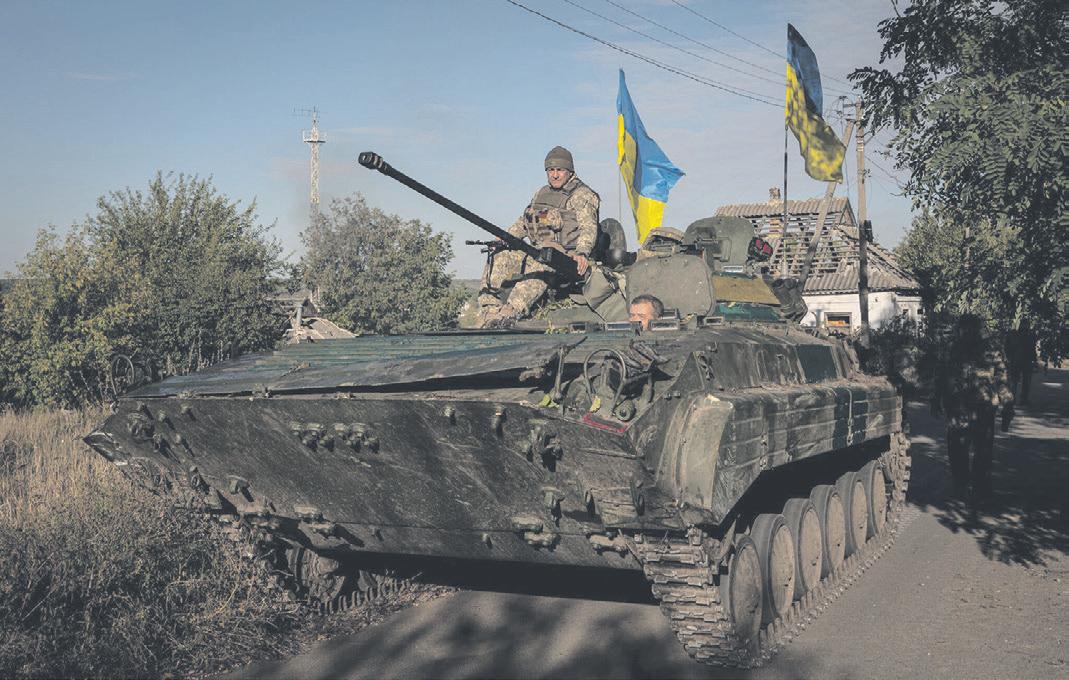
Russian lines near here in late August, for exam ple, the Ukrainian army sent U.S.-supplied M113 tracked armored vehicles bouncing over fields to storm the village of Sukhy Stavok. The armored vehicles enabled this decisive breakthrough, he said.
But a full Russian retreat from the west ern bank of the Dnieper River remains unlikely, Kostenko said. The city of Kherson is the only re gional capital the Russian army captured after its invasion in February and Putin has now claimed to have annexed the Kherson region and made it part of Russia.
And yet local Russian commanders in Kherson are pulling back in organized retreats to secondary lines of defense, to save their soldiers’ lives.
“They are defending it only for political rea

sons,” Kostenko said. “They cannot leave because Putin will lose face.”
Ukrainian officials have been trying to capi talize on poor Russian morale and promote the idea that Russian forces are pawns in the political messaging from Moscow.
Oleksii Reznikov, the Ukrainian minister of defense, appealed on Thursday to Russian officers in a speech in Russian, saying they were deceived by their political leadership, in an apparent ef fort to exploit dissatisfaction in the Russian ranks and officers’ corps. He specifically addressed the officers operating in the Kherson region on the Dnieper’s western bank.
“You were promised an easy ride but sent into a trap,” Reznikov said. “Now they don’t listen to you because listening to you now means admit ting mistakes.” He suggested they surrender.
rains and landslides have left at least 22 people dead and 52 missing in a single town in northcentral Venezuela, of ficials said Sunday.
Authorities believe that an unknown number of other people in the town, Las Tejerías, remain trapped in their homes by the mud.
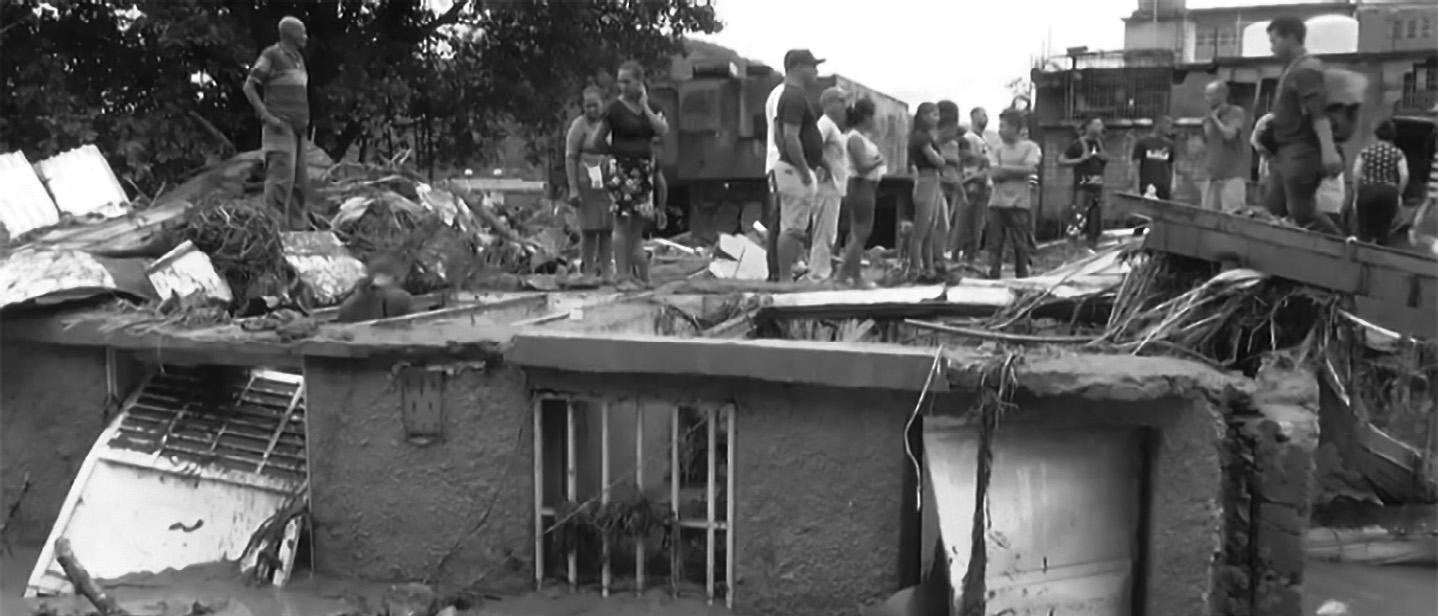
The Venezuelan armed forces planned to deploy canines and drones to find the missing residents and to deliver food and medicine, one top military of ficer, Remigio Ceballos, said at the news conference in Las Tejerías, about 40 miles southwest of the capital, Caracas.
Venezuela’s vice president, Delcy Rodríguez, said at the news conference that authorities were making every effort to get them out alive, but almost two dozen people were known to be dead.
“We have lost children, girls, all very regrettable,” Rodríguez said.
The rains began late Saturday afternoon, and intensified throughout the night. Over flowing streams carried away trees and electricity poles, and damaged homes and businesses. Cellphone service, already spotty in the region, was almost wiped out by the storm.
Some 20,000 homes throughout the surrounding Santos Michelena municipality were affected, according to the Red Cross in Aragua state.
On Sunday, Venezuela’s president, Nicolás Maduro, declared the area a disaster zone and announced three days of national mourning. His vice president said the government would provide shelter for victims, support for damaged businesses and aid to farmers who lost crops.
This is ordinarily Venezuela’s rainy season, but it has been especially bad this year.
“The effects of the climate crisis are causing this tragedy,” Rodríguez said.
On Sunday night, it was reported that it had started to rain again in the region.
Elsewhere in the region, a tropical storm, Julia, strengthened to a hurricane and set off flash flooding and mudslides in parts of Central America over the weekend.
Colombia’s president, Gustavo Petro, said on Twitter that Julia had left two injured, two houses destroyed and 101 damaged on the Colombian island of San Andres.
On Sunday morning, the hurricane made landfall in Nicaragua before weakening and becoming a tropical storm, bringing with it heavy rains.
The storm formed just 10 days after Hurricane Ian
made landfall in Florida, barreling across the state as a powerful Category 4 storm, destroying neighborhoods and infrastructure, unleashing floods, wiping out power and killing at least 120 people, according to state and local officials.
Ian, which later regained hurricane strength before making landfall in South Carolina, followed a relatively quiet start to the Atlantic hurricane season, which runs from June through November. There were only three named storms before Sept. 1 and none in August, the first time that has happened since 1997.
Storm activity picked up in early September with Danielle and Earl, which formed within a day of each other, and Ian, which formed on Sept. 26.
TheNobel Memorial Prize in Economic Sciences was awarded Monday to Ben Bernanke, the former Federal Reserve chair, and two other academics for their research into banks and financial crises.
Douglas W. Diamond, an economist at the University of Chicago, and Philip H. Dybvig at Washington University in St. Louis won the prize alongside Bernanke, who is now at the Brookings Institution in Washington.
Bernanke in 1983 wrote a paper that broke ground in explaining that bank failures can propagate a financial crisis rather than simply being a result of the crisis.
Diamond and Dybvig the same year wrote a paper on the risks inherent in maturity transformation, the process of turning short-term borrowing into long-term lending. Diamond also wrote about how banks monitor their borrowers, noting that knowledge about borrowers disappears upon bank
failures, extending the consequences of the upheaval.
“The laureates have provided a foundation for our modern understanding of why banks are needed, why they’re vulnerable, and what to do about it,” said John Hassler, an economist at the Institute for International Economic Studies at Stockholm University and a member of the prize committee.
Diamond spoke by phone at the news conference announcing the prize. Asked whether he had any warnings for banks and governments today, at a time when markets have been in turmoil as central banks around the world raise interest rates to fight rapid inflation, Diamond said that financial crises become worse when people begin to lose faith in the stability of the system.
“In periods when things happen unexpectedly — like, I think many people are surprised how rapidly nominal interest rates have gone up around the world — that can be something that sets off fears in the system,” he said. “The best advice is to be prepared, for making sure that your part of the banking
sector is both perceived to be healthy, and to stay healthy, and respond in a measured and transparent way to changes in monetary policy.”
But he added that the world is better prepared for any financial upheaval now than it was during the financial crisis in 2008, because “recent memories of that crisis” and regulatory improvements have made the banking system less vulnerable. He noted, however, that the vulnerabilities that he and Dybvig have identified extend beyond banks, and can bubble up in other parts of the financial system, like insurance firms or mutual funds.
The economics award, among the highest honors in the field, is not, technically, a Nobel Prize. It is called the Sveriges Riksbank Prize in Economic Sciences in Memory of Alfred Nobel because it wasn’t among the original categories that Alfred Nobel set out in his will in 1895. It is funded by Sweden’s central bank and has been given out only since 1969, though the Nobel committee promotes it and lists it on its website.
The landslides left at least 22 people dead and 52 missing in the Venezuelan town of Las Tejerías, about 40 miles southwest of the capital, Caracas.
Thehijabs that thousands of Iranian women and girls have been burning in defiance over the past few weeks — since the death of Mahsa Amini in the custody of Iran’s morality police on Sept. 16 — are a symbol of far broader discontent with Iran’s corrupt and incompetent leaders. The protests since Amini’s death, led by women, have persisted for weeks and have brought Iranians in dozens of cities into the streets to reveal the depth of their anger. Iranians who are sick and tired of living under a tyrannical theocracy deserve the support of the United States and its allies.

The death of Amini, who was detained by the guidance patrol for allegedly wearing her hijab improperly, is an outrageous sample of the violence the Islamic Republic has visited on women since coming to power in 1979. The religious cabal that has led Iran since then, currently led by Ayatollah Ali Khamenei, the supreme leader, regards enmity with the United States and keeping women in their place as critical to their survival in power.
The threat of a virulently anti-American and anti-Israeli regime obtaining nuclear weapons is real, but the diplomatic efforts to block it must go hand in hand with efforts to help Iranians who are seeking respite and change.
Khamenei is 83 and ailing, and he is among the last of the
Islamic revolutionaries who overthrew the monarchy. His passing, however, would be no guarantee of a more liberal regime in Iran. As Karim Sadjadpour of the Carnegie Endowment for International Peace wrote in a recent essay in The New York Times, his cohort of true believers has been largely supplanted by opportunists in search of wealth and privilege.
Global isolation may be damaging to the regime, but global integration would be dangerous, as Sadjadpour wrote. The regime might see its best chance of survival in maintaining repressive rule and “just the right amount of isolation.” Khamenei wants to be “neither North Korea nor Dubai. He wants to be able to sell Iran’s oil on the global market without sanctions, but he doesn’t want Iran to be fully integrated in the global system.”
Since Donald Trump ripped up the Iran nuclear deal in 2018 and reimposed sanctions, the Biden administration and other nations involved have been trying to revive it. That is a worthy effort, but negotiations for the deal, otherwise known as the Joint Comprehensive Plan of Action, are at a standstill over two Iranian conditions in particular that Western negotiators cannot meet: that the International Atomic Energy Agency end investigations into traces of uranium at undeclared sites, and that the United States provide guarantees the deal will not again be killed. It is up to Iran to choose whether to revive the deal, and its decision is not likely to be swayed by the U.S.’s behavior.

Whatever the future of the nuclear deal, its fate should not preclude the United States and its allies from vigorously supporting the desire of Iranian protesters for global integration, through better access to the essential tools of communication, organizing and protest.
The moral case is not solely the outrageous behavior of the clerical regime. It is also the fact that so much of the economic suffering of the Iranian people — rents that have multiplied, goods that have become prohibitively expensive, a currency that has plummeted so low that Iranians need stacks of bills to do everyday shopping — is the result of waves of U.S. sanctions.
The U.S. needs to maintain its efforts to prevent Iran from obtaining nuclear weapons, and this board supports continuing diplomatic efforts that could curtail Iran’s nuclear weapons program and open the door to future agreements. But some of the current sanctions have gone too far and fallen mostly on the very activists that the United States would like to help. Indeed, the regime has used Iran’s economic isolation to further entrench its power. The United States thus has a major stake in helping Iranians to a better life — ideally, one without sanctions, morality police or nuclear weapons.
The U.S. also has the ability to help improve access to one of the major tools of popular resistance: communications. Iranian dissidents have long complained that sanctions on technology hindered their ability to communicate with the outside world and with one another. Immediately after the Iranian government cut off access to the internet for most of its roughly 85 million citizens, the Biden administration did what it should have done long before, issuing a general license allowing technology firms to provide technical means for Iranians to elude government restrictions.
Making the announcement on Sept. 23, Secretary of State Antony Blinken declared that “we are going to help make sure the Iranian people are not kept isolated and in the dark.” The administration also imposed targeted sanctions on the morality police and senior security of ficials, whom it holds responsible for violence against protesters and Amini’s death. The U.S. can go further and encourage technology companies, including Google, Apple, Amazon and others, to make tools available and expedite applications for technology sales that go beyond the general license.
The current wave of protests may not force the clerics to move to a more open and tolerant government anytime soon. But every wave of protest over the years — 2009, 2017, 2019 and others — has stripped them of another layer of legitimacy. The current discontent, though so far not as widespread as earlier ones, is posing a challenge to one of the bedrock dogmas of the reactionary regime, and the calls in the street are no longer for reform. They are for revolution.
The Biden administration and its allies have made a good start by lifting restrictions on technology, adding targeted sanctions and condemning the death of Amini and the crackdown on subsequent protests. But that cannot be where U.S. support ends. The U.S. can build on that by making joint declarations with its allies, with academics and with nongovernmental organizations in support of the protests. It can also impose more sanctions against those who act as agents or mouthpieces of governmental repression, produce more Farsi-language broadcasts and push for a resolution at the United Nations Security Council.
These are not empty symbolic gestures; they are demonstrations of solidarity with people whose bravery is an example for the rest of the world and who have asked us to support their fight. Iran’s future as a prosperous and free nation rests with them.

CAGUAS – Con un corte de cinta los empresarios
Xiomara N. García Pantojas y Jaxier O. Colón To rres, abrieron el lunes las puertas de la estética médica XO Medical Esthetics. La estética, ubicada en Caguas, brindará cuidados de la piel, así como tratamientos médico-estético, cuidados pre y post-operatorios y técnicas innovadoras de relajación. Además de los tradicionales servicios de estética facial y corporal, cuidados posteriores a cirugías cosméticas, tratamien tos corporales, depilación láser, microblading, remo ción de tatuajes, dermopigmentación, entre otros.
“Estuvimos preparándonos profesionalmente para ofrecerle a nuestros clientes un servicio con los más altos estándares de calidad. Trabajamos en equipo para el bienestar y la pronta recuperación de nuestros clientes que se han sometido a procedimientos inva sivos, tales como cirugías cosméticas, que requieran cuidados especializados, uso de fajas y aplicación de terapias para cicatrizar de manera más rápida y segu ra. Nos especializamos en tratar clientes con afeccio nes presentes en la piel, tales como acné, melasma, celulitis, cicatrices, estrías, grasa localizada y estrés”, expresó la joven empresaria Xiomara N. García Pan tojas.
Por su parte, el joven empresario Jaxier O. Colón
Torres expresó que “apostamos a un concepto inno vador, moderno y novedoso. Traemos equipo de alta tecnología y tenemos una variedad de productos de la más alta calidad, naturales y de grado médico. Tam bién se le ofrecerán productos para el cuidado facial y corporal, para que el cliente pueda mantener los resultados desde el hogar. Contamos con una ubica ción céntrica, fácil de accesar y con estacionamiento. Nuestro servicio es completamente personalizado, ofrecemos toda una experiencia diseñada especial mente para cada cliente, en un ambiente de relaja ción y armonía”.
Por su parte, el honorable William Miranda Torres, alcalde del Municipio Autónomo de Caguas, expuso que “Reconocemos a estos estos jóvenes emprende dores y les agradecemos por haber escogido al Mu nicipio de Caguas, Centro y Corazón de Puerto Rico para plantar bandera y hacerse sentir en los servicios médicos estéticos en Caguas, la región y todo Puerto Rico”.
De su lado, la empresaria resaltó que “hay una ne cesidad en crecimiento de cuidados dirigidos a pa cientes pre y post operatorios. Este tipo de paciente requiere de cuidado especial e individual. Las esta dísticas reflejan un 96% de aumento en cirugías de todo tipo, pero en particular en cirugías plásticas, cos méticas, bariátricas, ortopedas y otras que requieren
de tratamientos diseñados de manera individual, de acuerdo con las necesidades de cada paciente”.
XO Medical Esthetics está ubicado en la Urb. Ma riolga S1 Ave. Luis Muñoz Marín Caguas, PR 00725, cerca del Hospital HIMA San Pablo, Caguas. Los in teresados en obtener más información sobre los ser vicios y productos que ofrecen, pueden acceder a la página web https://xomedicalesthetics.square.site/ También los pueden acceder a través de las redes so ciales, en Facebook como XO Medical Esthetics y en Instagram como @xomedical.esthetics. Para contac to directo se puede enviar un mensaje al (939) 2135505.

gó a la residencia ubicada en el sector la Gallera y encontró el cuerpo de Juan Rodríguez López, sin signos vitales.
LARES – Agentes del Precinto policíaco de Lares, investi gan el lunes un incidente en el que falleció un sexage nario en una residencia ubicada en el Barrio Callejones en Lares.
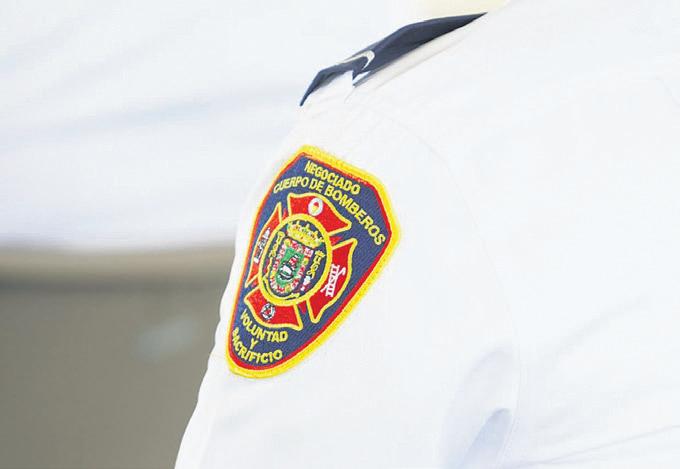
Según la Uniformada, personal del precinto de Lares lle
Preliminarmente se informó que el hombre cayó desde el techo de la residencia.
El agente Jonathan González investigó inicialmente y re firió el caso a la División Homicidios de Utuado, en donde el agente Emil Maldonado se hará cargo de la investigación.
J
UANA DÍAZ – Las autoridades investigan un incen dio que se entiende fue malicioso, a eso de las 10:20 de la noche del domingo, en el sector Cuevas del ba rrio Guayabal, en de Juana Díaz.
Según el reporte preliminar, se recibió una llamada al Sistema de Emergencias 9-1-1, sobre un incendio.
Bomberos de Juana Díaz extinguieron el incendio en el Colmado Maldonado e indicaron que posiblemente era malicioso. Los daños al momento no fueron valo rados.
La querella fue investigada por el agente José Ri vera del distrito de Juana Díaz. También, se estaría refiriendo a la división de Explosivos para la investi gación correspondiente.


Ina 1960 article in The New York Times, translator and critic José Vázquez Amaral reported “striking literary news from Mexico and Central America”: Women writers were “on the march.”
Among those at the vanguard, he wrote, were Am paro Dávila and Guadalupe Dueñas, Mexican authors whose eerie tales combined the fantastic with the every day and challenged daily constraints placed on women at the time. Before proceeding to a “somewhat less en thusiastic report” on the literary doings of men, Vázquez noted that, thanks to women, in no other period in Latin American history had “so many fine writers appeared so suddenly and triumphantly.”
Six decades later, Dávila’s and Dueñas’ literary ge nealogy — not to mention that of Jorge Luis Borges, Julio Cortázar and José Eustasio Rivera — is alive and well. In Mexico, Argentina, Ecuador and beyond, a conspicuous number of women writers are using fantasy, horror and the unfamiliar to unsettle readers and critique social ills. Prize committees, inside and outside Latin America, are taking note.
“It’s something we see across the region, a new sensibility,” said Carmen Alemany Bay, a literature pro fessor at the University of Alicante in Spain who coined the term “narrativa de lo inusual” (narrative of the un usual) to describe the current wave of writing from the region.
“They present situations in which the reader is ul timately the one who decides what is possible and what is not. That’s where the richness of this literature lies,” Alemany Bay said.
These “unusual” authors include Mexican writers Cecilia Eudave and Daniela Tarazona, Peruvian Clau dia Ulloa Donoso, Bolivian Giovanna Rivero, and many more. Their tales and techniques are diverse: Some are simply strange, as in Ulloa’s dreamlike 2021 short-sto ry collection, “Little Bird” (Deep Vellum). Others push more fully into fantasy, mixing with traditional gothic horror modes: In Mariana Enríquez’s monumental “Our Share of Night,” coming in February from Hogarth, an ailing medium who can connect with the dead tries to protect his son from an insatiable darkness.
That women writers, in particular, would be the ones to traverse the more shadowy corners of current Latin American fiction is perhaps no surprise, as a groundswell of frustration against restrictions on wom en’s rights and rising gender violence gathers force. Across the region, protest movements driven by women have become fixtures of the political landscape in re cent years.
But these stories have more in common than un canny coincidence and bumps in the night, Alemany Bay said. The “narrative of the unusual” often is socially conscious, explores womanhood in intimate and un conventional ways, and challenges the nature of our
closest personal relationships, she said. Depictions of normal life aren’t intended to heighten the effect of the fantastic or supernatural; instead, the unreal is used to sharpen readers’ view of what’s true.
“Many of these current works that leave the bounds of reality are called ‘magical realism,’ especially when they come from Latin America. But that’s a big, big mis take,” Alemany Bay said. “They may contain elements of magic, but that isn’t the foundation.”
Indeed, the recent success of these authors has al ready broadened what counts as great Latin American literature, where the “boom” of the ’60s and ’70s brought magical realists such as Gabriel García Márquez to the fore. This month, after earning prizes in Spain and Latin America, both Samanta Schweblin’s short-story collec tion “Seven Empty Houses,” out Oct. 18 from Riverhead, and Mónica Ojeda’s “Jawbone,” published in February by Coffee House Press, were named finalists for the Na tional Book Award for translated literature.
“Seven Empty Houses” is less pure fantasy than
Schweblin’s previous collection, “Mouthful of Birds.” But its stories are equally disquieting. Written while she was in the process of moving, first temporarily then long term, from Argentina to Berlin, the book is filled with a sense of displacement: An aging woman boxes up her life, a young girl walks away with a stranger, a mother and daughter sneak into the homes of the rich and rear range furniture. Throughout, Schweblin appears intent on picking apart her readers’ sense of permanence.
While uncanny, Schweblin’s work is also imbued with social critique: In “Seven Empty Houses,” prejudice and class divides are front and center. Her 2017 Man Booker-shortlisted novel, “Fever Dream,” offered a lit erary perspective on crop fumigation using glyphosate, a pesticide linked to birth defects in soybean-growing areas across Argentina, such as Aviá Teraí, a town near the country’s border with Paraguay.
“Literature is extremely political, but it is a politics that works best when it comes in spaces where no other politics can go, a more delicate space that doesn’t require the precision of saying, ‘OK, we’re going to talk about glyphosate because someone has to,’” Schweblin said.
True to form, Schweblin’s social commentary in “Fever Dream” straddles the space between the fantastic and the everyday, written entirely as a dialogue between a dying woman and a young boy who could be real or imagined. In a similar vein, Ojeda’s “Jawbone,” which centers on the kidnapping of a young woman by an ob sessive teacher, uses horror to explore the anxieties of adolescence and womanhood in modern Ecuador.
“We always link fear to ugliness, but I think above all it is linked to beauty,” Ojeda said via email. “The biggest fear we can experience is the loss of beauty. It seemed natural to think about adolescence from that perspective.”
Like Dueñas and Dávila before them, Ojeda and other contemporary writers in Latin America use dif ferent means to confront the often fraught realities for women in the region. But their form of feminism, such as it is, represents an “evolution” from the writing of the last century, Alemany Bay said.

In Argentina last year, there were 251 recorded femicides — the killing of women for being women — according to official figures. In Mexico, the number was 1,004. In “Witches,” published in August by Catapult, Mexican author Brenda Lozano used the space between the real and unreal to explore “different levels” of vio lence against women — from expectations about gen der roles to abuse and femicide.
The “witch” in Lozano’s novel defies presumptions about what women are supposed to be, she said, using language (and wild mushrooms) to heal the sick in ways modern medicine cannot.
“My superhero would be a woman who is able to do anything just with her words — change any narra tive, like an impossible poem that sees everything,” Lo zano said. “Maybe that was only possible with fiction.”
Argentine writer Samanta Schweblin, whose “Seven Empty Houses” is a National Book Award finalist for works in translation, in Seoul on Oct. 3, 2022. Ai ming to unsettle readers and offer social critique, writers like Schweblin and Mónica Ojeda are in a new vanguard.If
it wasn’t clear enough during the COVID-19 pandemic, it has become obvious during the monkeypox outbreak: The United States, among the richest, most advanced na tions in the world, remains wholly unprepared to combat new pathogens.
The coronavirus was a sly, unexpected adversary. Monkeypox was a familiar foe, and tests, vaccines and treatments were already at hand. But the response to both threats sputtered and stumbled at every step.
“It’s kind of like we’re seeing the tape replayed, except some of the excuses that we were relying on to rationalize what happened back in 2020 don’t apply here,” said Sam Scarpino, who leads pathogen surveillance at the Rockefell er Foundation’s Pandemic Prevention Institute.
No single agency or administration is to blame, more than a dozen experts said in interviews, although the Cen ters for Disease Control and Prevention has acknowledged that it bungled the response to the coronavirus.
The price of failure is high. COVID has killed more than 1 million Americans so far, yielding untold misery. Cas es, hospitalizations and deaths are all falling, but COVID was the third leading cause of death in the United States in 2021 and seems likely to keep killing Americans for years.
Monkeypox is spreading more slowly now, and has never posed a challenge of COVID’s magnitude. But the United States has reported more monkeypox cases than any other country — 25,000, about 40% of the global total — and the virus is likely to persist as a constant, low-grade threat.
Both outbreaks have revealed deep fissures in the nation’s framework for containing epidemics. Add to that plummeting public trust, rampant misinformation and deep schisms — between health officials and those treating pa tients, and between the federal government and states. A muddled response to future outbreaks seems almost inevi table.
“We really are poorly, poorly prepared,” said Larry O. Gostin, director of the O’Neill Institute for National and Global Health Law at Georgetown University.
New infectious threats are certainly on the way, most ly because of the twin rises in global travel and vaccine hes itancy, and the growing proximity of people and animals. From 2012 to 2022, for example, Africa saw a 63% increase in outbreaks of pathogens that jump to people from ani mals, compared with the period from 2001 to 2011.
“In people’s minds, perhaps, is the idea that this COV ID thing was such a freak of nature, was a once-in-a-century crisis, and we’re good for the next 99 years,” said Jennifer Nuzzo, director of the Pandemic Center at Brown Univer sity School of Public Health.
“This is the new normal,” she added. “It’s like the le vees are built for the one-in-a-100-years crisis, but then the
floods keep happening every three years.”
Ideally, here’s how the national response to an out break might unspool: Reports from a clinic anywhere in the country would signal a new pathogen’s arrival. Alternative ly, ongoing wastewater surveillance might sound the alarm for known threats, as it has recently for polio in New York state.
The information would flow from local health de partments to state and federal authorities. Federal officials would rapidly permit and offer guidance for the develop ment of tests, vaccines and treatments, rolling them out eq uitably to all residents.
Not one of these steps worked smoothly in the two recent outbreaks.
“I’m very familiar with outbreak response and pan demic preparedness, and none of it looks like this,” said Kristian Andersen, a virologist at the Scripps Research Insti tute in San Diego who has spent years studying epidemics.
Andersen said he had assumed that the flaws exposed by the coronavirus would be repaired as they became ap parent. Instead, “we’re worse prepared now than we were early in the pandemic,” he said.
Public health in the United States has always oper
ated on a shoestring. The data systems used by the CDC and other federal agencies are laughably out of date. Many public health workers were abused and attacked during the pandemic and have fled their jobs, or are planning to.
More money won’t solve all the problems, several ex perts said. But additional funding could help public health departments hire and train staff, update their aging data sys tems and invest in robust surveillance networks.
But in Congress, pandemic preparedness remains a tough sell.

President Joe Biden’s budget request for fiscal year 2023 includes $88 billion over five years, but Congress has not shown any inclination to approve it.
The United States spends between 300 to 500 times more on its military defense than on its health systems, and yet “no war has killed a million Americans,” noted Dr. Thomas R. Frieden, who led the CDC under former Presi dent Barack Obama.
The United States was supposed to be the very best at managing outbreaks. An assessment of global health se curity in 2019, a year before the arrival of the coronavirus, ranked the nation first among all others — best at prevent-
An installation on Sept. 15, 2021 blankets the National Mall in Washington with more than 660,000 white flags, honoring lives lost to the coronavirus in the United States up to that time.ing and detecting outbreaks, most adept at communicating risk and second only to the United Kingdom in the rapidity of its response.
But all of that assumed that leaders would move quickly and decisively when faced with a new pathogen, and that the public would follow instructions. The analyses did not account for an administration that underplayed and politicized every aspect of the COVID response, from test ing and masks to the use of vaccines.
Too often in a crisis, government officials look for easy solutions, with dramatic and immediate impact. But there are none for managing pandemics.
“A pandemic is by definition a problem from hell. You’re vanishingly unlikely to be able to remove all of its negative consequences,” said Bill Hanage, an epidemiolo gist at the Harvard T.H. Chan School of Public Health.
Instead, he added, officials should bet on combina tions of imperfect strategies, with an emphasis on speed over accuracy.
In both the coronavirus pandemic and the monkey pox outbreak, for example, the CDC at first tried to main tain control over testing, instead of disseminating the re sponsibility as widely as possible. The move led to limited testing, and left health officials blind to the spread of the viruses.
The Food and Drug Administration was slow to help academic labs develop alternatives for testing, and encour aged the highest quality of diagnosis. It may be reasonable for officials to ask which test is faster or which one produc es the least errors, Hanage said, but “all of them are better than not doing anything.”
Gostin, of Georgetown University, has worked with the CDC for most of his career, and was among its staunch est defenders early in the pandemic.
But he became increasingly disenchanted as the United States was forced to rely on other countries for vital information: How effective are boosters? Is the virus air borne? Do masks work?
“Virtually in every case, we got our information and acted on it from foreign health agencies, from the U.K., from Israel, from South Africa,” Gostin said. The CDC “al ways seemed to be last and weakest,” he said.
Many at the CDC and other health agencies seemed to be paralyzed, fearful of being held accountable if things go wrong, he added: “They’re covering their rear ends try
ing to follow the procedure. It all boils down to a lack of fire in their bellies.”
The most intractable hurdle to a coordinated nation al response arises from the division of responsibility and resources between federal, state and local governments, along with gaps in communications between the public health officials coordinating the response and the doctors and nurses actually treating the patients.
The complex laws that govern health care in the Unit ed States are designed to protect confidentiality and patient rights. “But they are not optimized for working with the public health system and getting the public health system the data that it needs,” said Dr. Jay Varma, director of the Cornell Center for Pandemic Prevention and Response.
Generally, states are not obligated to share health data, such as the number of cases of infection or demo graphic details of vaccinated people, with federal authori ties.
Some state laws actually forbid officials from sharing the information. Smaller states like Alaska may not want to hand over details that leave patients identifiable. Hospitals in small jurisdictions are often reluctant to surrender pa tient data for similar reasons.
Health care systems in countries like Britain and Isra el rely on nationalized systems that make it much easier to collect and analyze information on cases, said Dr. Anthony Fauci, the Biden administration’s top medical adviser.
“Our system isn’t interconnected like that,” Fauci

said. “It isn’t uniform — it’s a patchwork.”
A CDC official said the agency understood the per spective of the states, but the current rules on data sharing created “constraints and hurdles.”
“I don’t think it’s a matter of scapegoating states,” Kevin Griffis, a spokesman for the agency, said. “It’s simply a statement of the fact that we don’t have access to the in formation that we need to optimize a response.”
Legislation introduced in Congress might help re move those barriers, he added. The measure would require health care providers, pharmacies, and state and local health departments to report health data to the CDC.
Epidemics are managed by public health agencies, but it is clinicians — doctors, nurses and others — who diagnose and care for patients. An efficient outbreak re sponse relies on mutual understanding and exchange of information between the two groups.
The sides did not communicate effectively in either the COVID pandemic or the monkeypox outbreak. The dis connect has led to absurdly convoluted procedures.
The CDC has not yet included monkeypox in its dis ease reporting computer system, for example. That means state officials must manually type in data from case reports, instead of simply uploading the files. A request for test ing must often be faxed to the state laboratory; the results are often routed through a state epidemiologist, then to the provider, then to the patient.
Few public health officials understand how health care is delivered on the ground, some experts said. “Most people in the CDC don’t know what the inside of a hos pital looks like,” said Dr. James Lawler, co-director of the University of Nebraska’s Global Center for Health Security.
Frieden, who once led New York City’s health de partment, suggested that embedding CDC staff into local health departments might help officials understand the ob stacles involved in responding to an outbreak.
Frieden has also proposed what he calls a “7-1-7” accountability metric, loosely modeled on a strategy em ployed to address the HIV epidemic. Every new disease should be identified within seven days of emergence, re ported to public health authorities within one day and re sponded to within seven days.
From left: Dr. Rochelle Walensky, the CDC director, Dr. Anthony Fauci, the Biden administration’s top medical ad viser, and Dr. Robert Califf, the FDA commissioner, during a Senate hearing on monkeypox, on Capitol Hill in Wash ington on Sept. 14, 2022.
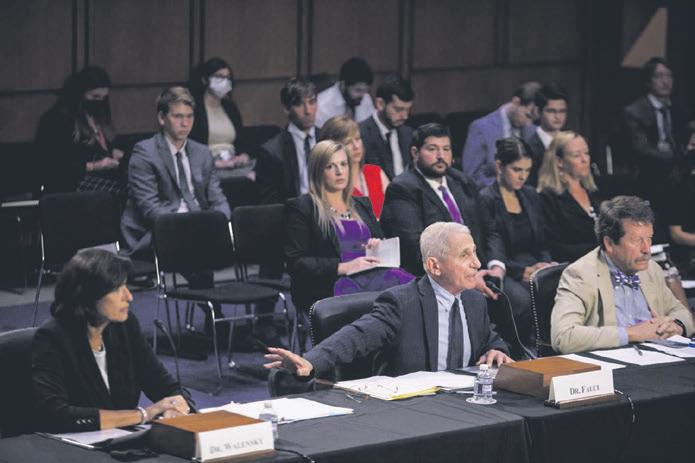
The strategy may give the government a clearer sense of the problems impeding the response, he said.
In the United States, “what we have is repeated cy cles of panic and neglect,” Frieden said. “The single most important thing we have to do is break that cycle.”
Itall started with a very large femur.
When Kevin Busscher dipped the scoop of his excavator into the soft Michigan soil last month, he knew the thigh bone he plucked from the dirt was far too big to have belonged to a cow or a horse. And he knew the culvert he was replacing would have to wait.
“My first thought was, ‘woolly mammoth!’ ” said Busscher, who reported his find to the county officials overseeing the project, who relayed photos of the bones to scientists.
As it turned out, he had found the skeleton of a mastodon, an elephant-like beast that roamed North America during the last ice age. By the next morning, a team of university and museum researchers had assembled to extract the rest of the bones. When they pulled out the mastodon’s massive jaw, several bright white teeth were still in place.
That discovery, a few feet below the ground between a rural road and a hayfield, was the latest in a long tradition of construction workers becoming accidental paleontologists.
Over the years, construction crews have stumbled upon horned dinosaurs in Colorado, horse bones dating back thousands of years in Nevada and a mammoth graveyard in South Dakota, turning job sites for new houses, backyard pools and government buildings into spontaneous science labs.

“As paleontologists, we wish that we could go out with this kind of heavy equipment and start cutting through, looking through hills and things like that, but we don’t really get to,” said Blaine Schubert, a professor at East Tennessee State University who oversees the Gray Fossil Site and Museum, which became a research area after workers on a highway project discovered a trove of bones in 2000.
There is a natural symbiosis between paleontology and construction, both professions where digging in the dirt is part of a day’s work. And because there are so many more construction workers than there are paleontologists, and because of the powerful machinery used for building, it makes sense that construction workers are often the first to uncover bones.
Joe Sertich, who until recently was the curator of dinosaurs at the Denver Museum of Nature & Science, said he routinely heard from people who thought they may have found notable fossils. Sometimes they were false alarms or relatively minor finds, like common fish fossils or bones so badly damaged by construction equipment that they held limited scientific value. But every now and then, construction workers stumbled into major discoveries.
He helped excavate thousands of ice age fossils, including mammoths, mastodons, camels, plants and insects, at the site of a reservoir expansion in Snowmass Village, Colorado. And in the Denver suburbs, at two separate construction sites, one for a police and fire station and another for an assisted living facility, workers turned up horned dinosaur
remains.
“I put together huge expeditions around the country to go out and spend eight weeks digging in remote field areas, looking for things like horned dinosaurs,” Sertich said. “And it turns out that some of those finds are sitting right in our own backyards.”
In Hot Springs, South Dakota, work on a housing development stopped abruptly in the 1970s when workers found the skeleton of a mammoth. When Jim I. Mead and other paleontologists went there and started digging, they found another skeleton, and then another. The site, Mead said, turned out to be a long-ago sinkhole pond where mammoth after mammoth drowned after finding itself unable to climb out. The housing developer agreed to stop building, and decades later, mammoths are still being uncovered there.
“We’re totally lucky,” said Mead, now the director of research at the Mammoth Site, which hosts tourists, school groups and scientists. “It’s just phenomenal that this person said, ‘I want this to be preserved.’ ”
There can sometimes be tension between science and construction. Unlike with human remains and Native American cultural artifacts, there is often no legal requirement in the United States to report paleontological finds on privately owned land, meaning that some animal bones end up being plowed over or sold to private collections instead of turned over for study. And given the tight deadlines facing many construction projects, calling in scientists can be seen as an expensive diversion from the task at hand.
Earlier this year in Utah, construction equipment damaged a set of rare dinosaur footprints on federal land, bringing criticism that paleontologists had not been more involved in supervising the site.
When Tennessee road workers found what became the Gray Fossil Site more than two decades ago, converting the place into a permanent research area required intervention from the governor and money to reroute the highway that was supposed to go there. In the years since, East Tennessee State University has started a paleontology program, thousands of visitors have stopped at the museum and scientists have unearthed bones dating back about 5 million years, including red pandas, rhinos, tapirs and alligators, providing a unique lens into prehistoric Appalachia.
“It’s telling us what these forests were like at this time, when we had no idea what they were like millions of years on either side,” said Schubert, who oversees the site, where excavations continue. He added, “It was a tremendously expensive endeavor to save this fossil site, and I don’t know if something like that would happen today.”
Scientists know in general terms where dinosaur bones or ice age remains are most likely to be discovered: in places where sediments or sedimentary rock strata of the right age are now close to the surface and may be exposed by natural erosion or construction work. Much of North America meets that description, though, and exactly where important new
fi
nds may lie hidden is largely a matter of chance.
Dan Wagner, a construction inspector in the Denver area, was helping oversee the building of the police and fire station in Thornton, Colorado, a few years ago when he found a hunk of bone where crews were drilling holes for concrete piers. The bone came from deep in the ground, suggesting that it was probably very old. He wondered, “‘Could this be a dinosaur, even?’ ”
When he dug some more and unearthed a much larger bone, the site managers halted work in that area. Over the next couple weeks, as work continued on other parts of the new building, Sertich and other paleontologists excavated a largely intact Torosaurus in a small, fenced-off section of the building site. Wagner said he would sometimes check on progress during his breaks, and would join in the digging when his workday ended.
“I’ve never been into dinosaurs before, but I was superexcited,” said Wagner, who got a tattoo of the Torosaurus and later took his children to see it displayed at a museum. “I’d go to bed wondering what the heck it was, and how many bones were going to be there.”
Laura Emmert, a lab and field technician at the Gray Fossil Site and Museum in Tennessee, brushes away dirt from a tapir skull.der shredded meat as an opportunity to experiment with seasonings and other sauces. Lately, I’ve enjoyed hot ground chile in the rub and mild dried chiles in the braising liquid, which I blend into sauce. This preparation is as inspired by pulled pork as it is by carne con chile rojo, and it works just as well between buns as it does wrapped in tortillas.
The natural sweetness of pork shoulder means it can take on a variety of flavors, so you’ll always end up with a dish everyone loves. That it can take as little as half an hour of your attention or become a leisurely day cooking outside is just another reason to make it anytime you want.
salt. If the pork came tied, untie it and unroll it. If it has a thick layer of fat, score the fat with a sharp knife. Rub the spice mixture all over the meat.
2. If you’d like to marinate the meat, place the pork fat side up in a Dutch oven or other heavy pot if the pot can fit in your refrigerator and cover. Or place the meat in a bowl and cover it, or set it in a resealable plastic bag. Refrigerate to marinate for as much time as you have, preferably overnight (and up to 1 full day).
3. If you’d like to give your meat a smoky flavor, you can smoke it for an hour or so in a charcoal grill set up for indirect grilling with wood chips strewn over the coals. Then, transfer it to a Dutch oven or pot, cover and bake as directed below.
Pulled pork in New York,
By GENEVIEVE KOrequired can be relaxing or stressful, depending on, well, you.
Inside
the white brick walls of Rodney Scott’s Whole Hog BBQ in Charleston, South Carolina, past the bright dining room, is the pit room, the walls, floors and equipment shades of copper and black. There, pork slowly barbecues over hardwood that has been burned into coals, prepared with the craft that Scott, a chef and a founder of the restaurant, learned from his family.
The meaty smoke was as heavy as a wool blanket and smelled so good, I wanted to gather a handful of air and eat it. Watching the cooks kindle the embers, mop racks of ribs with sauce and turn enormous sides of meat, it quickly became clear that true whole hog barbecue is best left to pitmasters.
The rest of us may not be able to capture the woodsy nuances of pit-smoked pork, but anyone can prepare and share the joy that is pulled pork. Spice-rubbed pork shoulder cooked slowly with low heat sweetens naturally and eventually falls apart with a gentle nudge. It takes time for the meat to soften, but the energy and hours you put in can range widely.
A slow cooker makes for the easiest preparation, and a pressure cooker turns out the fastest version, but for anyone lured by fire — with a whole day to spare — a backyard charcoal grill version of pit cooking is within reach. It takes 14 hours or so, and the tending
But if you don’t have a day to dedicate to smoking meat — or, let’s be honest, the desire — you can easily replicate the taste without the commitment.
What’s amazing about wood smoke is that it infuses raw meat right away, so letting it swirl around a fat-marbled shoulder for even an hour gives pork a halo of that unmistakable barbecue scent. This is my preferred method, especially for parties. Set up a charcoal grill for indirect grilling, then push the glowing coals to one side before putting the pork on the other. Toss fragrant wood chips and chunks over the coals, and quickly close the lid, sliding the vents open a sliver.
After an hour or two, you can transfer the pork to a Dutch oven and pour in a half-inch of water, stock, soda or cider, slipping in onions or garlic if you like. Once you cover the pot and put it in the oven, you can leave it alone until the pork collapses.
You can also skip outdoor smoking altogether and leave the pork in the oven from start to finish. An initial blast of dry high heat caramelizes it before low heat tenderizes the meat. You can ignore the pork during those hours of slow baking, then return to it for a quick run under the broiler at the end. That will give the meat a little smokiness and create crispy bits.
The Southern dish “pulled pork” is often doused with barbecue sauce. But I see its ten-
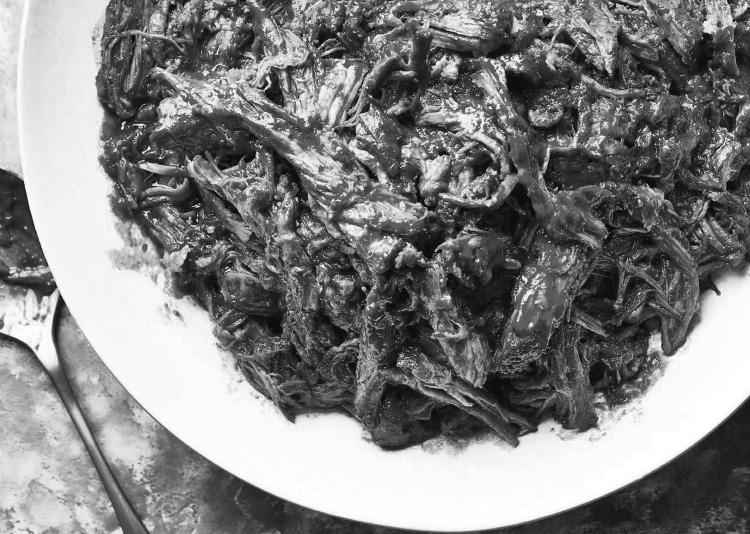
This is party eating — and still easy enough to pull off for dinner whenever you want. Saucy and satisfying, it’s the type of dish that feels festive. Pulled pork from the American South ranges in styles, but usually balances the natural sweetness of the meat, slowly cooked until it slouches into tenderness, with tanginess and spice. Here, ground and whole dried chiles season the meat and blend into a sauce with fruity complexity and mild heat. The preparation is as inspired by barbecue pulled pork as it is by carne con chile rojo. That means that the glossy hunks and slivers of meat taste as good piled into buns as they do over rice or stuffed into tortillas.
Yield: 8 to 12 servings
Total time: 4 1/2 hours
Ingredients:
3 tablespoons raw or brown sugar, plus more to taste
1 tablespoon ground chipotle or other hot ground chile
1 tablespoon onion powder
2 teaspoons garlic powder
1 teaspoon smoked paprika
1 teaspoon ground black pepper
Kosher salt (such as Diamond Crystal)
1 (4-pound) boneless pork butt or shoulder roast
1 large onion, chopped
2 tablespoons neutral oil, such as canola
10 dried guajillo chiles (2 to 3 ounces)
2 teaspoons distilled white vinegar, plus more to taste
1. In a small bowl, stir together the sugar, chipotle, onion powder, garlic powder, smoked paprika, black pepper and 1 tablespoon kosher
4. If you’re not smoking your meat, you can cook it in the oven from start to finish. About 4 hours before you want to eat, heat the oven to 425 degrees. Take the pork out of the refrigerator and let stand while the oven heats. Uncover the meat. Set it fat side up, transferring it to a Dutch oven or pot if needed. Scatter the onion around the meat and sprinkle with salt. Drizzle the oil all over the meat and onion.
5. Roast until the onion browns and the pork fat crackles a bit, about 20 minutes. Meanwhile, snap the stems off the chiles and discard them, then snap the chiles in half. Shake out their seeds and discard them.
6. Drop the chiles on top of the onion. Add 2 1/2 cups water, cover the pot and reduce the oven temperature to 300 degrees. Cook until the meat is tender enough to fall apart when speared with a fork, about 3 1/2 hours.
7. Transfer the pork to a sheet pan. If you’d like the meat to have crispy charred bits, heat the broiler. Broil the pork until deeply browned in spots but try not to burn it. It will still be very tasty if you skip this broiling step. While the pork broils or rests, stir the vinegar into the hot cooking liquid in the pot. If you’d like, you can skim the fat off the surface of the cooking liquid. Transfer everything in the pot to a blender and blend until very smooth. Taste and add more sugar, vinegar and salt, if you’d like.
8. Slide the pork back into the pot and shred with two forks. Pour enough of the sauce over the meat to evenly coat and stir to combine. If the mixture has cooled, heat it over low until simmering. Serve hot, with any extra sauce on the side. This dish keeps well in the refrigerator for up to 3 days and in the freezer for up to 3 months. Reheat, stirring now and then, in a microwave or over medium-low heat on the stovetop.
UNITED STATES DISTRICT COURT FOR THE DISTRICT OF PUERTO RICO.
UNITED STATES OF AMERICA (Small Business Administration)
Plaintiff v. JOHN DOE AND RICHARD ROE as those unknown persons who may be the holders of the lost mortgage note or have any interest in this proceeding, Defendants
CIVIL NO. 22-01331. ACTION FOR CANCELLATION OF LOST MORTGAGE NOTE (Esperanza Inn, Corp.). SUM MONS BY PUBLICATION.
Unknown holders of a pro missory note of $342,000.00 executed on July 8, 2008, by Esperanza Inn. Corp., as ack nowledged by affidavit number 3,631 sworn before Miguel B. Hernández Vivoni, and secured by a voluntary mortgage in favor of the plaintiff created by Mort gage Deed No. 54 executed on July 8, 2008, before Notary Public Miguel B. Hernández Vi voni, over the following proper ties, described in the Spanish language as: RÚSTICA: Parce la marcada con el número 103 en el Plano de Parcelación de la Comunidad Rural Esperan za del Barrio Puerto Real, del término municipal de Vieques, Puerto Rico, con una cabida superficial de 0.2951 cuerdas, equivalentes a 1,159.99 me tros cuadrados, en lindes por el NORTE, con la parcela número 102 de la Comunidad; por el SUR, con la parcela 104 de la Comunidad; por el ESTE, con la parcela número 165 de la Comunidad; y por el OESTE, con la Calle número 1 de la Co munidad. Contiene una casa de vivienda construida de bloques en concreto y torta de hormi gón que mide 18x18 y consta de sala, cocina, 2 cuartos dor mitorios y servicios sanitarios. The aforementioned Mortgage Deed is duly recorded in the Registry Property of Fajardo, at page 116, volume 83 of Vie ques, property number 1,649, eleventh inscription. Pursuant to the Order for Service by Pu blication entered on August 11, 2022 by the Honorable Aida M. Delgado-Colon, United States District Judge (Docket No. 4), you are hereby SUMMONED to appear, plead or answer the Complaint filed herein no
later than thirty (30) days after publication of this Summons by serving the original plea or answer in the United States District Court for the District of Puerto Rico, and serving a copy to counsel for plaintiff Pedro Jaime López Bergollo, Esq., at SBA District Office for the Dis trict of PR & USVI, 273 Ponce de León Ave., Suite 510, Pla za 273, San Juan, PR 009171930, telephone numbers (787) 766-5269T.h is Summons shall be published by edict once a week for six (6) consecutive weeks in a newspaper of ge neral circulation in the Island of Puerto Rico. Should you fail to appear, plead, or answer to the Complaint as ordered by the Court and noticed by this Sum mons, the Court will proceed to hear and adjudicate this cause against you based on the relief demanded in the Complaint.
BY ORDER OF THE COURT, summons is issued pursuant to 28 U.S.C. §1655, Fed. R. Civ. P. 4(e) and Rule 4.5 of the Rules of Civil Procedure for the Commonwealth of Puerto Rico.
In San Juan, Puerto Rico, this 15th day of August, 2022. MA RIA ANTONGIORGI-JORDAN, ESQ., CLERK, U.S. DISTRICT COURT. By: Viviana Diaz, De puty Clerk.
UNITED STATES DISTRICT COURT FOR THE DISTRICT OF PUERTO RICO. UNITED STATES OF AMERICA
(Small Business Administration)
Plaintiff v. JOHN DOE AND RICHARD ROE as those unknown persons who may be the holders of the lost mortgage note or have any interest in this proceeding, Defendants CIVIL NO. 22-cv-1244 RAM.
ACTION FOR CANCELLATION OF LOST MORTGAGE NOTE (Gregorio Narvaez Torres d/b/a D’Millenium Dry Cleaners). SUMMONS BY PUBLICATION.
TO: JOHN DOE AND RICHARD ROE
Unknown holders of a promis sory note of $280,000.00 exe cuted on November 11, 2005, by Gregorio Narvaez Torres d/b/a D’Millenium Dry Cleaners, as acknowledged by affidavit number 24,259 sworn before Manuel L. Correa Marquez, and secured by a voluntary mortgage in favor of the plaintiff created by Mortgage Deed No. 204 executed on November 11,
2005 before Notary Public Ma nuel L. Correa Marquez, over the following property, descri bed in the Spanish language as: URBANA: Solar radicada en el Barrio Cerro Gordo del termino municipal de Bayamon, con una cabida superficial de 2,035.2925 metros cuadrados, siendo el remanente luego de una expropiaci6n de 137.8723 metros cuadrados. En lindes por el NORTE, en 29.86 me tros, con solar propiedad del senor Hector Santiago Vazquez y en 15.89 metros, con terrenos propiedad de la Sucesi6n de Juan Reyes Villanueva; por el SUR, en 75.00 metros y 30.66 metros, respectivamente, con el remanente de la finca princi pal de la cual se segrega; por el ESTE, en 75.00 metros y 30.66 metros, respectivamente, con el remanente de la finca principal de la cual se segrega y por el OESTE, en 25.00 me tros, con la Carretera Estatal 167. Es el remanente luego de una expropiaci6n de 137 .8723 metros cuadrados, que se re laciona al margen del folio 250 del tomo hist6rico de Bayamon. ESTRUCTURA: Estructura dividida en cuatro espacios, los cuales se describen a con tinuaci6n: El espacio No.1 con un area superficial de 36 pies½ de largo por 17 pies 6 pulgadas de ancho, el espacio No. 2, con un area superficial de 23 pies 4 pulgadas de ancho por 36 pies y ½ de largo, el espacio No. 3, con un area superficial de 36 pies y ½ de largo por 23 pfes 4 pulgadas de ancho y el espacio No. 4 con un area superficial de 36 pies y 1/2 de largo por 23 pies 4 pulgadas de ancho, construida dicha estructura mitad en cementa y otra mitad en aluminio, dedicada para fines comerciales, la cual tie ne una cabida total de 90 pies cuadrados de largo por 36 pies cuadrados de ancho. Dicha es tructura consta de dos bafios, conectados a un pozo muro y “rolling doors”, con un valor de $50,000.00, segun consta de la escritura #79, otorgada en San Juan, el 7 de junio de 2006, ante el notario Manuel L. Co rrea Marquez. The aforementio ned Mortgage Deed is duly re corded in the Registry Property of Bayamon, First Section, at page 90, volume 1825 of Baya mon, property number 44,415, sixth inscription. Pursuant to the Order for Service by Publi cation entered on 09/07/2022 by the Honorable Raul M. Arias Marxuach,United States District Judge (Docket No. 4), you are hereby SUMMONED to appear, plead or answer the Complaint
filed herein no later than thirty’ (30) days after publication of this Summons by serving the original plea or answer in the United States District Court for the District of Puerto Rico, and serving a copy to counsel for plaintiff Pedro Jaime Lopez Bergollo, Esq., at SBA District Office for the District of PR & USVI, 273 Ponce de Leon Ave., Suite 510, Plaza 273, San Juan, PR 00917-1930, telephone numbers (787) 7665269. T. his Summons shall be published by edict once a week for six (6) consecutive weeks in a newspaper of ge neral circulation in the Island of Puerto Rico. Should you fail to appear, plead, or answer to the Complaint as ordered by the Court and noticed by this Sum mons, the Court will proceed to hear and adjudicate this cause against you based on the relief demanded in the Complaint. BY ORDER OF THE COURT, sum mons is issued pursuant to 28 U.S.C. §1655, Fed. R. Civ. P. 4(e) and Rule 4.5 of the Rules of Civil Procedure for the Com monwealth of Puerto Rico. In San Juan, Puerto Rico, this 7th day of September, 2022. MA RIA ANTONGIORGI-JORDAN, ESQ., CLERK - U.S. DISTRICT COURT. By: Ana Duran-Cape lla, Deputy Clerk.
ESTADO LIBRE ASOCIADO DE PUERTO RICO TRIBU NAL DE PRIMERA INSTANCIA CENTRO JUDICIAL DE SAN JUAN SALA SUPERIOR BANCO POPULAR DE PUERTO RICO
Demandante Vs. KAREN RODRIGUEZ
Demandados Civil Núm.: SJ2022CV03351. Sala: 508. Sobre: COBRO DE DINERO Y EJECUCIÓN DE HI POTECA (VÍA ORDINARIA). EDICTO DE SUBASTA. El Al guacil que suscribe por la pre sente CERTIFICA, ANUNCIA y hace CONSTAR: Que en cum plimiento de un Mandamiento de Ejecución de Sentencia que le ha sido dirigido al Alguacil que suscribe por la Secretaría del TRIBUNAL DE PRIMERA INSTANCIA CENTRO JUDI CIAL DE SAN JUAN, SALA SU PERIOR, en el caso de epígra fe procederá a vender en pública subasta al mejor postor en efectivo, cheque certificado en moneda legal de los Esta dos Unidos de América el 25 DE OCTUBRE DE 2022, A LAS 9:00 DE LA MAÑANA, en su
oficina sita en el local que ocu pa en el edificio del TRIBUNAL
DE PRIMERA INSTANCIA
CENTRO JUDICIAL DE SAN JUAN, SALA SUPERIOR, todo derecho, título e interés que tenga la parte demandada de epígrafe en el inmueble de su propiedad que ubica en: COND. PUERTA DEL SOL APT. 305 SAN JUAN, PR 00926 y que se describe a con tinuación: RÚSTICA: PROPIE
DAD HORIZONTAL: Aparta mento número tres cero cinco (305): Apartamento residencial número tres (3) del Condominio Puerta del Sol, que ubica en la Carretera Estatal número cien to ochenta y uno (181) del Ba rrio Sabana Llana de Río Pie dras, Municipio de San Juan, Puerto Rico, con una cabida superficial de seiscientos cin cuenta y dos punto ochenta y ocho pies cuadrados (652.88 p.c.) siendo sus medidas linea les treinta y dos pies con diez pulgadas de largo (32’10”) por veintidós pies con ocho pulga das de ancho (22’8”); en lindes por el NORTE, en una distancia de veintidós pies con ocho pul gadas (22’8”) con el Aparta mento número trescientos seis (306); por el SUR, en distancia de diecisiete pies con nueve pulgadas (17’9”) con el Aparta mento número trescientos cua tro (304); por el ESTE, en una distancia de treinta y dos pies con diez pulgadas (32’10”) con el pasillo central del edificio; y por el OESTE, en una distancia de treinta y dos pies con diez pulgadas (32’10”) con terrenos donde enclava el edificio. La puerta principal del Apartamen to tiene acceso al pasillo central del piso. Esta unidad residen cial consta de lo siguiente: salacomedor, baño, pasillo con cló set, cocina y tres cuartos dormitorios con su clóset cada uno. El apartamento tiene un porciento de participación en los elementos comunes gene rales de punto cero cero cuatro dos cero dos cero (.0042020). A este apartamento le correspon de como elemento común limi tado el estacionamiento núme ro ciento ochenta (180). La propiedad antes relacionada consta inscrita al Folio 1 del Tomo 973 de Sabana Llana, fin ca número 32,113-A, Registro de la Propiedad de San Juan, Sección Quinta. El tipo mínimo para la primera subasta del in mueble antes relacionado, será el dispuesto en la Escritura de Hipoteca, es decir la suma de $76,700.00. Si no hubiere re mate ni adjudicación en la pri mera subasta del inmueble mencionado, se celebrará una
SEGUNDA SUBASTA en las oficinas del Alguacil que suscri be el día 1RO DE NOVIEMBRE
DE 2022, A LAS 9:00 DE LA MAÑANA. En la segunda su basta que se celebre servirá de tipo mínimo las dos terceras partes (2/3) del precio pactado en la primera subasta, o sea la suma de $51,133.33. Si tampo co hubiere remate ni adjudica ción en la segunda subasta se celebrará una TERCERA SU BASTA en las oficinas del Al guacil que suscribe el 8 DE NOVIEMBRE DE 2022, A LAS 9:00 DE LA MAÑANA. Para la tercera subasta servirá de tipo mínimo la mitad (1/2) del precio pactado para el caso de ejecu ción, o sea, la suma de $38,350.00. La hipoteca a eje cutarse en el caso de epígrafe fue constituida mediante la es critura de hipoteca 185 otorga da en San Juan, Puerto Rico, el día 30 de diciembre de 2004, ante el Notario Jeremíah Oca sio Silva inscrita al Tomo Karibe de Sabana Llana, finca número 31-113-A, inscripción 9na, Re gistro de la Propiedad de San Juan, Sección Quinta. Dicha subasta se llevará a cabo para con su producto satisfacer al Demandante total o parcial mente según sea el caso el im porte de la Sentencia que ha obtenido ascendente a la suma de $54,982.56 por concepto de principal, desde el 1ro de mayo de 2019, más intereses al tipo pactado de 5.50% anual que continúan acumulándose hasta el pago total de la obligación. Además, la parte demandada adeuda a la parte demandante los cargos por demora equiva lentes a 4.00% de la suma de aquellos pagos con atrasos en exceso de 15 días calendarios de la fecha de vencimiento; los créditos accesorios y adelantos hechos en virtud de la escritura de hipoteca; y las costas, gas tos y honorarios de abogado equivalentes a $7,670.00. Que los autos y todos los documen tos correspondientes al Proce dimiento incoado estarán de manifiesto en la SECRETARIA
DEL TRIBUNAL DE PRIMERA
INSTANCIA CENTRO JUDI
CIAL DE SAN JUAN, SALA SU
PERIOR durante las horas la borables. Se entenderá que todo licitador acepta como bas tante la titulación del inmueble y que las cargas y gravámenes anteriores y los preferentes, si los hubiere, al crédito del ejecu tante continuarán subsistentes entendiéndose que el rematan te los acepta y queda subroga do en la responsabilidad de los mismos, sin destinarse a su extinción el precio de remate. La propiedad está sujeta a los
siguientes gravámenes anterio res y/o preferentes según las constancias del Registro de la Propiedad. Condiciones Res trictivas de ocupación y uso por un término de 30 años, según la escritura número 54, otorga da en San Juan, el 23 de sep tiembre de 1992. ante el notario Alfredo Castro Mesa, e inscrito al folio 1 del tomo 973 de Saba na Llana, finca número 32,113A, inscripción 3ra. Surge de un estudio de título que, sobre la finca descrita anteriormente, pesa el gravamen posterior a la hipoteca que se ejecuta me diante este procedimiento que se relaciona a continuación: Hi poteca en garantía de un paga ré a favor de la Autoridad para el Financiamiento de la Vivien da de Puerto Rico, o a su or den, por la suma principal de $10,000.00, sin intereses, ven cedero el día 30 de diciembre de 2012, constituida mediante la escritura número 186, otor gada en San Juan, Puerto Rico, el día 30 de diciembre de 2004, ante el notario Jeremiah Ocasio Silva, e inscrita al tomo Karibe de Sabana Llana, finca número 32,113A, inscripción 10ma. Su jeta a Condiciones Restrictivas a favor de la Autoridad para el Financiamiento de la Vivienda de Puerto Rico, bajo el Progra ma “La Llave para tu Hogar”, por un término de 8 años. Por la presente se notifica a los acree dores conocidos y desconoci dos que tengan inscritos, no inscritos, presentados y/o ano tados sus derechos sobre los bienes hipotecados con poste rioridad a la inscripción del cré dito del ejecutante o acreedo res de cargas o derechos reales que los hubiesen pos puesto a la hipoteca del actor y a los dueños, poseedores, te nedores de o interesados en tí tulos transmisibles por endoso o al portador garantizados hipo tecariamente con posterioridad al crédito del actor que se cele brarán las subastas en las fe chas, horas y sitios señalados para que puedan concurrir a la subasta si les conviniere o se les invita a satisfacer antes del remate el importe del crédito, de sus intereses, otros cargos y las costas y honorarios de abo gado asegurados quedando subrogados en los derechos del acreedor ejecutante. La pro piedad objeto de ejecución y descrita anteriormente se ad quirirá libre de cargas y gravá menes posteriores una vez el Honorable Tribunal expida la correspondiente Orden de Con firmación de Venta Judicial. Y para conocimiento de licitado res del público en general se publicará este Edicto de acuer
do con la ley por espacio de dos semanas en tres sitios públicos del municipio en que ha de ce lebrarse la venta, tales como la Alcaldía, el Tribunal y la Colec turía. Este Edicto será publica do dos veces en un diario de circulación general en el Estado Libre Asociado de Puerto Rico, por espacio de dos semanas consecutivas. Expido el presen te Edicto de subasta bajo mi firma y sello de este Tribunal en San Juan, Puerto Rico, hoy día 15 de septiembre de 2022. ED WIN E. LÓPEZ MULERO, AL GUACIL AUXILIAR, ALGUACIL DE SUBASTAS, TRIBUNAL DE PRIMERA INSTANCIA, CEN TRO JUDICIAL DE SAN JUAN, SALA SUPERIOR.
***
ESTADO LIBRE ASOCIADO DE PUERTO RICO TRIBU NAL DE PRIMERA INSTANCIA SALA SUPERIOR DE CA GUAS

Demandante V. BANCO Y AGENCIA DE FINANCIAMIENTO DE LA VIVIENDA DE PUERTO RICO; SONIA BERRIOS LOPEZ;
JUAN DEL PUEBLO Y JUANA DEL PUEBLO Y CUALESQUIER PERSONA DESCONOCIDA CON POSIBLE INTERÉS EN LA OBLIGACIÓN CUYA CANCELACIÓN POR DECRETO JUDICIAL SE SOLICITA
Demandados
Civil Núm.: CG2022CV02293. Sobre: CANCELACIÓn de pa garé EXTRAVIADO. EMPLA ZAMIENTO POR EDICTO. ESTADOS UNIDOS DE AMÉ RICA, EL PRESIDENTE DE LOS ESTADOS UNIDOS, EL ESTADO LIBRE ASOCIADO DE PUERTO RICO, SS.
A: SONIA BERRIOS LOPEZ.
Por la presente se le notifica que ha sido presentada en este Tribunal una Demanda en su contra en el pleito de epígrafe. En este caso la parte deman dante ha radicado una Deman da para que se decrete judicial mente el saldo de un (1) pagaré hipotecario a favor de Banco y Agencia de Financiamiento de la Vivienda de Puerto Rico por la suma de $80,350.00. Dicho pagaré fue suscrito el día 19 de julio de 2001, ante el nota rio Rita Lynne Rodríguez De La Roca, garantizado por hipoteca constituida mediante la Escri tura número 101 otorgada en
San Juan, Puerto Rico, inscrita al folio móvil del tomo 1594 de Caguas, finca número 28,063, inscripción 6ta. Se describe la propiedad a continuación: PROPIEDAD HORIZONTAL:
URBANA: Apartamento #1701 del Edificio Caguas Tower, ubicado en la Calle Z, Esquina Ciprés, de las Urbanizaciones Bonneville y Villa Turabo del término municipal de Caguas. El apartamento está situado en el Ala Este de la planta 17 del Edificio, que da hacia el área de estacionamiento. Su puerta de entrada abre contrario al ves tíbulo o pasillo que comunica al apartamento con el vestíbu lo central de la planta, donde se encuentran situados los ascensores y las 2 escaleras interiores del Edificio. Consta de 3 dormitorios, 2 baños, salacomedor, cocina, lavandería y balcón. Colinda por el Oeste, en 25’ 6”, con el apartamento 1702, en 8’ 0”, con el exterior, y en 10’ 0”, con el pasillo; por el Este, en 33’ 0”, con el exte rior, que da hacia el área de estacionamiento; por el Sur, en 25’ 6”, con el exterior, que da hacia una calle de entrada a las terrenos del Edificio; y por el Norte, en 25’ 6”, con el apartamento 1708. El área total es de 974.82 pies cuadrados.
El porciento que representa del conjunto inmueble es de .65228%. Corresponde a este apartamento el espacio de su igual número para estacionar un automóvil. Finca número 28,063, inscrita al folio 78 del tomo 844 de Caguas. Registro de la Propiedad de Puerto Rico, Sección I de Caguas. La parte demandante alega que dicho pagaré ha sido saldado según más detalladamente consta en la Demanda radicada que pue de examinarse en la Secretaría de este Tribunal. Por tratarse de una obligación hipotecaria y pudiendo usted tener interés en este caso o quedar afecta do por el remedio solicitado, se le emplaza por este edicto que se publicará una vez en un periódico de circulación diaria general de Puerto Rico. Usted deberá presentar su alegación responsiva a través del Sis tema Unificado de Manejo y Administración de Casos (SU MAC), al cual puede acceder utilizando la siguiente direc ción electrónica: https://unired. ramajudicial.pr/sumac/, salvo que se represente por derecho propio, y notifique con copia de ella a la abogada de la parte demandante la Leda.
Zilmarie
Delgado Pieras, 33 Calle Re solución, Suite 302, San Juan, PR 00920-2727; Tel. (787) 7826500, dentro de los treinta (30) días siguientes a la publicación de este Edicto, apercibiéndole que de no hacerlo así dentro del término indicado, el Tribu
nal podrá anotar su rebeldía y dictar sentencia concediendo el remedio solicitado en la De manda sin más citarle ni oírle.
EXPEDIDO bajo mi firma y sello de este Tribunal, en Ca guas, Puerto Rico, hoy día 12 de septiembre de 2022. LISIL
DA MARTÍNEZ AGOSTO, SE CRETARIA. CARMEN L. SOTO PLANAS, SUB-SECRETARIA.
ESTADO LIBRE ASOCIADO DE PUERTO RICO TRIBU
NAL DE PRIMERA INSTANCIA SALA SUPERIOR DE COAMO. REVERSE MORTGAGE FUNDING LLC.
Demandante vs. SUCESION JOSE ISMAEL COLON COLON COMPUESTA POR JOSE MANUEL COLON MORALES, LUZ DE LOS ANGELES COLON MORALES, JOSE IRAN COLON MORALES, NYDIA IVETTE COLON MORALES, RAMONITA COLON MORALES; JOHN DOE Y JANE DOE COMO POSIBLES HEREDEROS DESCONOCIDOS; SUCESION MARIA ISABEL MORALES MORALES COMPUESTA POR JOSE MANUEL COLON MORALES, LUZ DE LOS ANGELES COLON MORALES, JOSE IRAN COLON MORALES, NYDIA IVETTE COLON MORALES, RAMONITA COLON MORALES; JOHN ROE Y JANE ROE COMO POSIBLES HEREDEROS DESCONOCIDOS; ESTADOS UNIDOS DE AMERICA; CENTRO DE RECAUDACION DE INGRESOS MUNICIPALES Demandados CIVIL NUM. CO2021CV00206.
SOBRE: EJECUCION DE HI POTECA. EDICTO DE SUBAS TA. ESTADOS UNIDOS DE AMERICA EL PRESIDENTE DE LOS ESTADOS UNIDOS EL ESTADO LIBRE ASOCIA DO DE PUERTO RICO. SS..A: La Parte Demandada, al (a la) Secretario(a) de Hacienda de Puerto Rico y al Público Gene ral: Certifico y Hago Constar: Que en cumplimiento con el Mandamiento de Ejecución de Sentencia que me ha sido diri gido por el (la) Secretario(a) del Tribunal de Primera Instancia, Sala Superior de Coamo, en el caso de epígrafe, venderé en pública subasta y al mejor pos tor, por separado, de contado y por moneda de curso legal de los Estados Unidos de América y/o Giro Postal y Cheque Cer
tificado, en mi oficina ubicada en el Tribunal de Primera Ins tancia, Sala de Coamo, el 7 de noviembre de 2022, a las 10:00 de la mañana, todo derecho título, participación o interés que le corresponda a la parte demandada o cualquiera de ellos en el inmueble hipotecado objeto de ejecución que se des cribe a continuación: URBANA: Parcela de terreno en la Urba nización Extensión Jardines de Coamo, situada en el Ba rrio San Ildefonso del término municipal de Coamo, Puerto Rico, marcado con el numero cuarenta y siete (47) del Bloque
F con un área superficial de TRESCIENTOS DIECISIETE
PUNTO VEINTICINCO ME
TROS CUADRADOS (317.25 M/C). En lindes por el NORTE, en once punto setenta y cinco metros (11.75 m.) con el solar número quince F (15-F); por el SUR, en once punto setenta y cinco metros (11.75 m.) con la Calle número nueve (9); por el ESTE, en veintisiete metros (27.00 m.) con el solar número cuarenta y ocho (48) del Bloque
F; y por el OESTE, en veintisie te metros (27.00 m.) con el so lar número cuarenta y seis (46) del Bloque F. Inscrita al folio 260 del tomo 146 de Coamo, finca 8,369, Registro de la Pro piedad de Barranquitas. Propie dad localizada en: EXTENSION JARDINES DE COAMO, F-47 CALLE 9, COAMO, PUERTO RICO 00769. Según figuran en la certificación registral, la propiedad objeto de ejecución está gravada por las siguientes cargas anteriores o preferen tes: Nombre del Titular: N/A.
Suma de la Carga: N/A. Fecha de Vencimiento: N/A. Según figuran en la certificación re gistral, la propiedad objeto de ejecución está gravada por las siguientes cargas posterio res a la inscripción del crédito ejecutante: Nombre del Titular: Secretario de la Vivienda y De sarrollo Urbano. Suma de la Carga: $148,500.00. Fecha de Vencimiento: 1 de octubre de 2089. Se entenderá que todo licitador acepta como bastante la titularidad de la propiedad y que todas las cargas y gra vámenes anteriores y los pre ferentes al crédito ejecutante antes descritos, si los hubiere, continuarán subsistentes. El rematante acepta dichas car gas y gravámenes anteriores, y queda subrogado en la res ponsabilidad de los mismos, sin destinarse a su extinción el precio del remate. Se establece como tipo de mínima subasta la suma de $148,500.00, según acordado entre las partes en el precio pactado en la escritura de hipoteca. De ser necesa ria una segunda subasta por declararse desierta la primera, la misma se celebrará en mi
oficina, ubicada en el Tribunal de Primera Instancia, Sala de Coamo, el 14 de noviembre de 2022, a las 2:00 de la tarde, y se establece como mínima para dicha segunda subasta la suma de $99,000.00, 2/3 par tes del tipo mínima establecido originalmente. Si tampoco se produce remate ni adjudicación en la segunda subasta, se es tablece como mínima para la tercera subasta, la suma de $74,250.00, la mitad (1/2) del precio pactado y dicha subasta se celebrará en mi oficina, ubi cada en el Tribunal de Primera Instancia, Sala de Coamo, el 21 de noviembre de 2022, a las 2:00 de la tarde. Dicha subasta se llevará a cabo para, con su producto satisfacer a la parte demandante, el importe de la Sentencia dictada a su favor ascendente a la suma de $71,711.33 de principal, más los intereses, los recargos y demás créditos contenidos en la escritura de hipoteca reverti da. La venta en pública subas ta de la referida propiedad se verificará libre de toda carga o gravamen posterior que afecte la mencionada finca, a cuyo efecto se notifica y se hace sa ber la fecha, hora y sitio de la PRIMERA, SEGUNDA Y TER CERA SUBASTA, si esto fuera necesario, a los efectos de que cualquier persona o perso nas con algún interés puedan comparecer a la celebración de dicha subasta. Se notifica a todos los interesados que las actas y demás constancias del expediente de este caso están disponibles en la Secretaría del Tribunal durante horas la borables para ser examinadas por los (las) interesados (as). Y para su publicación en el periódico The San Juan Daily Star, que es un diario de cir culación general en la isla de Puerto Rico, por espacio de dos semanas consecutivas con un intervalo de por lo menos siete (7) días entre ambas pu blicaciones, así como para su publicación en los sitios públi cos de Puerto Rico. Expedido en Coamo, Puerto Rico, hoy 13 de septiembre de 2022. Juan O Burgos Burgos, Alguacil Re gional. Rodolfo Lara Martinez, Alguacil.
ESTADO LIBRE ASOCIADO DE PUERTO RICO TRIBU NAL DE PRIMERA INSTANCIA SALA MUNICIPAL DE LAS MARÍAS COOPERATIVA DE AHORRO Y CRÉDITO DE RINCÓN (ANTES COOPERATIVA DE AHORRO Y CRÉDITO DE AÑASCO)
Parte Demandante Vs SARAHÍ RUIZ
RIVERA (SOCIO NÚM. 31108625) SU ESPOSO FULANO DE TAL Y LA SOCIEDAD LEGAL DE GANANCIALES COMPUESTA POR AMBOS
Parte Demandada Civil Núm.: LM2022CV00023. Sobre: COBRO DE DINERO (REGLA 60). EDICTO. A : SARAHÍ RUIZ RIVERA, SU ESPOSO
FULANO DE TAL Y LA SOCIEDAD LEGAL DE GANANCIALES COMPUESTA POR AMBOS.
Se le apercibe que la parte de mandante por mediación del Lcdo. Rafael Fabre Colón, P.O. Box 277, Mayagüez, Puerto Rico 00681, Tel. 787-265-0334, ha radicado la acción de epí grafe en su contra. Copia de la demanda, emplazamientos y del presente edicto le ha sido enviado por correo a la última dirección conocida. Pueden us tedes obtener mayor informa ción sobre el asunto revisando los autos en el Tribunal. Se le apercibe que tiene usted un tér mino de treinta (30) días para radicar contestación a dicha demanda de cobro de dinero y/o cualquier escrito que estime usted conveniente a través del Sistema Unificado de Manejo y Administración de Casos (SU MAC), al cual puede acceder utilizando la siguiente direc ción electrónica: https://unired. ramajudicial.pr, salvo que se represente por derecho propio, en cuyo caso deberá presentar su alegación responsiva en la Secretaria del Tribunal de epí grafe, pero que de no radicarse escrito alguno ante el Tribunal dentro de dicho término el Tri bunal procederá a ventilar el procedimiento sin más citarle ni oírle. Dada en Añasco, Puer to Rico, hoy 27 de septiembre de 2022. JAILENE ACEVEDO GUZMÁN, SECRETARIA AU XILIAR DEL TRIBUNAL.
ESTADO LIBRE ASOCIADO DE PUERTO RICO TRIBU NAL DE PRIMERA INSTANCIA SALA SUPERIOR DE CA GUAS
GITSIT SOLUTIONS, LLC
Demandante Vs. MIGUELINA LEBRON SCHETINI T/C/C MIGUELINA LEBRON SCHETTINI
Demandados
Civil Núm.: CG2018CV03054.
Sobre: COBRO DE DINERO Y EJECUCIÓN DE HIPOTE CA POR LA VÍA ORDINARIA. EDICTO DE SUBASTA. ESTA DOS UNIDOS DE AMÉRICA, EL PRESIDENTE DE LOS ES
Certifico y Hago Constar: Que en cumplimiento con el Manda miento de Ejecución de Senten cia que me ha sido dirigido por el (la) Secretario(a) del Tribunal de Primera Instancia, Sala Su perior de Caguas, en el caso de epígrafe procederá a vender en pública subasta al mejor postor en efectivo, cheque ge rente, giro postal, cheque certi ficado en moneda legal de los Estados Unidos de América al nombre del Alguacil del Tribu nal de Primera Instancia, en mi oficina ubicada en el Tribunal de Primera Instancia, Sala de Caguas, el 2 DE NOVIEMBRE DE 2022 A LAS 10:30 DE LA MAÑANA, todo derecho título, participación o interés que le corresponda a la parte deman dada o cualquiera de ellos en el inmueble hipotecado objeto de ejecución que se describe a continuación: URBANA: Solar radicado en la Calle Eugenio Maria de Hostos del Municipio de Caguas, Puerto Rico, mar cado con el número 8 con una cabida superficial de 165.24 metros cuadrados. En lindes por el NORTE, en 20.40 metros con el solar de Manuel Váz quez, viuda de Pacheco; por el SUR, en 20.40 metros con el solar de Rafael Acevedo; por el ESTE, en 8.20 metros con la Calle Eugenio María de Hostos y por el OESTE, en 8.00 metros con solar Domingo Díaz. Sobre dicho solar enclava una casa. Finca #4359, inscrita al folio 146 del tomo 124 de Caguas, Registro de la Propiedad de Caguas, Sección Primera. Pro piedad localizada en: 8 Calle Euigenio Maria De Hostos, Ca guas, PR 00725. Según figuran en la certificación registral, la propiedad objeto de ejecución está gravada por las siguientes cargas anteriores o preferen tes: Nombre del Titular: N/A. Suma de la Carga: N/A. Fecha de Vencimiento: N/A. Según figuran en la certificación re gistral, la propiedad objeto de ejecución está gravada por las siguientes cargas posteriores a la inscripción del crédito ejecu tante: Nombre del Titular: N/A. Suma de la Carga: N/A. Fecha de Vencimiento: N/A. Se enten derá que todo licitador acepta como bastante la titularidad de la propiedad y que todas las cargas y gravámenes anterio res y los preferentes al crédito ejecutante antes descritos, si los hubiere, continuarán sub sistentes. El rematante acepta dichas cargas y gravámenes
anteriores, y queda subrogado en la responsabilidad de los mismos, sin destinarse a su ex tinción el precio del remate. Se establece como tipo mínimo de subasta la suma de $54,590.00, según acordado entre las par tes en el precio pactado en la escritura de hipoteca. De ser necesaria una SEGUNDA SU BASTA por declararse desierta la primera, la misma se cele brará en mi oficina, ubicada en el Tribunal de Primera Instan cia, Sala de Caguas, el 9 DE
NOVIEMBRE DE 2022 A LAS
10:30 DE LA MAÑANA, y se establece como mínima para dicha segunda subasta la suma de $36,393.33, 2/3 partes del tipo mínimo establecido origi nalmente. Si tampoco se pro duce remate ni adjudicación en la segunda subasta, se estable ce como mínima para la TER
CERA SUBASTA, la suma de $27,295.00, la mitad (1/2) del precio pactado y dicha subasta se celebrará en mi oficina, ubi cada en el Tribunal de Primera Instancia, Sala de Caguas, el 17 DE NOVIEMBRE DE 2022
A LAS 10:30 DE LA MAÑA
NA. Dicha subasta se llevará a cabo para, con su producto satisfacer a la parte demandan te, el importe de la Sentencia dictada a su favor ascendente a la suma de $47,031.74 de principal, intereses al tipo del % anual según ajustado desde el día 1 de mayo de 2017 hasta el pago de la deuda en su totali dad, más la suma de $5,459.00 por concepto de honorarios de abogado y costas autorizadas por el Tribunal, más las canti dades que se adeudan men sualmente por concepto de seguro hipotecario, cargos por demora, y otros adeudados que se hagan en virtud de la escri tura de hipoteca. La venta en pública subasta de la referida propiedad se verificará libre de toda carga o gravamen poste rior que afecte la mencionada finca, a cuyo efecto se notifica y se hace saber la fecha, hora y sitio de la PRIMERA, SEGUN
DA Y TERCERA SUBASTA, si esto fuera necesario, a los efec tos de que cualquier persona o personas con algún interés puedan comparecer a la cele bración de dicha subasta. Se notifica a todos los interesados que las actas y demás cons tancias del expediente de este caso están disponibles en la Secretaria del Tribunal durante horas laborables para ser exa minadas por los (las) interesa dos (as). Y para su publicación en el periódico The San Juan Daily Star, que es un diario de circulación general en la isla de Puerto Rico, por espacio de dos semanas consecutivas con un intervalo de por lo menos siete (7) días entre ambas publica ciones, así como para su pu blicación en los sitios públicos
de Puerto Rico. Expedido en Caguas, Puerto Rico, hoy día 3 de octubre de 2022. NATALIA SUÁREZ ORTIZ, ALGUACIL AUXILIAR PLACA #089.
ESTADO LIBRE ASOCIADO DE PUERTO RICO TRIBU NAL DE PRIMERA INSTANCIA CENTRO JUDICIAL DE MAYA GÜEZ SALA SUPERIOR FRANCISCO GELPI
Demandado
Civil Núm.: SG2022CV00340. (Salón 0206). Sobre: COBRO DE DINERO Y EJECUCIÓN DE HIPOTECA. EMPLAZA MIENTO POR EDICTO. ESTA DOS UNIDOS DE AMÉRICA, EL PRESIDENTE DE LOS ES TADOS UNIDOS, EL ESTADO LIBRE ASOCIADO DE PUER TO RICO.
A La Parte Demandada: LANDMARK COMMERICAL CENTERS, INC. CARR. 2 KM. 171.0 BO. GUAMA, SAN GERMAN, PR 00683; PO BOX 80000, PMB 395, ISABELA, PR 00662; PO BOX 1284, ISABELA, PR 00662.
Por la presente se le(s) notifica que se ha radicado en la Se cretaría de este Tribunal una Demanda sobre Ejecución de Hipoteca In Rem por la vía ordi naria contra la parte demanda da LANDMARK COMMERICAL CENTERS, INC., en la cual se alega que la parte deman dada adeuda las siguientes sumas las cuales serán satis fechas cuando se ejecute el crédito / gravamen hipoteca rio, las cuales se describen a continuación: $6,120,000.00 y $237,963.50 en concepto de principal, más intereses al tipo pactado al 6.25% cada hipoteca ($5,320.625.00 y $78,081.67 respectivamente) desde el 17 de agosto de 2007 y del 7 de febrero de 2017 res pectivamente. Dichos intereses continúan acumulándose hasta el pago total de las obligacio nes en virtud de las Escrituras de Hipotecas y pagarés; y las costas, gastos y honorarios de abogado equivalentes al 10% del importe del pagaré de cada uno es decir $612,000.00 y $23,796.35 respectivamente. Este Tribunal ha ordenado que se le(s) cite a usted(es) por edicto y que se publicará una sola vez en un periódico de cir culación general. Se le(s) em plaza y requiere que dentro de los treinta (30) días siguientes a la publicación de este edicto
excluyendo el día de la publica ción de este edicto conteste(n) la demanda presentando su alegación responsiva a través del Sistema Unificado de ma nejo y Administración de Casos (SUMAC), al cual puede acce der utilizando la siguiente direc ción electrónica https://unired. ramajudicial.pr, salvo que se represente por derecho propio, en cuyo caso deberá presentar su alegación responsiva en la Secretaría del Tribunal y en viando copia de la Contestación de la Demanda a las oficinas de
Lcdo. Alberto Fuertes Masaro vic; PMB 191 PO Box 194000, San Juan, PR 00919-4000 / tel. 787-296-0000 / abogados@ fuerteslaw.com. Abogados de la Parte Demandante. Se le(s) advierte que si dejare(n) de contestar la Demanda en el período de tiempo antes men cionado. podrá dictarse contra usted(es) Sentencia en Rebel día, concediéndose el remedio solicitado sin más citarle(s) ni oírle(s). EXPEDIDO bajo mi fir ma y con el Sello del Tribunal. DADA hoy 30 de septiembre de 2022, en Mayagüez, Puerto Rico. LCDA. NORMA G. SAN TANA IRIZARRY, SECRETA RIA REGIONAL. ALEXANDRA MARIE LÓPEZ, SECRETARIA AUXILIAR DEL TRIBUNAL.
ESTADO LIBRE ASOCIADO DE PUERTO RICO TRIBU NAL DE PRIMERA INSTANCIA SALA SUPERIOR DE CARO LINA
BANCO POPULAR DE PUERTO RICO
Demandante V. SUCESIÓN RAMON VIZCARRONDO
LEDESMA T/C/C RAMON ANTONIO VIZCARRONDO
LEDESMA T/C/C RAMON ANTONIO VIZCARRONDO LEDESMA COMPUESTA POR SUS HEREDEROS FRANCISCA LOPEZ T/C/C FRANCISCA LOPEZ PADIN, RAMON VIZCARRONDO LOPEZ Y ROSA MARIA VIZCARRONDO LOPEZ; TODAS PARTES
DESCONOCIDAS, RECLAMANDO POR, A TRAVES, BAJO O CONTRA VIZCARRONDO
LEDESMA T/C/C RAMON ANTONIO VIZCARRONDO
LEDESMA QUIENES NO SON CONOCIDOS, SI VIVOS O MUERTOS, IRRESPECTIVAMENTE
SI DICHAS PARTES
DESCONOCIDAS
PUEDEN RECLAMAR
UN INTERESA COMO CONYUGE, HEREDERO LEGATARIO, CESIONARIO U OTRO RECLAMANTE; POSEEDOR DESCONOCIDO A; POSEEDOR DESCONOCIDO B; ESTADOS UNIDOS DE AMERICA
Demandados
Civil Núm.: FCD2014-1026. Sa lón Núm.: 403. Sobre: COBRO DE DINERO Y EJECUCIÓN DE HIPOTECA POR LA VIA ORDINARIA. EDICTO DE SU BASTA. LOS ESTADOS UNI DOS DE AMÉRICA, EL PRESI DENTE DE LOS E.E. U.U., EL ESTADO LIBRE ASOCIADO DE PUERTO RICO, SS. Yo, MANUEL VILLAFAÑE BLAN CO, Alguacil del Tribunal Supe rior de Puerto Rico, Sala de Carolina, al público HAGO SA BER: Que en cumplimiento de un Mandamiento de Ejecución de Sentencia que se me libró con fecha de 30 de diciembre de 2015 por la Secretaria de este Tribunal, en el caso de epí grafe, venderé en pública su basta y al mejor postor con di nero en efectivo, cheque de gerente o letra bancaria con si milar garantía, todo título, dere cho o interés de la parte de mandada de epígrafe sobre la siguiente propiedad pertene ciente a la parte demandada, la cual se describe a continua ción: URBANA: Solar radicado en la Calle José De Diego del Municipio de Carolina, Puerto Rico, compuesto de ciento se tenta y dos metros cuadrados con setenta centímetros y en lindes: por el NORTE, en dieci nueve metros ochenta y cinco centímetros con solar municipal ocupado por Ángel Luis Mundo; por el SUR, en diecinueve me tros ochenta y cinco centíme tros con solar municipal ocupa do por Ángel Fidalgo Díaz; por el ESTE, en ocho metros con ocho metros setenta centíme tros con la Calle José De Diego; y por el OESTE, en ocho me tros setenta centímetros con otro solar municipal ocupado por Santiago Cardero. Enclava una casa terrera de madera te chada de zinc. Número 55,032 (antes 5,156), inscrita al folio 19 del tomo 1,294 de Carolina. Re gistro de la Propiedad de Puer to Rico, Sección I de Carolina. La finca 55,032 está gravada con la siguiente hipoteca cuya ejecución se solicita en la su basta objeto de este edicto: Hi poteca en garantía de un paga ré a favor de Popular Mortgage, Inc., o a su orden, por la suma principal de $101,000.00 con intereses al 8% anual, vence dero a la presentación, consti tuida mediante la escritura nú mero 237, otorgada en San
Juan, Puerto Rico, el día 23 de noviembre de 1999, ante la no tario Luz E. Vela Gutiérrez, e inscrita al tomo veintiocho (28) de Carolina, finca número 5,156, inscripción 1era. La pro piedad está afecta a los si guientes gravámenes: a. Hipo teca en garantía de un pagaré a favor de Popular Mortgage Inc., o a su orden, por la suma prin cipal de $101,000.00, con inte reses al 8% anual, vencedero a la presentación, constituida me diante la escritura número 237, otorgada en San Juan, Puerto Rico, el día 23 de noviembre de 1999, ante el notario Luz E. Vela Gutierrez, e inscrita al folio 1 del tomo 1,292 de Carolina, finca número 55,032, inscrip ción 2da. b. Hipoteca en garan tía de un pagaré a favor del Departamento de la Vivienda y Desarrollo Urbano, o a su or den, por la suma principal de $101,000.00, con intereses al 8% anual, vencedero a la pre sentación, constituida mediante la escritura número 238, otor gada en San Juan, Puerto Rico, el día 23 de noviembre de 1999, ante la notario Luz E. Vela Gutiérrez, e inscrita al folio 1 del tomo 1,292 de Carolina, finca número 55,032, inscrip ción 3ra. c. Aviso de Demanda de fecha 25 de agosto de 2014, expedido en el Tribunal de Pri mera Instancia, Sala Superior de Carolina, en el Caso Civil número FCD2014-1026, sobre cobro de dinero y ejecución de hipoteca, seguido por Banco Popular de Puerto Rico, contra Sucesión Ramón Vizcarrondo Ledesma, compuesta por here deros desconicodos, Francisca López Padin; Estados Unidos de América, por la suma de $178,448.30, más intereses y otras sumas, anotado el día 28 de agosto de 2014, al folio 209 del tomo 1,518 de Carolina, fin ca número 55,032, Anotación A. La venta se llevará a cabo para con su producto satisfacer a Banco Popular de Puerto Rico por la hipoteca de $202,372.18 y $10,100.00 para pago de costas, gastos y hono rarios de abogados, total o par cialmente. La venta se llevará a cabo para con su producto sa tisfacer a Banco Popular de Puerto Rico total o parcialmen te el importe de la Sentencia emitida el 17 de junio de 2015 archivada en autos el 25 de ju nio de 2015. El importe de la Sentencia dictada en el caso de epígrafe asciende a las siguien tes cantidades: $202,372.18. Dicha cantidad continuará acu mulándose a razón del 4.25% hasta el completo pago de la deuda. La demandada adeuda, además, una cantidad equiva lente a $10,100.00 por concep to de costas, gastos y honora rios de abogado. El precio mínimo de licitación con rela
ción a la antes descrita propie dad y la fecha y hora de cada subasta es como sigue: PRI MERA SUBASTA: Se celebrará el día 1 DE NOVIEMBRE DE 2022, A LAS 10:45 DE LA MA ÑANA. Tipo mínimo: $101,000.00, suma pactada entre los contratantes en la es critura de constitución de hipo teca. Si no se produce remate ni adjudicación en la primera subasta se celebrará la SE
GUNDA SUBASTA el día 8 DE NOVIEMBRE DE 2022, A LAS 10:45 DE LA MAÑANA. Tipo Mínimo: $67,333.33 dos terce ras (2/3) partes del precio pac tado entre los contratantes en la escritura de constitución de hipoteca. Si tampoco se produ ce remate ni adjudicación en la segunda subasta se celebrará una TERCERA SUBASTA el día 16 DE NOVIEMBRE DE 2022, A LAS 10:45 DE LA MA ÑANA. Tipo Mínimo: $50,500.00, la mitad (1/2) del precio pactado entre los contra tantes en la escritura de consti tución de hipoteca. Las subas tas de dicha propiedad se llevarán a efecto en mi oficina situada en el local que ocupa este Tribunal en el Centro Judi cial de Carolina , advirtiéndose que el que obtuviere la buena pro de dicha propiedad consig nará en el acto del remate el importe de su oferta en moneda legal, en adición a los gastos de la subasta, siendo éste el mejor postor. En cualquier momento luego de haberse comenzado el acto de la subasta, el Alguacil podrá requerir de los licitadores que le evidencien la capacidad de pago de sus posturas. Del producto obtenido en dicha venta, el Alguacil pagará en pri mer término los gastos del Al guacil, en segundo término las costas, gastos y honorarios de abogado hasta la suma conve nida, en tercer término los inte reses devengados hasta la fe cha de la subasta, en cuarto término las sumas establecidas en la Sentencia para el pago de recargos por demora, contribu ciones, seguros y en quinto tér mino la suma principal adeuda da conforme con la sentencia dictada. Disponiéndose que si quedara algún remanente lue go de pagarse las sumas men cionadas, el mismo deberá ser depositado en la Secretaría del Tribunal para ser entregado a la parte demandada, previa solici tud y orden del Tribunal. Se en tenderá que todo licitador acep ta como bastante el título del inmueble y las cargas o gravá menes anteriores y los prefe rentes al crédito del ejecutante, si los hubiere, continuarán sub sistiendo, entendiéndose que el rematante los acepta y queda responsable de los mismos sin destinarse a su extinción el pre cio del remate. Se le apercibe a
los tenedores de gravámenes posteriores al que se ejecuta que, para proteger cualesquie ra derechos que tengan sobre el inmueble, deberán compare cer a la subasta, pues de no hacerlo así y de no igualar el precio de venta del gravamen hipotecario que se ejecuta, el Tribunal ordenará la cancela ción de todos los gravámenes posteriores. La propiedad a ser ejecutada se adquiere libre de cargas y gravámenes posterio res. Si se declara desierta la tercera subasta se adjudicará la finca a favor del acreedor por la totalidad de la cantidad adeu dada si ésta es igual o menor que el monto del tipo mínimo de la tercera subasta, si el Tribunal lo estima conveniente. Se abo nará dicho monto a la cantidad adeudada si ésta es mayor. Los autos y todos los documentos correspondientes al procedi miento del caso de epígrafe están disponibles en la Secre taría del Tribunal Superior de Puerto Rico, Sala Superior de Carolina durante horas labora bles. Para conocimiento de la parte demandada y de toda persona que tenga interés ins crito con posterioridad a la ins cripción del gravamen que se está ejecutando, si alguna, y para la concurrencia de licitado res y para el público en general el presente edicto se publicará en un diario de circulación ge neral en el Estado Libre Asocia do de Puerto Rico una vez por semana por un término de dos (2) semanas con un intervalo de por lo menos siete (7) días entre cada publicación. Se fija rá además, en tres (3) lugares públicos del Municipio donde ha de celebrarse la subasta, estos lugares serán la Alcaldía, el Tribunal y la Colecturía de dicho Municipio. Se notificará a la parte demandada copia del edicto de subasta mediante co rreo certificado con acuse de recibo a su dirección que obra en autos. Una vez efectuada la correspondiente venta judicial, otorgaré la escritura del traspa so al licitador victorioso, quien podrá ser la parte demandante, cuya oferta podrá aplicarse a la extinción parcial o total de la obligación reconocida por la Sentencia. Colocaré al licitador victorioso en posesión física de la Propiedad mediante el lanza miento de los ocupantes en el término legal de veinte (20) días desde la fecha de la venta en pública subasta y para ello procederé a romper candados de ser necesario. Si transcurren los referidos veinte (20) días, el Tribunal podrá ordenar, sin ne cesidad de ulterior procedi miento, que se lleve a efecto el desalojo o lanzamiento del ocu pante o ocupantes de la finca o de todos los que por orden o tolerancia del deudor la ocu
pen. El Registrador de la Pro piedad cancelará, libre de dere chos, todo gravamen posterior a la fecha en que se otorgó la hipoteca que ha sido ejecutada mediante esta acción, y proce derá a la inscripción de la venta a favor del comprador en su basta libre de todo gravamen posterior a la fecha en que se otorgó la hipoteca que ha sido ejecutada mediante esta ac ción. Expido el presente edicto bajo mi firma y sello del Tribunal de Primera Instancia, Sala de Carolina. En Carolina, Puerto Rico, a 26 de septiembre de 2022. MANUEL VILLAFAÑE BLANCO, ALGUACIL #830, TRIBUNAL DE PRIMERA INS TANCIA, SALA SUPERIOR DE CAROLINA.
ESTADO LIBRE ASOCIADO DE PUERTO RICO TRIBU
NAL DE PRIMERA INSTANCIA
SALA SUPERIOR DE SAN JUAN
SOUTH SIDE CAPITAL LLC Demandante V. INMOBILIARIA L.A., INC.; HEALTHCARE CONSULTING SERVICES, INC.; JOSÉ A. LÓPEZ ALEJANDRO, TANIA CARCASE MOURE Y LA SOCIEDAD LEGAL DE GANANCIALES COMPUESTA POR AMBOS Demandado Civil Núm.: KCD2011-1722. (802). Sobre: INCUMPLIMIEN TO DE CONTRATO, COBRO DE DINERO Y EJECUCIÓN DE PRENDAS E HIPOTECA. AVISO DE SUBASTA. ESTA DOS UNIDOS DE AMÉRICA, EL PRESIDENTE DE LOS ES TADOS UNIDOS DE AMÉRI CA, EL PUEBLO DE PUERTO RICO, SS.
YO, el(la) Alguacil que suscribe, por la presente anuncia y hace constar que en cumplimiento del Mandamiento, expedido el 9 de febrero de 2022 por la Se cretaría de este Tribunal, para que proceda a vender en públi ca subasta la propiedad inmue ble embargada, para satisfacer las cantidades adeudadas a la parte demandante conforme a la Sentencia dictada en el pre sente caso, a saber, la suma de $171,767.00 de principal, inte reses pactados y computados sobre esta suma al tipo anual de 0.5% sobre la tasa de inte rés preferencial que de tiempo en tiempo fije el Citibank, N.A., Nueva York hasta su total y completo pago, contribuciones, recargos y primas de seguro
adeudados y la suma de $43,000.00 por concepto de costas, gastos y honorarios de abogado; la suma de $626,558.69 de principal, inte reses pactados y computados sobre esta suma al tipo de 11% anual y, la suma de $799,383.33 de principal, intereses pactados y computados sobre esta suma al tipo anual de 2% sobre la tasa de interés publicada de tiempo en tiempo por The Wall Street Journal, contribuciones, recargos y primas de seguro adeudadas y la suma agregada de $155,000.00 por concepto de costas, gastos y honorarios de abogado; cantidades que están aseguradas por la Pro piedad Embargada. Procederé a vender en pública subasta y al mejor postor, quien pagará el importe de la venta en dinero efectivo o en cheque certificado o en cheque de gerente a la or den del Alguacil suscribiente en moneda del curso legal de los Estados Unidos de América, el día 8 DE NOVIEMBRE DE 2022, A LA(S) 10:45 DE LA MA ÑANA, en mi oficina localizada en el Tribunal de Humacao, todo título, derecho o interés que corresponda a la parte de mandada sobre el inmueble que se describe a continuación: URBANA: Apartamento núme ro nueve (9). Apartamento resi dencial localizado en el tercer piso de la Sección Oeste del Edificio Cedar (“Cedar West”) del Condominio conocido como “The Woods at Palmas del Mar”, situado en el Barrio Can delaria Abajo del Municipio de Humacao, Puerto Rico, con una cabida de MIL NOVECIENTOS
NOVENTA Y SEIS PUNTO
VEINTE Y CUANTRO (1,996.24) PIES CUADRADOS, equivalentes a CIENTO OCHENTA Y CINCO PUNTO CINCUENTA Y DOS (185.52) METROS CUADRADOS. En lindes: por el NORTE, en una distancia de cuarenta y tres pies y tres pulgadas (43’3”), con pared que lo separa de elemen tos comunes exteriores del Condominio; por el SUR, en una distancia de cuarenta y tres pies y tres pulgadas (43’3”), con pared que lo separa de elemen tos comunes exteriores del Condominio; por el ESTE, en una distancia de sesenta y tres pies y seis pulgadas (63’6”), con pared que lo separa de ele mentos comunes exteriores del Condominio; y por el OESTE, en una distancia de sesenta y tres pies y seis pulgadas (63’6”), con pasillo común que conduce al exterior y aparta mento número diez (10). La puerta de entrada de este apar tamento está situada en su lin dero Oeste. Consta principal mente de sala-comedor, cocina, tres (3) habitaciones dormitorios, dos y medio (2 1/2) baños, laundry, terraza y dos
(2) balcones. Le corresponden dos (2) espacios de estaciona miento marcados con el núme ro nueve (9). Le corresponde dos puntos seis mil novecientos siete por ciento (2.6907%) de participación en los elementos comunes del Condominio. Fin ca número 27,376, inscrita al tomo Karibe de Humacao, Re gistro de la Propiedad de Hu macao. Dirección Física: The Woods at Palmas del Mar, Con dominio Cedar West, Sección Oeste, Apartamento número nueve (9), Humacao, Puerto Rico, 00791. La propiedad des crita anteriormente está afecta a los siguientes gravámenes: Afecta por su procedencia: Ser vidumbre de paso a favor de la finca 9764 de Humacao; Servi dumbre a favor de la Autoridad de Fuentes Fluviales; Servi dumbre a favor de la finca 9775; Servidumbres a favor de la Puerto Rico Telephone Com pany; Servidumbre a favor de la Finca 17117; Servidumbre a fa vor de Palmasol S.E; Servidum bre a favor de las parcelas CC y DD inscritas a los folios 116 y 120 del tomo 512 de Humacao; Servidumbre a favor de la finca 23255; Arrendamiento a favor de Bluewater Palmas, LTD; Servidumbre a favor de la finca 26403 de Humacao; Servidum bre a favor de la Finca 26406; Servidumbre a favor de las par celas A, B, F, KK, G, AA, BB, CC de la Finca 26118; Servi dumbre a favor de la Finca 26118; Servidumbre a favor de la Finca 26118, Finca 13750, Finca 16910 y Finca 26391; Servidumbres Recíprocas entre las Finca 13763, 13762, 13761, 10151 y 26118; Servidumbres Recíprocas entre las Fincas 10151, 13760, 13759, 13758, 13757, 26396, 8781 y 13754; Servidumbre a favor de la Finca 26453; Servidumbre a favor de la finca 26118; Servidumbres a favor de la Autoridad de Ener gía Eléctrica de Puerto Rico; Servidumbre a favor de la finca 26454; Servidumbre a favor de la Finca 26452; Servidumbre a favor de la 26438; Servidumbre a favor de las Parcels AB y Par cela C; Servidumbre a favor de la Finca 26458; Servidumbre a favor de la Finca 26407; Servi dumbre a favor de la Finca 26471; P.D.M. Utility Corpora tion; Derecho de Retracto a fa vor de Palmas del Mar Proper ties Inc; Condiciones Restrictivas; Régimen de Pro piedad Horizontal Condominio The Woods at Palmas del Mar. Goza de servidumbre de paso inscrita en las fincas 10151 y 26313 de Humacao. Por sí: HI POTECA: En garantía de un pagaré a favor de Banco Popu lar de Puerto Rico, o a su or den, por la suma de $500,000.00, con interés al 9%, y vencedero a la presentación, según consta de la escritura #2,
otorgada en San Juan, Puerto Rico, el día 23 de enero de 2009, ante la Notario Público Elaine Villanueva Martínez, ins crita al tomo Karibe de Huma cao, inscripción 2da. ANOTA
CIÓN DE DEMANDA: Es objeto de esta anotación, el Cobro de Dinero y Ejecución de Prendas e Hipoteca por incumplimiento de pagos de varias obligacio nes hipotecarias. DEMANDAN
TE: Banco Popular de Puerto Rico; DEMANDADO: Inmobilia
ria L.A., Inc.; Healthcare Con sulting Services, Inc.; José A. López Alejandro, Tania Carcase
Moure y la Sociedad Legal de Bienes Gananciales compuesta por ambos, Cantidad Adeudada $1,597,709.55, por concepto de principal más intereses, se gún Demanda expedida por el Tribunal de Primera Instancia, Sala de Humacao en el caso
Civil #KCD-2011-1722, el día 1 de agosto de 2011, inscrito al tomo Karibe, Anotación A de fecha del 17 de diciembre de 2021. ANOTACIÓN DE EM
BARGO: Es objeto de esta ano tación la Sentencia y la moción sobre ejecución y solicitud de embargo radicada por la parte demandante, para anotar em bargo por la cantidad de $500,000.00. DEMANDANTE:
PR Asset Portfolio 2013-1 Inter national Sub I, LLC DEMANDA
DO: Inmobiliaria LA, Inc; Healthcare Consulting Servi ces, Inc; José A. López Alejan dro, su esposa Tania Carcase Moure y la Sociedad Legal de Bienes Gananciales compuesta por ambos. CANTIDAD ADEU
DADA: $500,000.00. Manda miento expedido por el Tribunal de Primera Instancia, Sala de Humacao en el caso Civil #KCD-2011-1722, otorgada el 27 de marzo de 2014, inscrita a la Anotación B del tomo Karibe, inscrita el 29 de diciembre de 2021. SENTENCIA: Del 11 de mayo de 2015, Tribunal de Pri mera Instancia, Sala de Huma cao, caso HACI201401616 por Palmas del Mar Homeowners Ass. vs. José A. López Alejan dro, por $1,411.87, presentada el 30 de octubre de 2015, al fo lio #10, libro #10, orden #28. El 30 de julio de 2014, se presentó en el Registro de la Propiedad de Humacao, la Orden y Man damiento de Anotación de Em bargo expedidos por el Honora ble Tribunal para que el Honorable Registrador de la Propiedad anote en sus libros el embargo sobre la propiedad descrita anteriormente. Dicho embargo fue presentado al Asiento 5 del Diario 922 y que dó anotado en Karibe, el 29 de diciembre de 2021, finca #27,326 de Humacao, Anota ción B. El precio mínimo fijado para la subasta será la cantidad de $500,000.00, cuantía origi nal del embargo. Esta subasta
se hará para satisfacer al de mandante, SOUTH SIDE CAPI
TAL LLC hasta donde alcance, los importes adeudados, los cuales se detallaron anterior mente, hasta el pago total de las deudas, más costas, des embolsos y honorarios de abo gado. Se entiende que todo lici tador que comparezca a la subasta señalada en este caso, acepta como bastante la titula ción que da base a las mismas. La venta en pública subasta de la propiedad descrita anterior mente se verificará libre de toda carga o gravamen posterior que afecte dicha propiedad. Se en tiende que cualquier carga y/o gravamen anterior y/o preferen te, si lo hubiera, al crédito que da base a esta ejecución, conti nuará subsistente, entendién dose además, que el rematante los acepta y queda subrogado en la responsabilidad de los mismos, sin destinarse a su ex tinción el precio del remate. Que los autos y todos los docu mentos correspondientes al procedimiento incoado estarán de manifiesto en la Secretaría del Tribunal de San Juan du rante las horas laborables.
POR LA PRESENTE, se le noti fica a los titulares de créditos y/o cargas registrales posterio res, si alguno, que se celebrará la SUBASTA en las fecha, hora y sitio anteriormente señalado, y se les invita a que concurra a dicha subasta, si les conviniere, o se les invita a satisfacer, an tes del remate, el importe del crédito, sus intereses, otros cargos y las costas y honora rios de abogado asegurados, quedando entonces subroga dos en los derechos del Acree dor ejecutante, siempre y cuan do reúnan los requisitos y cualificaciones de Ley para que se pueda efectuar tal subroga ción. Y PARA SU PUBLICA CIÓN en el tablón de edictos de este Tribunal y en tres (3) luga res públicos del Municipio don de se celebrarán las subastas señaladas. Además, en un pe riódico de circulación general en dos (2) ocasiones y median te correo certificado a la última dirección conocida de la parte demandada. EXPEDIDO el pre sente EDICTO DE SUBASTA en Humacao, Puerto Rico, a 6 de septiembre de 2022. Bene dicto Velázquez Félix, Alguacil Regional Interno, Tribunal De Primera Instancia, Sala Supe rior De Humacao. Wilnelia Ri vera Delgado, Alguacil Auxiliar #249.
ESTADO LIBRE ASOCIADO DE PUERTO RICO TRIBU
NAL GENERAL DE JUSTICIA TRIBUNAL DE PRIMERA INS
TANCIA SALA SUPERIOR DE BAYAMÓN
ORIENTAL BANK
Demandante V. AMERICAN MORTGAGE CORPORATION; BANCO POPULAR DE PUERTO RICO, CUSTODIO DE LOS ARCHIVOS DORAL MORTGAGE CORPORATION; JOHN DOE & RICHARD ROE
Demandado(a) Civil: BY2022CV03677. Sala: 502. Sobre: CANCELACIÓN DE PAGARÉ EXTRAVIADO. NOTIFICACIÓN DE SENTEN CIA POR EDICTO.
A: AMERICAN MORTGAGE CORPORATION; JOHN DOE Y RICHARD ROE.
(Nombre de las partes a las que se le notifican la sentencia por edicto)
EL SECRETARIO(A) que sus cribe le notifica a usted que el 3 de octubre de 2022, este Tribunal ha dictado Sentencia, Sentencia Parcial o Resolución en este caso, que ha sido debi damente registrada y archivada en autos donde podrá usted en terarse detalladamente de los términos de la misma. Esta no tificación se publicará una sola vez en un periódico de circula ción general en la Isla de Puer to Rico, dentro de los 10 días siguientes a su notificación. Y, siendo o representando usted una parte en el procedimiento sujeta a los términos de la Sen tencia, Sentencia Parcial o Re solución, de la cual puede es tablecerse recurso de revisión o apelación dentro del término de 30 días contados a partir de la publicación por edicto de esta notificación, dirijo a usted esta notificación que se consi derará hecha en la fecha de la publicación de este edicto. Co pia de esta notificación ha sido archivada en los autos de este caso, con fecha de 4 de octubre de 2022. En BAYAMÓN, Puerto Rico, el 4 de octubre de 2022. LCDA. LAURA I. SANTA SÁN CHEZ, SECRETARIA. IVETTE M. MARRERO BRACERO, SE CRETARIA AUXILIAR.
ESTADO LIBRE ASOCIADO DE PUERTO RICO TRIBU NAL GENERAL DE JUSTICIA TRIBUNAL DE PRIMERA INS TANCIA SALA SUPERIOR DE HUMACAO
FIRSTBANK PUERTO RICO
Demandante V. FEDERAL DEPOSIT INSURANCE CORPORATION COMO SUCESOR EN DERECHOS DE DORAL MORTGAGE CORPORATION; JOHN DOE Y RICHARD ROE COMO POSIBLES TENEDORES CON
Demandado(a)
Civil: YB2022CV00172. Sobre: CANCELACIÓN O RESTITU CIÓN DE PAGARÉ EXTRAVIA DO. NOTIFICACIÓN DE SEN TENCIA POR EDICTO.
A: JOHN DOE Y RICHARD ROE COMO POSIBLES TENEDORES CON INTERES A SUS DIRECCIONES
DESCONOCIDAS. P/C LCDO. JORGE GARCIA RONDON.
(Nombre de las partes a las que se le notifican la sentencia por edicto)
EL SECRETARIO(A) que sus cribe le notifica a usted que el 04 de octubre de 2022, este Tribunal ha dictado Sentencia, Sentencia Parcial o Resolución en este caso, que ha sido debi damente registrada y archivada en autos donde podrá usted en terarse detalladamente de los términos de la misma. Esta no tificación se publicará una sola vez en un periódico de circula ción general en la Isla de Puer to Rico, dentro de los 10 días siguientes a su notificación. Y, siendo o representando usted una parte en el procedimiento sujeta a los términos de la Sen tencia, Sentencia Parcial o Re solución, de la cual puede esta blecerse recurso de revisión o apelación dentro del término de 30 días contados a partir de la publicación por edicto de esta notificación, dirijo a usted esta notificación que se considerará hecha en la fecha de la publi cación de este edicto. Copia de esta notificación ha sido archi vada en los autos de este caso, con fecha de 04 de octubre de 2022. En Humacao, Puerto Rico, el 04 de octubre de 2022.
IVELISSE C. FONSECA RO
DRÍGUEZ, SECRETARIA. MI CHELLE GUEVARA DE LEÓN, SECRETARIA AUXILIAR.
ESTADO LIBRE ASOCIADO DE PUERTO RICO TRIBU NAL DE PRIMERA INSTANCIA SALA DE SAN JUAN BANCO POPULAR DE PUERTO RICO, INC.
Demandante V. WILLIAM YAMIL PABÓN RODRÍGUEZ, BANCO SANTANDER PUERTO RICO, AHORA, FIRSTBANK PUERTO RICO, JOHN DOE Demandadas Civil Núm.: SJ2022CV08369. Sobre: CANCELACIÓN DE PAGARÉ EXTRAVIADO POR LA VÍA JUDICIAL. EMPLA ZAMIENTO POR EDICTO. ESTADOS UNIDOS DE AMÉ RICA, PRESIDENTE DE LOS ESTADOS UNIDOS, ESTADO LIBRE ASOCIADO DE PUER TO RICO, S. S.
A: JOHN DOE COMO TENEDOR DESCONOCIDO DEL PAGARÉ a favor de Banco Santander Puerto Rico, o a su orden, por la suma principal de $7,500.00, sin intereses, vencedero el día 28 de abril de 2017, constituida mediante la escritura número 288, otorgada en San Juan, Puerto Rico, el día 28 de abril de 2012, ante la notario Griselle Arbona Martínez, e inscrita al folio 36 del tomo 852 de Río Piedras Sur, finca número 23,685, Registro de la Propiedad de Puerto Rico, Cuarta Sección de San Juan.
Por la presente se le emplaza y notifica que debe contestar la demanda incoada en su contra dentro del término de treinta (30) días a partir de la publica ción del presente edicto. Usted deberá presentar su alegación responsiva a través del Sistema Unificado de Manejo y Adminis tración de Casos (SUMAC), al cual puede acceder utilizando la siguiente dirección electróni ca: https://unired.ramajudicial. pr/sumac/, salvo que se repre sente por derecho propio. Si usted deja de presentar y no tificar su alegación responsiva dentro del referido término, el Tribunal podrá dictar sentencia en rebeldía en su contra y con ceder el remedio solicitado en la Demanda, o cualquier otro, si el Tribunal, en el ejercicio de su sana discreción, lo entiende procedente. Los abogados de la parte demandante son.
ABOGADOS DE LA PARTE
DEMANDANTE: Lcdo. Reggie Díaz Hernández
RUA Núm.: 16,393
BERMUDEZ & DIAZ LLP
Suite 209
500 Calle De La Tanca San Juan, Puerto Rico 00901
Tel.: (787) 523-2670
Fax: (787) 523-2664
rdíaz@bdprlaw.com
Expido este edicto bajo mi firma y el sello de este Tribunal, hoy 3 de octubre de 2022. GRISEL DA RODRÍGUEZ COLLADO, SECRETARIA GENERAL. ELI ZABETH AGOSTO NÚÑEZ, SECRETARIA DE SERVICIOS A SALA.
ESTADO LIBRE ASOCIADO DE PUERTO RICO TRIBUNAL DE PRIMERA INSTANCIA RE GIÓN JUDICIAL DE SAN JUAN SALA SUPERIOR ISLAND PORTFOLIO SERVICES, LLC., COMO AGENTE DE FAIRWAY ACQUISITIONS FUND, LLC
Demandado
Civil Núm.: SJ2022CV01231. Salón: 906. Sobre: COBRO DE DINERO. EMPLAZAMIENTO POR EDICTO.
POR LA PRESENTE se le emplaza y requiere para que conteste la demanda dentro de los treinta (30) días siguientes a la publicación de este Edicto. Usted deberá presentar su ale gación responsiva a través del Sistema Unificado de Manejo y Administración de Casos (SU MAC), la cual puede acceder utilizando la siguiente direc ción electrónica: https://unired. ramajudicial.pr, salvo que se represente por derecho propio, en cuyo caso deberá presentar su alegación responsiva en la secretaría del tribunal. Si usted deja de presentar su alegación responsiva dentro del referido término, el tribunal podrá dic tar sentencia en rebeldía en su contra y conceder el reme dio solicitado en la demanda o cualquier otro sin más citarle ni oírle, si el tribunal en el ejerci cio de su sana discreción, lo entiende procedente. El siste ma SUMAC notificará copia al abogado de la parte deman dante, el Lcdo. Kenmuel J. Ruiz López cuya dirección es: P.O. Box 71418 San Juan, Puer to Rico 00936-8518, teléfono (787) 993-3731 a la dirección kenmuel.riuz@orf-law.com y a la dirección notificaciones@orflaw.com. EXTENDIDO BAJO MI FIRMA y el sello del Tribu nal, en San Juan, Puerto Rico, hoy día 15 de septiembre de 2022. GRISELDA RODRÍGUEZ COLLADO, SECRETARIA RE GIONAL.
ESTADO LIBRE ASOCIADO DE PUERTO RICO TRIBU NAL DE PRIMERA INSTANCIA SALA SUPERIOR DE TOA ALTA
GITSIT SOLUTIONS, LLC Demandante V. MARTA RODRÍGUEZ ORTIZ, POR SÍ Y EN LA CUOTA VIUDAL USUFRUCTUARIA; LA SUCESIÓN DE JUAN BÁEZ DÁ VILA COMPUESTA POR FULANO DE TAL Y FULANA DE TAL COMO POSIBLES HEREDEROS DESCONOCIDOS CON INTERÉS EN LA SUCESIÓN; CENTRO DE RECAUDACIÓN DE INGRESOS MUNICIPALES
Demandados
Civil Núm.: DO2022CV00154.
Sobre: COBRO DE DINERO Y EJECUCIÓN DE HIPOTECA POR LA VÍA ORDINARIA. EM PLAZAMIENTO POR EDICTO. ESTADOS UNIDOS DE AMÉ RICA, PRESIDENTE DE LOS ESTADOS UNIDOS, ESTADO LIBRE ASOCIADO DE PUER TO RICO, S.S. A: MARTA RODRÍGUEZ ORTIZ, POR SÍ Y EN
Queden emplazados y notifi cados que en este Tribunal se ha radicado Demanda sobre Cobro de Dinero y Ejecución de Hipoteca en su contra. Por la presente se le emplaza y notifica que debe contestar la demanda dentro del término de treinta (30) días a partir de la publicación del presente edicto y deberá presentar su alega ción responsiva a través del Sistema Unificado de Manejo y Administración de Casos (SU MAC), el cual podrá acceder utilizando la siguiente direc ción electrónica: https://unired. ramajudicial.pr, salvo que se represente por derecho propio, en cuyo caso deberá presentar su alegación responsiva en la secretaría del tribunal. Si usted deja de presentar su alegación responsiva dentro del referido término, el tribunal podrá dictar Sentencia en Rebeldía en su contra y conceder el remedio solicitado en la Demanda, o cualquier otro, si el tribunal, en el ejercicio de su discreción, lo entiende procedente. Los abo gados de la parte demandante
son: Lcdo. Andrés Sáez Marrero T.S.P.R. Núm. 18074
TROMBERG, MORRIS & POULIN, LLC 1515 South Federal Highway, Suite 100 Boca Raton, FL 33432
Tel. 877-338-4101 /
Fax: 561-338-4077 prservice@tmppllc.com / asaez@tmppllc.com Expido este edicto bajo mi firma y sello de este Tribunal, hoy 27 de septiembre de 2022. Lcda. Laura I. Santa Sánchez, Secre taria Regional. Maritza Bonilla Hernández, Secretaria Auxiliar Del Tribunal.
ESTADO LIBRE ASOCIADO DE PUERTO RICO TRIBU
NAL DE PRIMERA INSTANCIA
SALA SUPERIOR DE CA
GUAS
LUNA PERFORMANCE II, LLC.
Parte Demandante V. SUCESION DE ANASTACIO SANTIAGO CORTÉS COMPUESTA
POR FULANO Y FULANA DE TAL Y LA SUCESION DE JUANA GALARZA COLÓN COMPUESTA
POR LUIS A FIGUEROA GALARZA Y EVELYN FIGUEROA GALARZA
Parte Demandada Civil Núm.: CG2022CV02727.
Sobre: COBRO DE DINERO Y EJECUCIÓN DE HIPOTECA. EMPLAZAMIENTO POR EDIC TO. ESTADOS UNIDOS DE AMÉRICA, EL PRESIDENTE DE LOS ESTADOS UNIDOS, EL ESTADO LIBRE ASOCIA DO DE PUERTO RICO.
A: FULANO DE TAL Y FULANA DE TAL
COMO MIEMBROS DESCONOCIDOS DE LA SUCESION DE ANASTACION SANTIAGO CORTÉS Y EVELYN
FIGUEROA GALARZA
COMO MIEMBRO CONOCIDO DE LA SUCESION DE JUANA GALARZA COLÓN. 475 CALLE 31 URB. PARCELAS NUEVAS, BARRIO CELADA, GURABO PR 00778.
Por la presente se le emplaza para que presente al tribunal su alegación responsiva dentro de los 30 días de haber sido notificado este emplazamiento, excluyéndose el día del diligen ciamiento. Usted deberá pre sentar su alegación responsiva a través del Sistema Unificado de Manejo y Administración de Casos (SUMAC), al cual pue de acceder utilizando la direc ción electrónica https://unired. ramajudicial.pr, salvo que se represente por derecho propio, en cuyo caso deberá presentar su alegación responsiva en la secretaría del tribunal. Si usted deja de presentar su alegación responsiva dentro del referido termino, el tribunal podrá dic tar sentencia en rebeldía en su contra y conceder el remedio solicitado en la demanda, o cualquier otro, si el tribunal, en el ejercicio de su sana discre ción, lo entiende procedente. Representa a la parte deman dante el Lcda. Raquel Deseda Belaval, Delgado Fernández, LLC, PO Box 11750, Fernán dez Juncos Station, San Juan, Puerto Rico 00910-1750. Tel. [787] 274-1414. DADA en CA GUAS Puerto Rico, a 29 de septiembre de 2022. Lisilda Martínez Agosto, Secretaria Regional. Liz Wharton Rosa, Secretaria Auxiliar Del Tribunal.
Theyboth lived the fairy tale. One began as a 13th-round draft choice and ended as the only player ever with 700 home runs, 3,000 hits and multiple World Series titles. The other, the kid brother in a family of major league catchers, grew up to earn 10 All-Star selections and nine Gold Gloves, enough to cover his left arm with tattoos of each.
The slugger, Albert Pujols, returned this season for a finishing flourish after a decade in California. The catcher, Yadier Molina, nev er left. Together they played 31 seasons and more than 4,000 games for the St. Louis Car dinals. The birds on the bat might as well be named Albert and Yadi.

Now, alas, these birds have flown. They went out with singles, both bringing the goahead run to the plate in the late innings while facing elimination in the wild-card round. Surely there had to be another thrill ing chapter, the Cardinals thought. Surely the tale would not end.
“There was just so much magic going on with Albert and Yadi,” said pitcher Adam Wainwright, the third venerable Cardinal from the championship years. “I just felt like you can’t go out like that. There’s too much goodness going around to lose two games in a row.”
Yet that is how it ended, with a 2-0 victory by the Philadelphia Phillies — in the game and the series — that ushered Pujols and Molina into retirement. It was the first playoff series victory for the Phillies in a doz en years, and the first time in a full season that a division winner did not even reach the division series.
For that, the Cardinals could blame baseball’s revamped playoff format. One divi sion winner per league must play in the new, best-of-three wild-card round. The other firstplace finishers — the ones with the better re cords — get a bye.
The American League Central winner, the Cleveland Guardians, dumped the Tampa Bay Rays in two games. But the Cardinals, who won the National League Central, hit .185 and went 1 for 11 with runners in scor ing position against the Phillies. That is how fairy tales end.
“We didn’t hit the ball, that’s it,” Molina said. “It is tough to lose this way, but we fight till the end.”
Molina threw the last punch. The set
ting — down by two runs, with a runner on and two out in the ninth — must have felt familiar. A decade ago, facing playoff elimi nation in Washington, Molina came up in the same spot and walked to keep the season alive. This time, off Zach Eflin, he lashed a single to right and left for a pinch-runner.
Pujols had done the same in the eighth, singling and leaving for a pinch-runner, hop ing that a teammate could do the rest. That time the Cardinals’ best players, Paul Gold schmidt and Nolan Arenado, both fanned against Seranthony Domínguez. In the ninth, Tommy Edman popped out to third to end the game. Pujols did not linger long in the dug out.
“I just kind of took a moment, maybe less than 15 seconds, and walked in the club house,” Pujols said. “There’s nothing to be sad about. It’s part of the game in baseball. I’ve been on the other side, too, where you celebrate and win. I’d rather be on that side than this side, but it wasn’t meant to be for us this year.”
Pujols, 42, did his best. He reached the All-Star break with a .215 average and six home runs, not surprising from the old est player in the majors. In the second half, though, Pujols surged to .323 with 18 home runs. He finished with 703 career homers — trailing Barry Bonds, Hank Aaron and Babe Ruth — and only Aaron ever drove in more runs.
“I’ve never seen anything like that, what I saw this year with him, with any play er,” Arenado said. “I’m just in awe of his pres ence and the way he goes about his business. Never seen a harder worker at that age.”
Molina, 40, was a solid hitter but an ex traordinary catcher, born to play the position of his brothers, Bengie and José. Molina used technique and wisdom to excel, earning trust from his pitchers and inspiring conviction in their decisions.
“He’s a game-changing player, but he’s just a great teammate and friend and leader on this team,” said Wainwright, who made 328 starts with Molina catching, the most for any battery in major league history. “He brings a calming presence that’s hard to re place. That’s a very, very important position, and he’s controlled his staff and the club house as good as anyone could.”
Folks in St. Louis love to count hom ers — every Cardinal fan now thinks of Pu jols when they dial the Northern Virginia area code — but numbers miss the point with Mo lina. Baseball Reference gives him just 42.2 wins above replacement, fewer than several catchers who are not in the Hall of Fame, like Thurman Munson, Bill Freehan and Jorge Posada.

Yet within the game — and especially in the home clubhouse here — Molina is a lock for Cooperstown.
“How often can you say you played with two first-ballot Hall of Famers?” Cardi nals starter Miles Mikolas said. “How often does that happen?”
Mikolas took the loss Saturday, allow ing only two hits but both of the Phillies’ runs,
the first a 435-foot homer by Bryce Harper. That was enough for starter Aaron Nola, who blanked the Cardinals into the seventh in ning, just as Zack Wheeler did in Game 1. The bullpen wobbled a bit — these are the Phillies, remember — but came through in the end.
For Phillies fans, it was delayed revenge for a 2011 playoff loss that sent the team slid ing for a decade. That year, the Cardinals were the wild card and clinched with a shutout in Philadelphia. This time, the Phillies were the wild card and clinched with a shutout in St. Louis.
And maybe that is fair, in some sense, because the truth is that Pujols and Molina did not need another chapter. They had al ready written everlasting stories, no matter what happened this October. There was noth ing left to prove, and they knew it.
“I enjoyed every single moment; there’s nothing to regret,” said Pujols, adding later, “The memories, being around my teammates, the fans, spring training, the crack of the bat every day — those are things that you miss.”
That was as wistful as Pujols got by his locker after the game. He insisted he had not thought about sharing a stage at the Hall of Fame with Molina in 2028, the first year they are eligible for induction. That would make them teammates again, symbolically, but for Molina, the bond with Pujols could not pos sibly be stronger.
Pujols had 3,384 regular season hits in his career, and his single in the eighth inning on Saturday was his 97th career hit in the postseason. Yadier Molina spent his entire 19-year career with the St. Louis Cardinals. He was behind the plate for more than 18,000 innings.Instead of flying to Los Angeles, the Mets will go their separate ways before a long offseason of much potential change. Several key players are eligible for free agency or could be based on options in their contracts: relievers Seth Lugo, Trevor May and Adam Ottavino; star closer Edwin Díaz; Nimmo; and four-fifths of the starting rotation — Carlos Carrasco, Taijuan Walker, Bassitt and ace Jacob deGrom, who has said he will exercise the opt-out clause in his contract extension.
Had the Mets simply won one more game during the regular season, they would have been in a better position entering the postseason. But they collapsed down the stretch.
The Mets led NL East for the entire season except six days, most of them at the end. After a slow start, defending World Series champion Atlanta swept the Mets during the final weekend of the regular season, took possession of the division lead and won the season series to gain the tiebreaker. So even though both teams finished with 101 wins, Atlanta earned a first-round bye to the best-of-five division series and the Mets had to play in the wild-card round. And three days into the postseason, the Mets were done.
Asked to keep the Mets’
By JAMES WAGNERTheNew York Mets’ magical 2022 season ended with a whimper Sunday evening in Queens. Facing a decisive
Game 3 in the wild-card round against the San Diego Padres, the Mets failed to deliver on the promise of their 101-win regular season, sputtering at the plate and on the mound, and drawing the ire of their opponent along the way.
Chris Bassitt, the Mets’ starting pitcher, couldn’t overcome the Padres’ lineup in the 6-0 loss. His teammates couldn’t muster a hit until the fifth inning, and it was the Mets’ only one. With his offense held in check the entire night by Padres’ AllStar starter Joe Musgrove, Mets manager Buck Showalter asked the umpires to check Musgrove, whose ears were shiny, for a foreign substance in the sixth inning.
The umpires examined Musgrove’s hat and glove, and rubbed his ears. They found nothing awry and let Musgrove, who looked annoyed, continue pitching. Fans, however, chanted “cheater! cheater!” as Musgrove pitched.
After he struck out Mets catcher Tomás Nido for the second out of the inning, Musgrove gestured toward the opposing dugout. When Mets center fielder Brandon Nimmo flew out for the final out, Musgrove walked toward his dugout cupping his left ear. As fans booed, Manny Machado, the Padres’ star third baseman, waved his arms toward the crowd as if to signal for more.
“I’ve seen him do it before, checking the pitcher,” Musgrove said of Showalter during an on-field interview after the game. “I get it, dude, they’re on their last legs, they’re desperate, they’re doing anything they can to get me out of the game at that point. It is what it is.”
Musgrove acknowledged that the inspection ended up providing him with some extra motivation. “Opportunity to stick it to him a little bit, to stick it to the crowd,” he said. “I took it and then I had to get back to work.”
In his postgame news conference, Showalter said he respects Musgrove and that there were “some pretty obvious reasons” for checking, though he did not elaborate on them.
“I’m charged with doing what’s best for the New York Mets,” he said. “If it makes me look however it makes me look or whatever, I’m going to do it every time and live with the consequences.”
Whether the substance check was simply gamesmanship or not, it didn’t matter. Musgrove, who allowed one hit and only one walk over seven scoreless innings, and the Padres were unfazed. They completed the victory and advanced to the next round to face the Los Angeles Dodgers, the best team in baseball and winners of a team-record 111 regular-season games.

Making their first trip to the postseason since 2016, the Mets were the favorites heading into the series. They won 12 more games than the Padres during the regular season and had a run differential (runs scored minus runs allowed) of plus-166 compared with the Padres’ plus-45.
But the Mets, with the highest payroll in Major League Baseball at $288 million, were outpitched by Yu Darvish in Game 1 on Friday and Musgrove in Game 3. Max Scherzer, the Mets’ ace, turned in the worst postseason start of his career in Game 1 while Bassitt, who had a 3.42 ERA during the regular season, gave up three runs over four innings.
“They just flat out beat us,” first baseman Pete Alonso said.
From the start of Sunday’s game, the Mets were in trouble. Bassitt, a right-hander, was the perfect matchup for the Padres, who struggled to consistently produce offense during the season, especially against hard-throwing pitchers. Against pitches of at least 94 mph, the Padres posted a .346 slugging percentage, the third worst in baseball this season. They did much better against lower speeds.
Over his 181 2/3 innings during the regular season, Bassitt averaged 93 mph on his fastball and relied on a repertoire of six different pitches to neutralize batters. On Sunday, he averaged between 92 and 93 mph, and the Padres took advantage.
Josh Bell, the Padres’ first baseman, singled to lead off the second inning. Shortstop Ha-Seong Kim and center fielder Trent Grisham each walked with two outs to load the bases. After fouling off three pitches, catcher Austin Nola cracked a two-run ground ball single to left field for a 2-0 Padres lead.
Slowly, the Padres kept chipping away at Bassitt, repeatedly calling for timeout perhaps to mess with his timing. After Kim drew a two-out walk in the fourth inning, he stole second base to get into scoring position for Grisham. Booed as he stepped to the plate, Grisham smoked a Bassitt cutter for a single that gave the Padres a 3-0 lead and quieted Citi Field.
During the regular season, Grisham hit just .184. In the series against the Mets, he homered in Games 1 and 2, drove in a run in each game and played strong defense.
With four innings complete, Bassitt was removed from the game and replaced by left-hander David Peterson. The Padres did more of the same to him: a single by left fielder Jurickson Profar, a sacrifice bunt by right fielder Juan Soto and a run-scoring single by Machado for a 4-0 lead. Soto’s two-run single in the eighth off Díaz put the game further out of reach.
At the plate, the Mets did next to nothing. Their first and only hit of the night was by Alonso to lead off the bottom of the fifth inning. When Starling Marte grounded out to Machado against Josh Hader for the final out of the game, the Mets watched in silence as the Padres celebrated on the field. A season that once seemed different was over early.
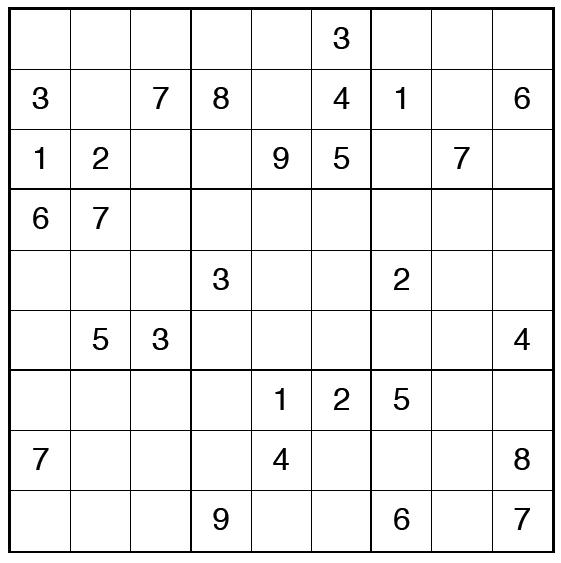
Fill in the empty fields with the numbers from 1 through 9.

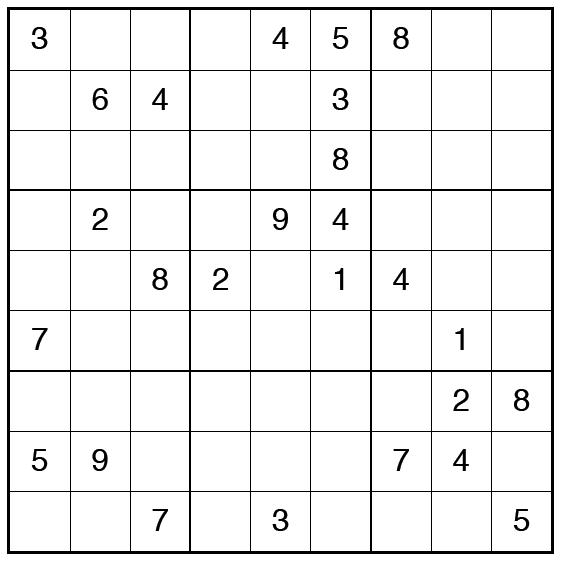
Every row must contain the numbers from 1 through 9
Every column must contain the numbers from 1 through 9

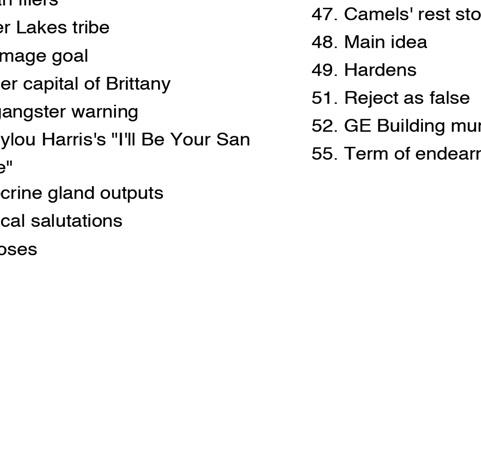
Every 3x3 square must contain the numbers from 1 through 9

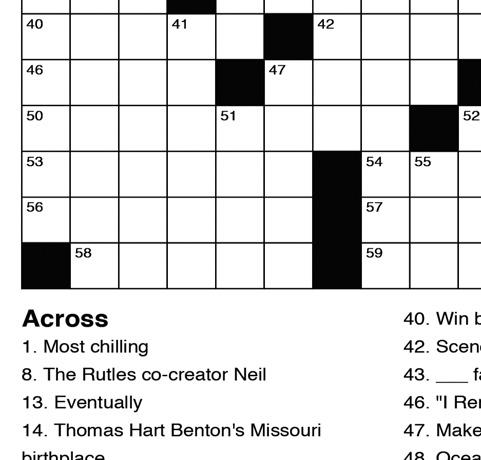



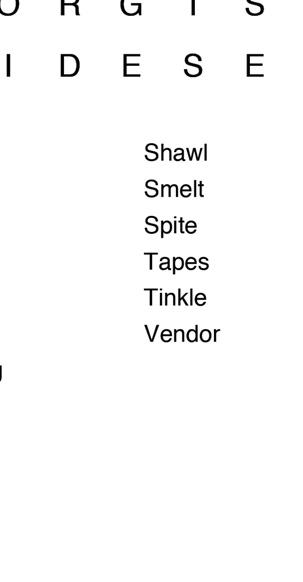
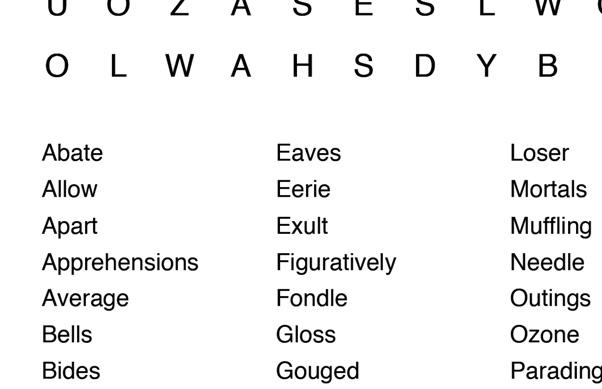

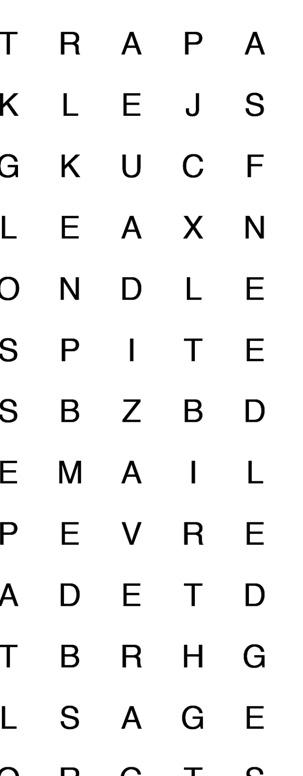
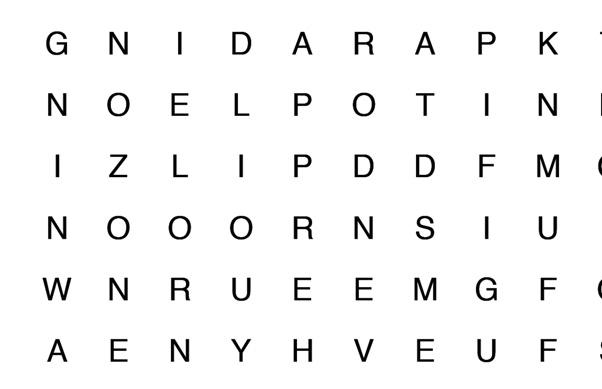
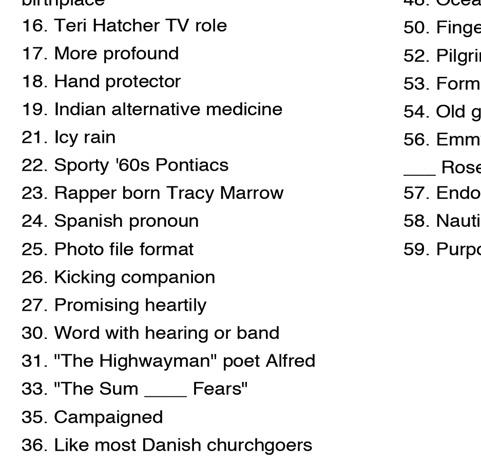

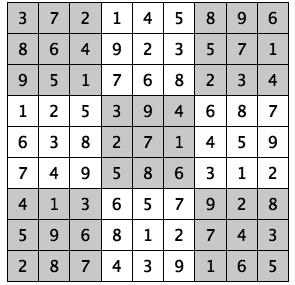
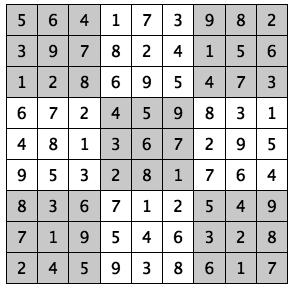
A friend or partner could be a very constructive force in your life, if you listen to their advice. Their detached perspective might allow them to see a way forward, even if you cannot. Drop your pride Aries, and see what they have to say. Plus, you may need to pace yourself, as an energy-sapping Mars/Neptune link, could mean you won’t feel so revved-up as you usually do.
It’s time to take a more thoughtful approach to health and well-being, as with sobering Saturn in the mix, the fitter you are the more successful you can be. This is also a chance to connect with an expert who could assist you with such issues as getting the perfect exercise schedule for you or making better dietary choices. You’ll realise what a fabulous investment this is for you, Taurus.
You’ll exude an air of authority that may enhance your image and impress the right people. The Sun’s positive link with Saturn, means that you’ll sound very knowledgeable on a whole range of subjects. People might seek you out for advice, especially on those subjects on which you are an expert. Your knowledge and experience can benefit you greatly today, so make full use of it.
Your perspective on a domestic issue may be more grounded and very practical. If you’ve felt all at sea, ideas and solutions can show up from today. If you aren’t certain what you should do, then speak to someone who might. Don’t feel that you have to deal with this alone. A friend or family member who’s been through a similar experience, could be your saving grace.
You’ll be the one doling out advice, or making the decision to heal a relationship that’s gone astray. The emphasis on the sign of Libra and its links, encourages you to be diplomatic, as you share words of wisdom or tactfully deal with someone’s recent outburst. You’ll know just what to say to soothe and resolve a situation, which is just as well Leo, as others may have no clue.
Feeling empowered? You’ll be ready to start on a project that you’ve been psyching yourself up for. Today’s line-up encourages you to do the groundwork, so that you can build upon a strong foundation. There’s another reason to take care, and that is because of a more distracting influence that could cause you to cut corners. Be thorough, and you’ll reap the rewards, Virgo.
With Venus in your sign opposing healer Chiron, there is no harm in admitting that you need to talk or have something you would like to share. Even if doing so makes others aware of certain weaknesses Libra, don’t let it stop you, as this could endear you to them even more. Have faith that discussing something may help find closure, so you can start to move forward.
You may not want to do something, and yet feel strongly that you should. And the more pressure you put on yourself, the less you might want to make a move. Mind, if you stop thinking and just do it, that can work too, Scorpio. The Sun’s positive angle with prudent Saturn could be a game changer in this sense. Once you commit to an idea, you’ll get it completed in no time at all.
Lunar and solar aspects can shine a light on an opportunity that allows you to try something new. It might involve a lot of work and a learning curve, but you’ll benefit from taking it on. While Neptune’s influence may encourage you to put it off until tomorrow, Saturn’s prudent energy could act as a catalyst, encouraging you to look at your options and see what you can accomplish.
You’ll make significant progress today, that you can be proud of. If a task has seemed daunting to you, who is usually so efficient, then you might surprise yourself. Still, a more nebulous influence is also on the cards. This could have the effect of leaving you indifferent to things you’re usually enthusiastic about. If you want to get ahead, you’ll need to push yourself, Capricorn.
With the Sun aligning with Saturn in your sign, the coming days can be perfect for organizing something that you fully intend to play a part in. With some focused effort you’ll have it all sewn up in no time, and ready to go. Don’t let the Mars/Neptune link knock you off course. Stick to your plan, and avoid getting caught up in distractions that could derail your chance of success
You may be on cloud nine, if it seems a dream is about to come true. With the Sun linking to Saturn, it helps to be realistic about your chances, Pisces. The advice of someone with experience could help you handle any pitfalls and emerge victorious. Still, you’ll need to be careful, as an ethereal influence can cause you to chase the wrong idea and this might waste time and energy.
